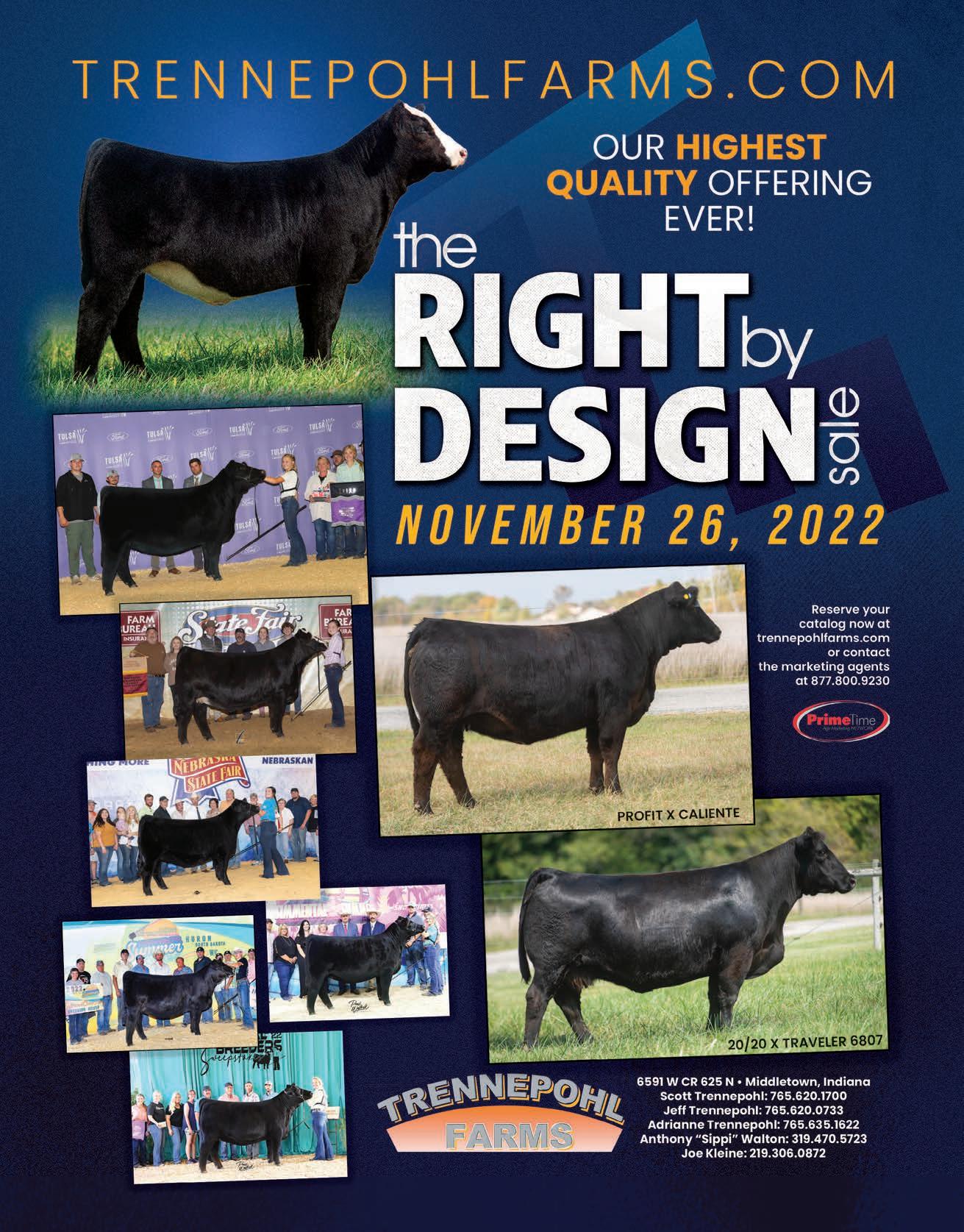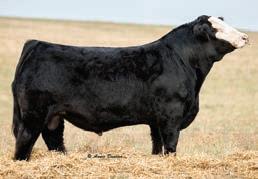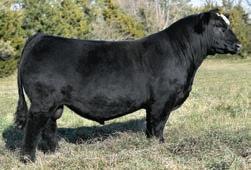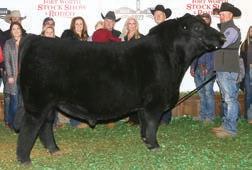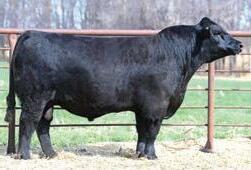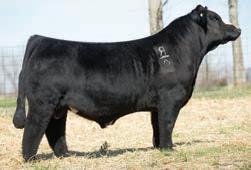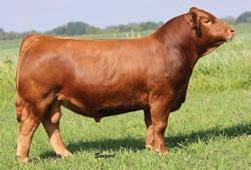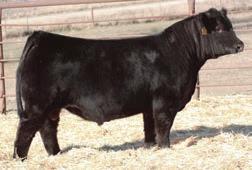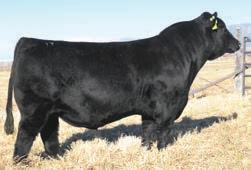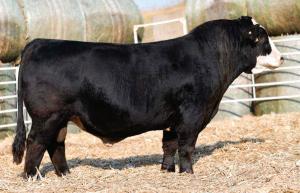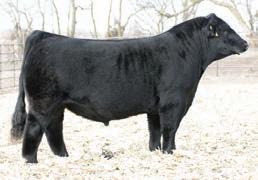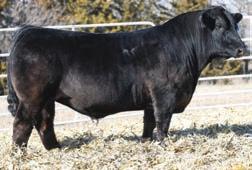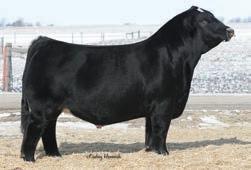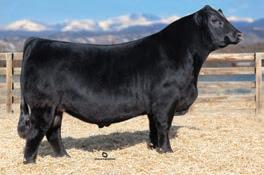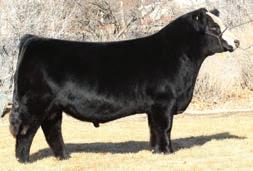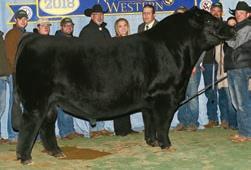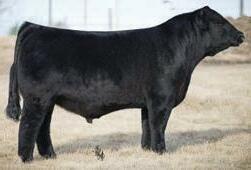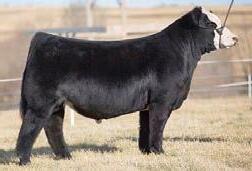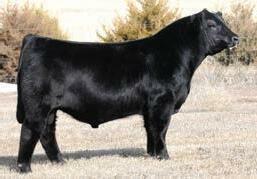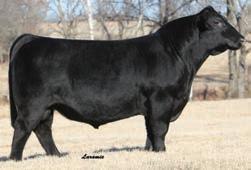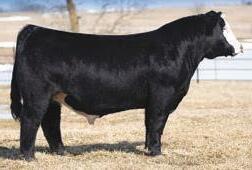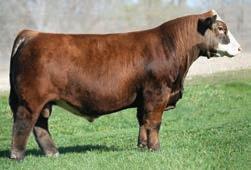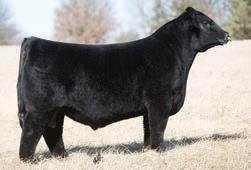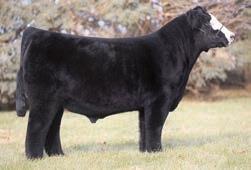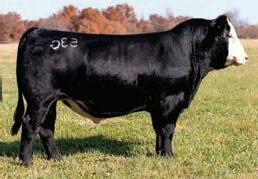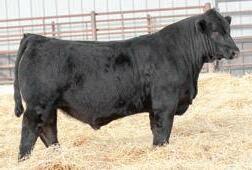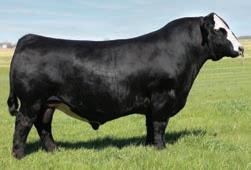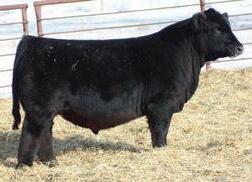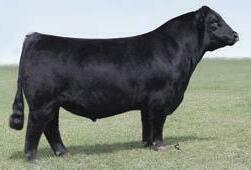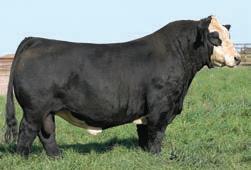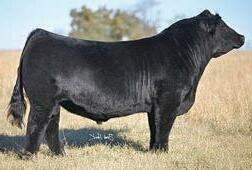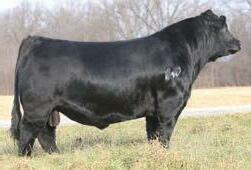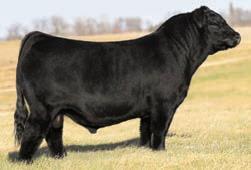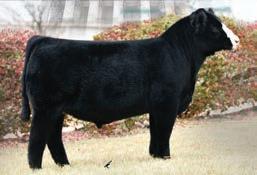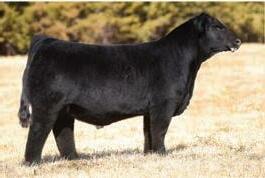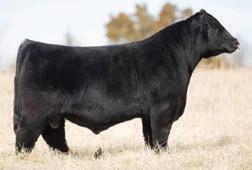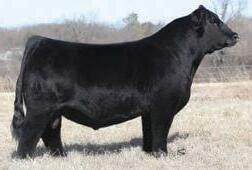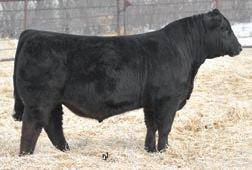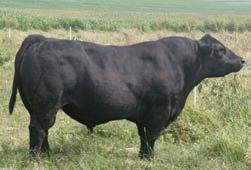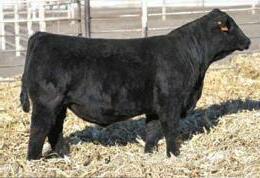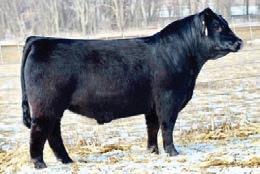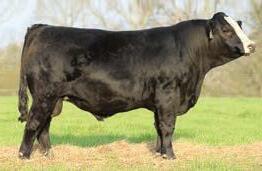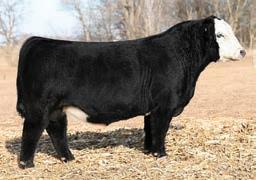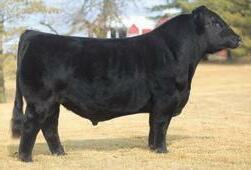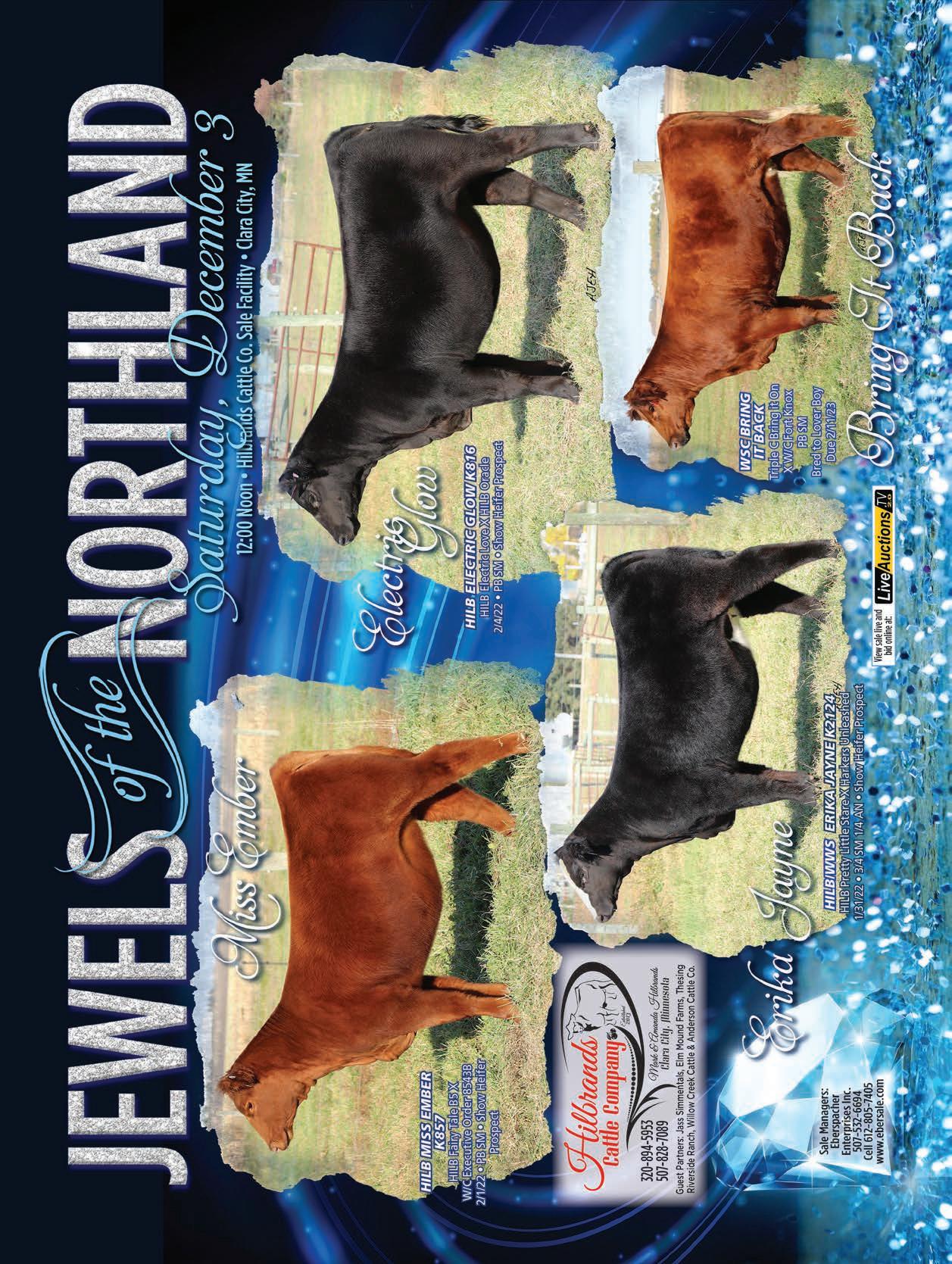






 by Lilly Platts
by Lilly Platts
For over 50 years, Martin Farms has been raising SimGenetics cattle.
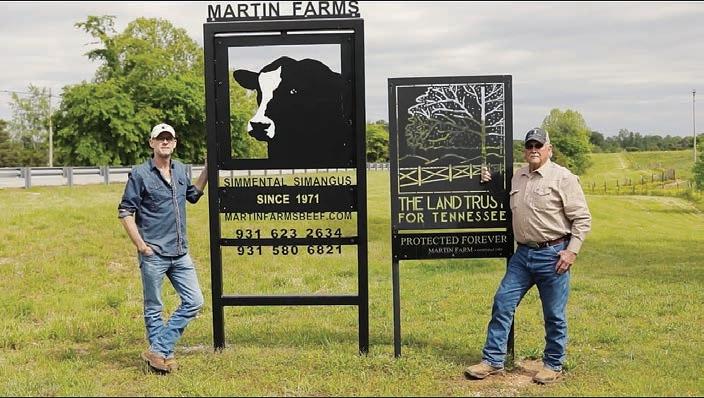
Genetic correlations use data and information across traits to improve the accuracy of the EPD estimates.


Tips for creating a legally sound farm equipment lease.
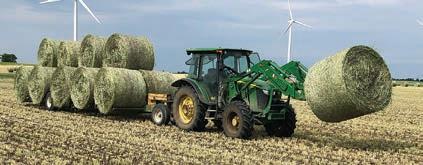
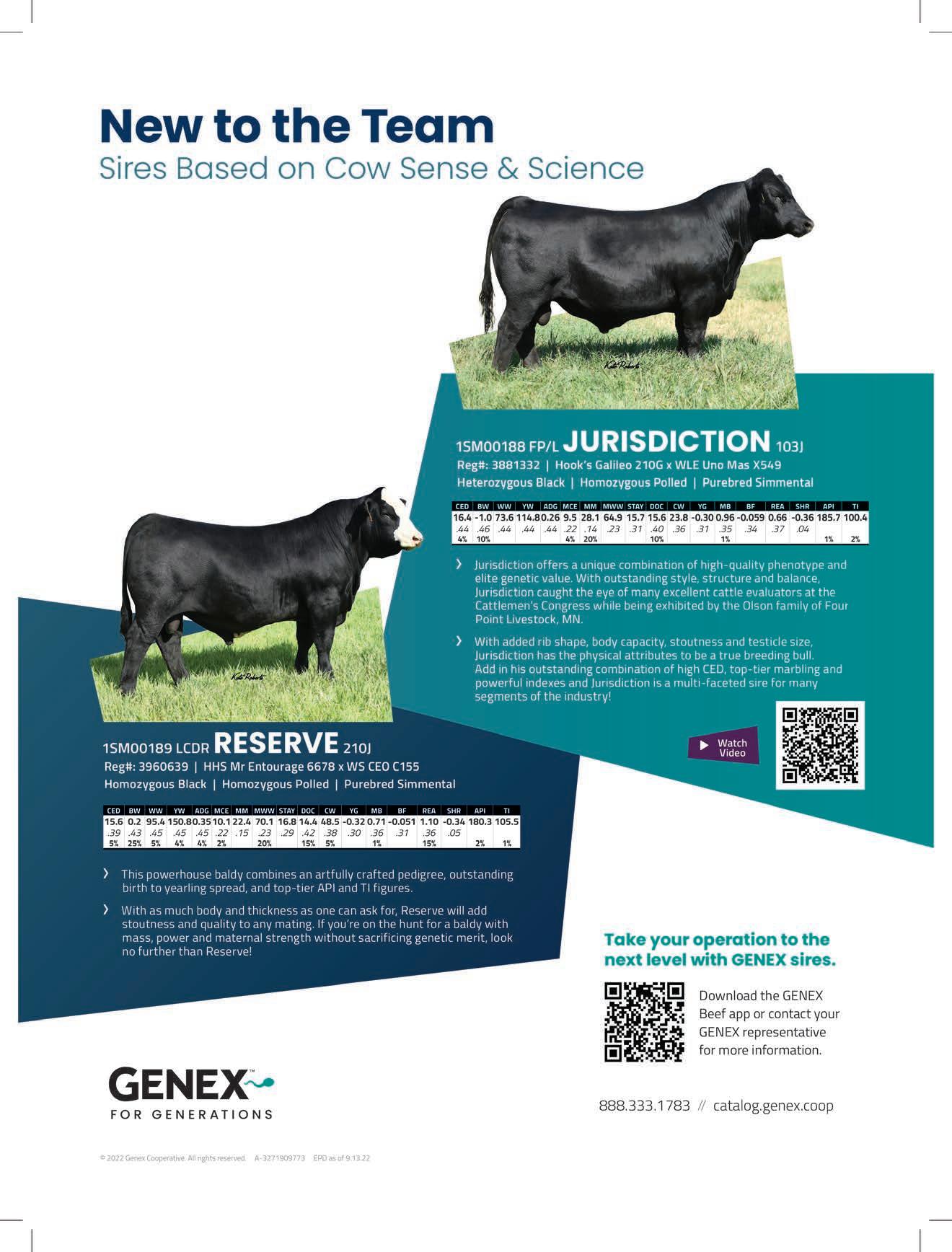
main page of the
has a new look
spotlight
industry news, and easy to navigate location for articles in a
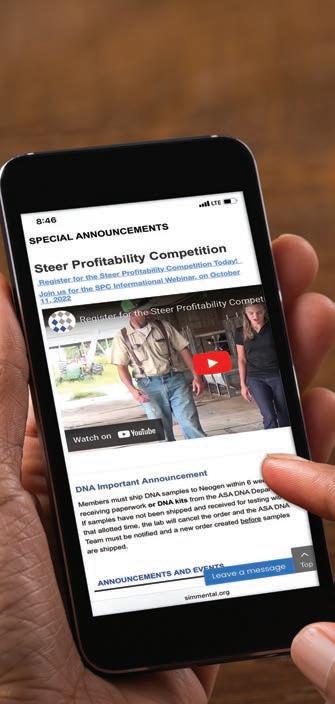
on

the Register (Issn: 0899–3572)is the official publication of the American Simmental Association, published monthly, except bimonthly, in December/January, May/June, and July/August by ASA Publication, Inc., One Genetics Way, Bozeman, Montana 59718, and is a wholly owned, for-profit subsidiary of the American Simmental Association.
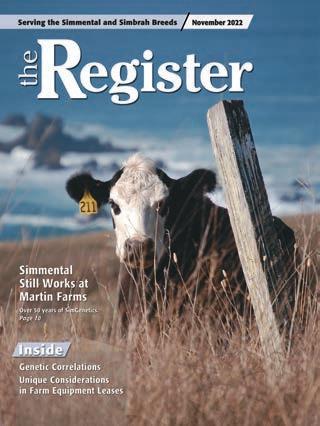

Periodicals Postage paid at Bozeman, MT, and at additional mailing offices.
Subscription Rates: $50 (US), $100 (US) First-Class, $150 (US) All International Subscriptions.
POSTMASTER: Send address changes to the Register, One Genetics Way, Bozeman, Montana 59718.

in

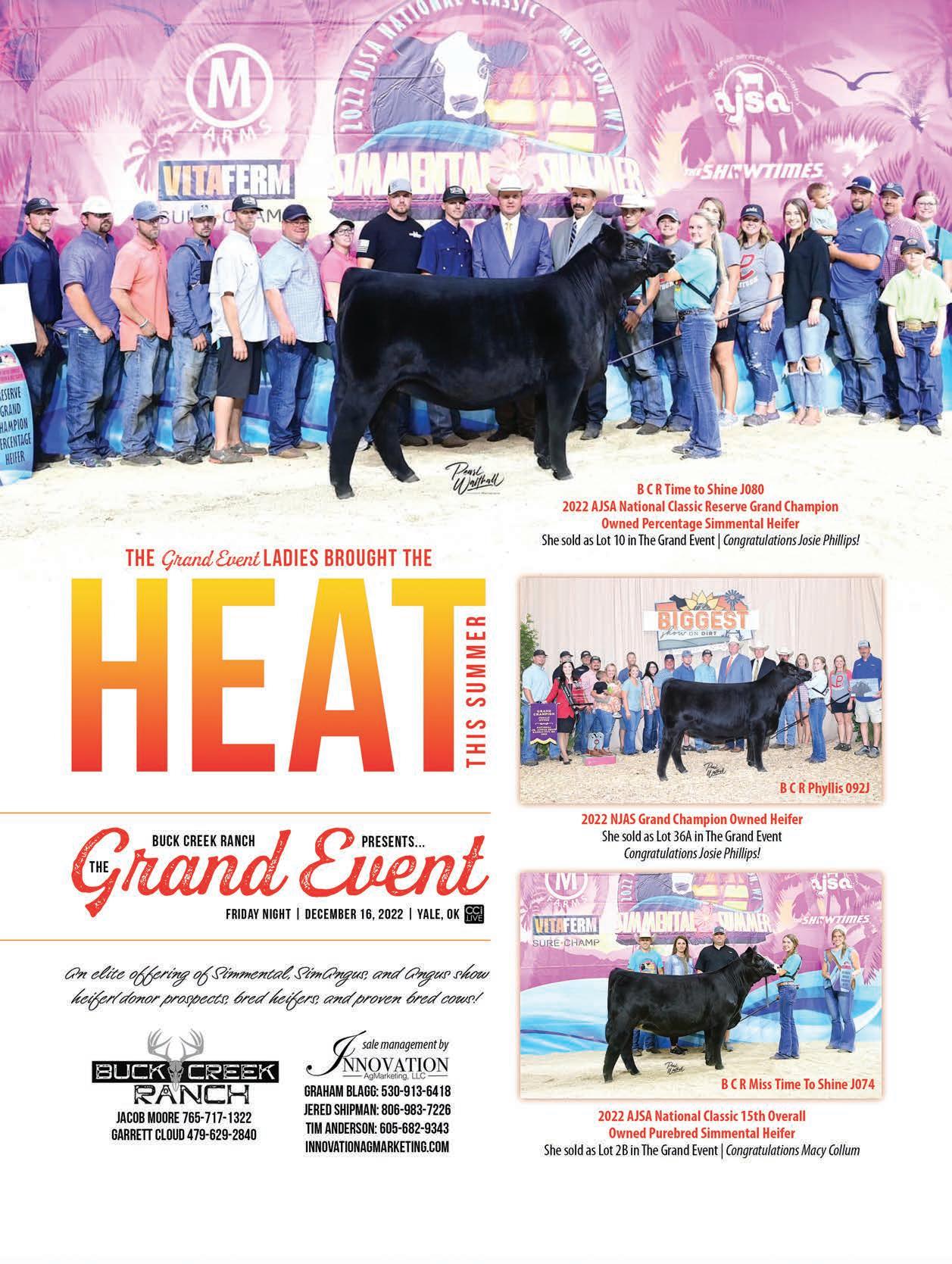
Executive Committee: Barry Wesner, Chairman Doug Parke, Vice Chairman Steve Eichacker, Treasurer Randy Moody Brandon Callis
North Central Area: Kent Brunner (2023) 3559 Upland Road Lost Springs, KS 66859 / 785.466.6475 kent@cowcampbeef.com Steve Eichacker (2023) 25446 445th Ave Salem, SD 57058 / 605.421.1152 es@triotel.net
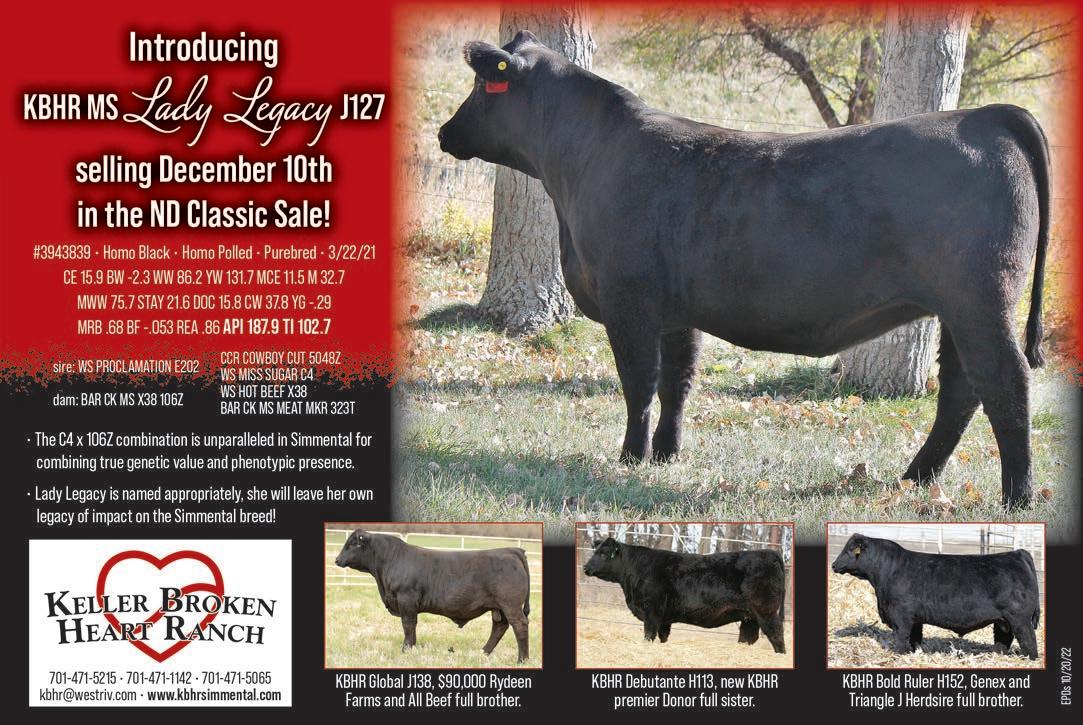
Tim Clark (2024) 1999 18th St NW Turtle Lake, ND 58575 / 701.799.7752
Tim.Clark@hubbardfeeds.com
Loren Trauernicht (2025) 901 E Pine Rd Wymore, NE 68466 / 402.230.0812 mtrauernicht@diodecom.net
Eastern Area:
Randy Moody (2023) 811 Frank Hereford Road New Market, AL 35761 / 256.655.5255 randymoody@ardmore.net
Barry Wesner (2023) 1821 W 700 S Chalmers, IN 47929 / 219.863.4744 wesnerlivestock@yahoo.com
Chris Ivie (2024) PO Box 264 Summertown, TN 38483 / 931.215.0316 iviejc@usit.net
Doug Parke (2024) 153 Bourbon Hills Dr Paris, KY 40361 / 859.421.6100 office@dpsalesllc.com
Western Area:
Tom Nelson (2023) 5831 Hwy 7 Wibaux, MT 59353 / 406.939.1252 nlcsim@midrivers.com
Chad Cook (2024) PO Box 174 Walsh, CO 81090 / 719.529.0564
bridlebitsimm@gmail.com
Maureen Mai (2025) 427 Peaceful Way Bonners Ferry, ID 83805 / 208.660.2726 rymocattle@gmail.com
Ryan Thorson (2025) 207 3rd St Glendive, MT 59330 / 406.694.3722 ryanthorson7@gmail.com
South Central Area: Dr. Gary W. Updyke (2023) 107030 S 4250 Road Checotah, OK 74426 / 918.843.3193 garyupdyke38@gmail.com
Brandon Callis (2024) 26123 State Hwy 152 Minco, OK 73059 / 979.204.1265 callissteer@yahoo.com
Victor Guerra (2024) PO Box 92 Linn, TX 78563 / 956.607.5515 vgg03@aol.com
Joseph Hensgens (2025) 136 Deer Park Ln Rayne, LA 70578 / 985.992.9119 joehensgens@yahoo.com

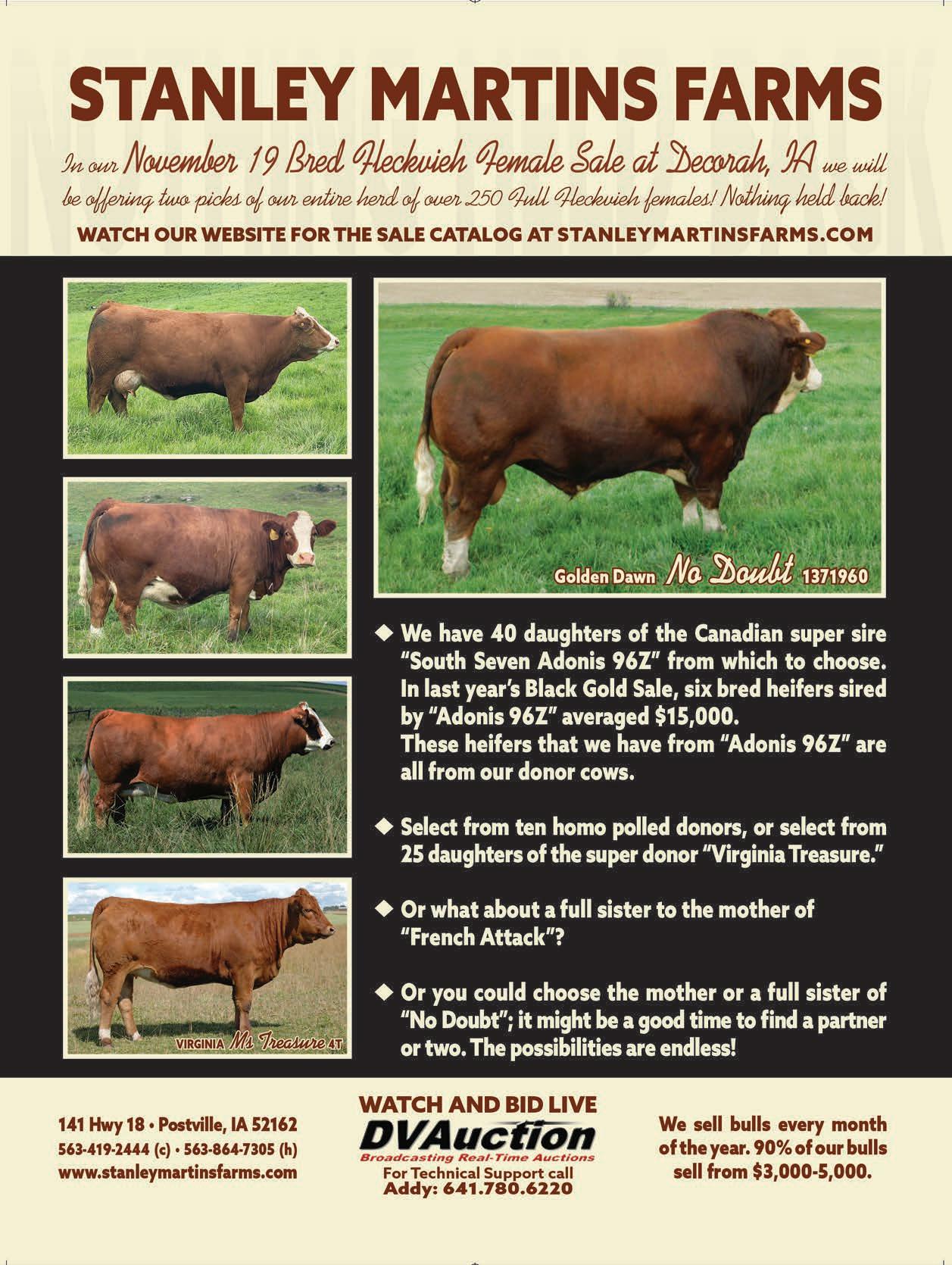
We were exhausted and worn out after a long day of moving and working cows. I was 16 with more hair and less of a clue. A very large cow herd was spread out in front of us. To the south, a large swatch of clubby producing cows. To the north, many hundreds with solid pedigree awareness, a structured breeding program, all designed to generate commercially relevant seedstock. Charles Gerloff, my boss, wrangler, and mentor, took a moment to share some wisdom with me. He pointed down towards the clubbies and said, “Those girls can make me money.” Then he motioned north to the other group. “Those girls will make me a living. Don’t you forget the difference.”
I’ve recalled this story a number of times. I was too young and too clueless to fully appreciate the depth at the time. It was such an ordinary part of the workday that I doubt Mr. Gerloff has any reason to recall the moment. But, with time and perspective, the power and insight of that simple cowboy wisdom has continued to fuel me. And, in line with his instinct and intuition, in a few years the clubbies weren’t making money and they were gone. However, those seedstock cows have blossomed into a highly appreciated Angus and SimAngus operation placing bulls into profit-conscious, commercial outfits all over Missouri. And more importantly, those cows have fueled and funded a family and multiple generations of beef producers. Mr. Gerloff was (and is) aware and grateful for what those simple, yet responsibly built, ruminants could do.
The point? Gratitude. It is hard. Cynical and sour are much easier. Pop up in the morning to your coffee and turn on one of the never-ending 24-hour news stations. Are they sharing news or are they selling outrage and angst? Swing by the house for a quick bite at lunch. I bet if you flipped on the TV, you’d likely hear something similar. Then again after dinner. And tomorrow. And the next day. Or just as scary, take a moment to scroll through social media before you call it a day. You went there for a quick “feel good” or something about a local event, but often you see agendas, aggravation, or some filtered version of a pretend life. We need a base level of “informed.” Beyond that, at least for me, some of the rest of it serves more to test how well my cardiovascular system handles higher pressures than to actually provide me input or knowledge that I can do anything about.
We are what we consume. If I take in the good and the edifying, I typically emit good. If I take in bad...you know what happens. So, at ASA we desire to communicate with you in a manner that expresses our appreciation and gratitude for you and your business. We wish to deliver good. We want to provide you meaningful, educational, empowering, and sometimes uplifting content. Whether it be print or digital or TV or a trade show, our job is to deliver.
So, my offer and my request. My offer: Here is my email, ckemp@simmgene.com. Use it. My request: Tell us what you need to learn more about to help empower your beef business and better position your family to stay in this industry. Tell us how you’d like to consume content. Is it through a magazine format, digital, etc.? Tell us what you’d like to hear less of. And why.
As Mr. Gerloff stated, there is mere “money” or there is “a living.” We are in this for the long haul. Here is to helping each other cultivate a living filled with a bit more gratitude. n


ASA’s Lane Giess, director of Commercial and Nontraditional Data Programs, and contributing authors were awarded the first place Applied Animal Science Research Award at the Western Section of the American Society of Animal Science (WSASAS) this fall. Giess, who is also a PhD student at Colorado State University, presented on his research: Genetic parameter estimates for age at first calving in Simmental and Red Angus heifers.
The Applied Animal Science Research Award at the WSASAS is a unique award with a sole purpose of recognizing research that directly benefits the livestock producer. Award winners demonstrate that their research could be readily applied to production systems, is new and innovative, and would increase the likelihood of profitable returns from livestock-based ventures. Applicants were asked to submit an abstract and supporting video on their research, which were evaluated by a committee consisting of leading industry and academic agricultural consultants, and chaired by the WSASAS Industry Representative Officer.
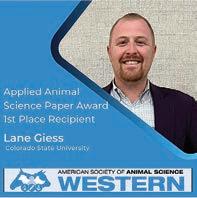
Giess’s research focuses on the development of a prototype genetic evaluation for heifer fertility that includes improved selection for earlier-calving females. Multiple univariate animal models were used to estimate genetic parameters for age at first calving in a multi-breed population of beef heifers from the International Genetic Solutions database. Genetic selection and the successful implementation of management practices that see heifers calving earlier in a calving period are associated with greater pounds of calf weaned, improved subsequent female fertility, increased female longevity, and increased lifetime profitability.
Giess was also a contributing author on the third place WSASAS Applied Animal Science Research Award, where Miranda Zuvich was recognized for her research: Evaluating repeatability and scorer differences when assigning feet and leg scores in Simmental heifers.

Zuvich, an undergraduate researcher at Colorado State University, is investigating best practices for feet and leg scoring in beef cattle using the American Simmental Association’s feet and leg scores database.


Awards were presented at the 2022 WSASAS section meeting in Park City, Utah, on September 22.
Dr. Doug Parrett, a retired animal science professor at the University of Illinois, passed away on August 26 at the age of 71. During his career, Parrett served as a faculty member, a livestock judging coach, extension specialist, research collaborator, and interim department head. Over his 49-year career, Parrett had several connections to the American Simmental Association, contributing articles to the Register and SimTalk, serving as a guest speaker at ASA meetings, assisting with Regional and National Classics, and as a technical advisor. n
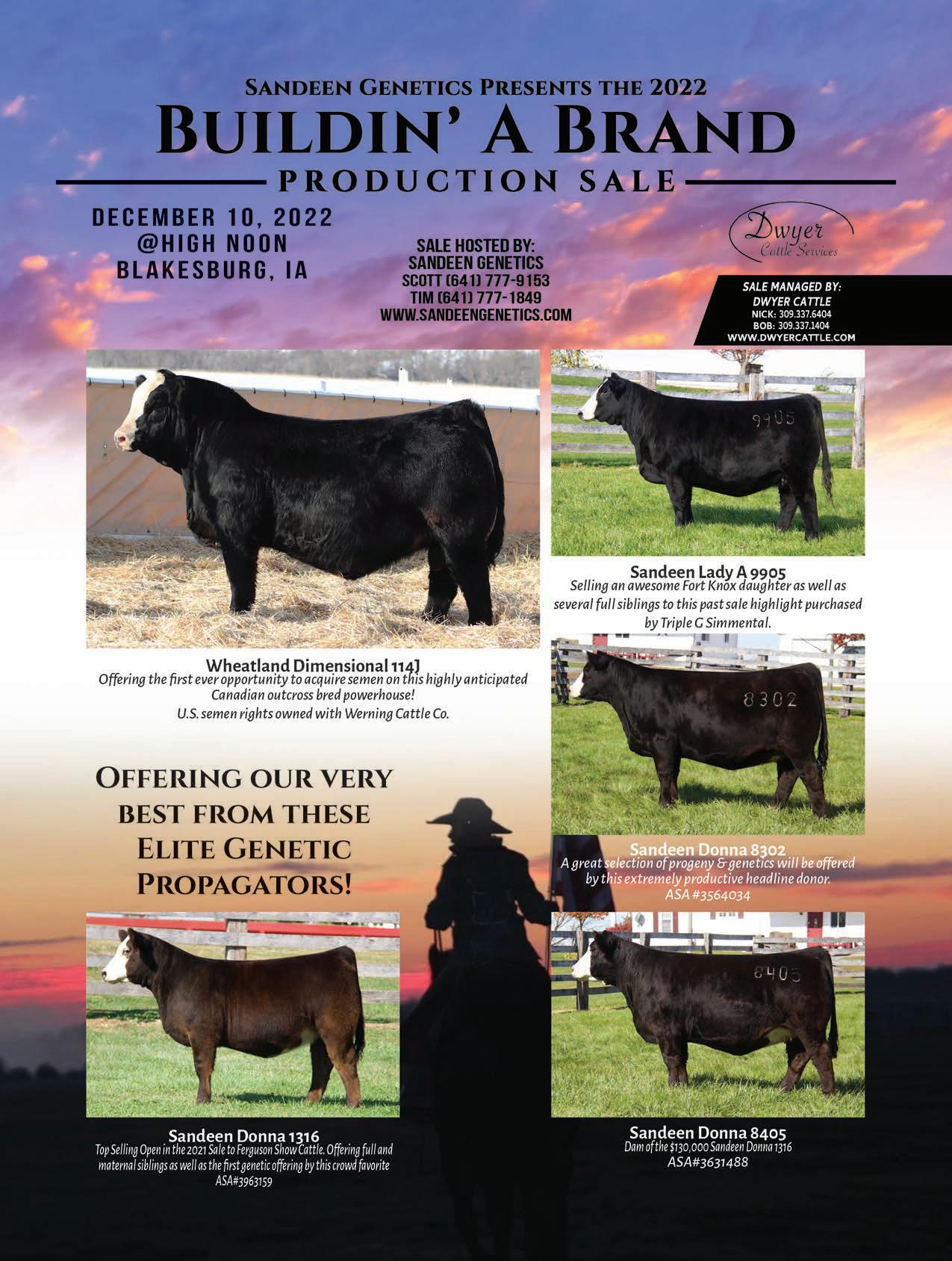

at Martin Farms
by Lilly PlattsMartin Farms, Lyles, Tennessee, has been in the Simmental business since 1971. With a focus on providing outstanding customer service and raising cattle with soundness, good disposition, fertility, and carcass potential, the operation has stood the test of time.

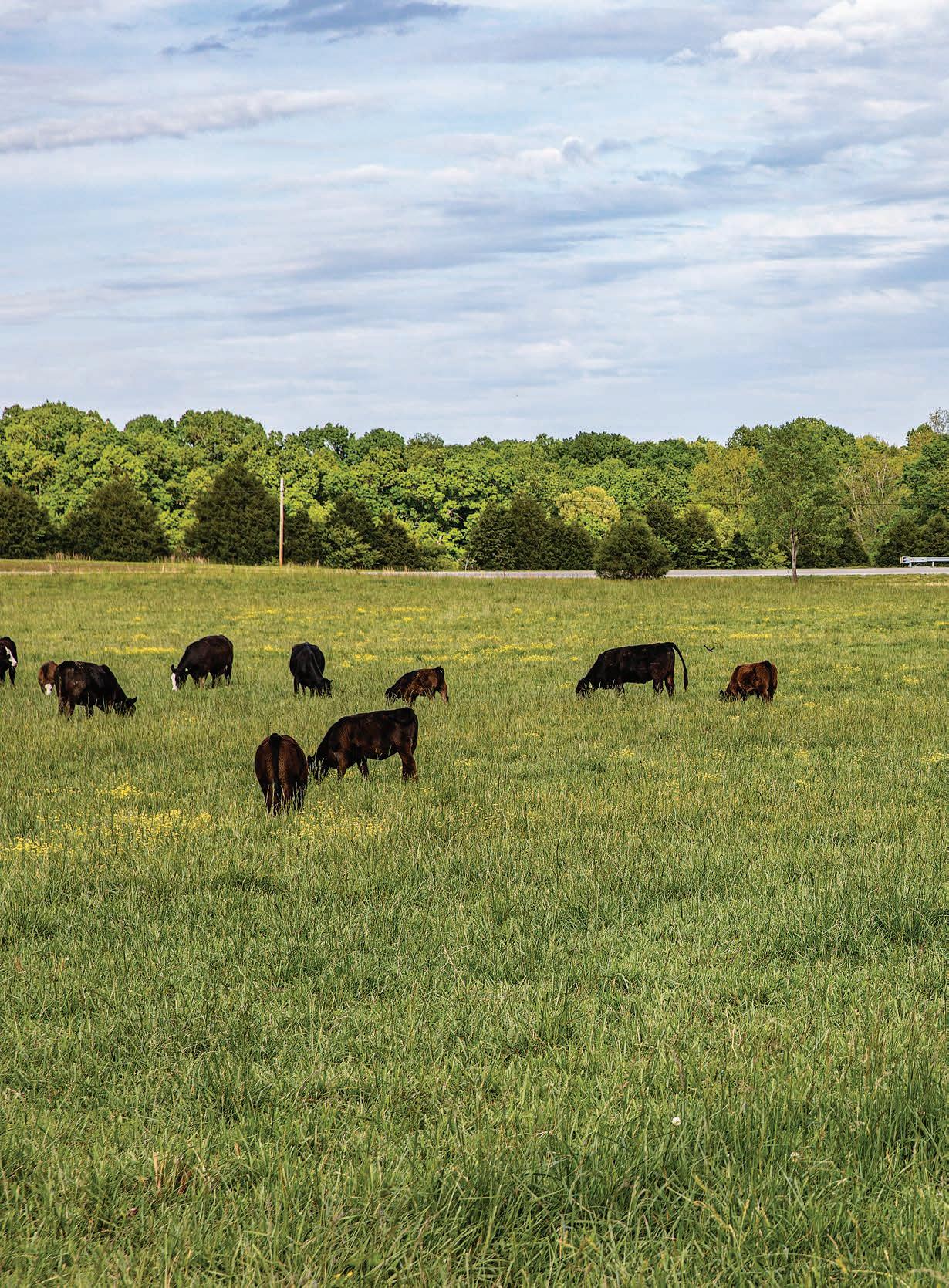
Neil Martin is the third generation on the farm, which is over 100 years old. His son, Chris, now represents the fourth generation to live and work on the Hickman County family operation. Neil’s grandfather purchased the farm from his brother in 1912, adding a kitchen and bathroom to the original house. Neil’s father continued to farm, partnering with his brother to buy the operation in 1943. Neil followed in these footsteps, buying his uncle’s share of the farm in 1961, purchasing half-interest in the farming operation, livestock, hogs, equipment, country store, and house.
The Simmental breed first appeared at Martin Farms in 1971. Neil recalls AI’ing their commercial herd to a number of breeds, including Polled Hereford, Limousin, and Simmental. “From those matings, Simmental was way ahead of the others so we focused on it from then on,” he said.
Chris was given his first Simmental heifer at eight years old, which sparked his interest in the cow herd. Today, the father–son team continues the family business, with a focus on raising top-quality SimGenetics seedstock.

Since the first Simmental female landed at Martin Farms in 1971 many things have changed, but the Martin family has continued to focus on Simmental genetics. Today, SimAngus is also part of their offering. Martin Farms holds an annual sale the last Saturday of September, sells seedstock by private treaty, and is also a part of the Tennessee Seedstock Connection. By offering balance and consistency they have built a strong customer base.
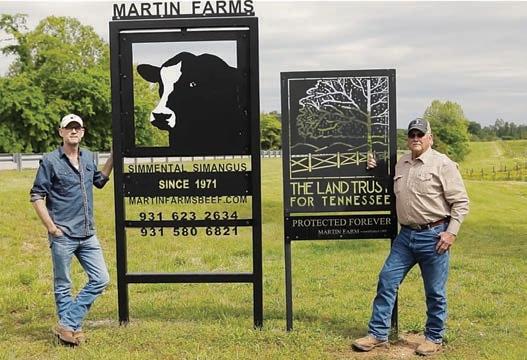
With 50 years of experience in the Simmental business under his belt, Neil has seen many changes and endured the highs and lows of the industry. Maintaining balance and not chasing extremes have helped Martin Farms ride out these changes. Chris said, “My dad believed in not going to the extremes in the cow herd, and in cow size. They kept birth weight down and paid attention to those traits all along. I think our customers know that our cattle will work, which helps with marketing. A lot of it is just the reputation of the breed in general, and our reputation, which we have built over the last 50 years.”
Angus was added to the operation because of the complementary nature of the two breeds. Neil explained,
“The thing that makes Simmental and Angus such complementary breeds to one another is the bone structure and udder quality of Simmental, as well as milk production. Simmental generally has more milk than Angus, but Angus has the carcass qualities that complement Simmental. Both breeds grow well and are accepted in the industry.”
This focus on balance is present in all genetic decisions at Martin Farms. Chris explained, “When we’re choosing sires we look for overall balance. Soundness is one of the most important things too — we want them to be soundstructured and sound-moving. Growth performance is certainly something we look for, but we couple that with calving ease, maternal traits, and carcass traits. We try to balance the traits that are antagonistic to one another, making sure we don’t go too far in one direction. It’s really all about balance.”
Many of their customers run commercial females. Simmental and SimAngus genetics offer the growth that many of these producers are looking for. “The Simmental

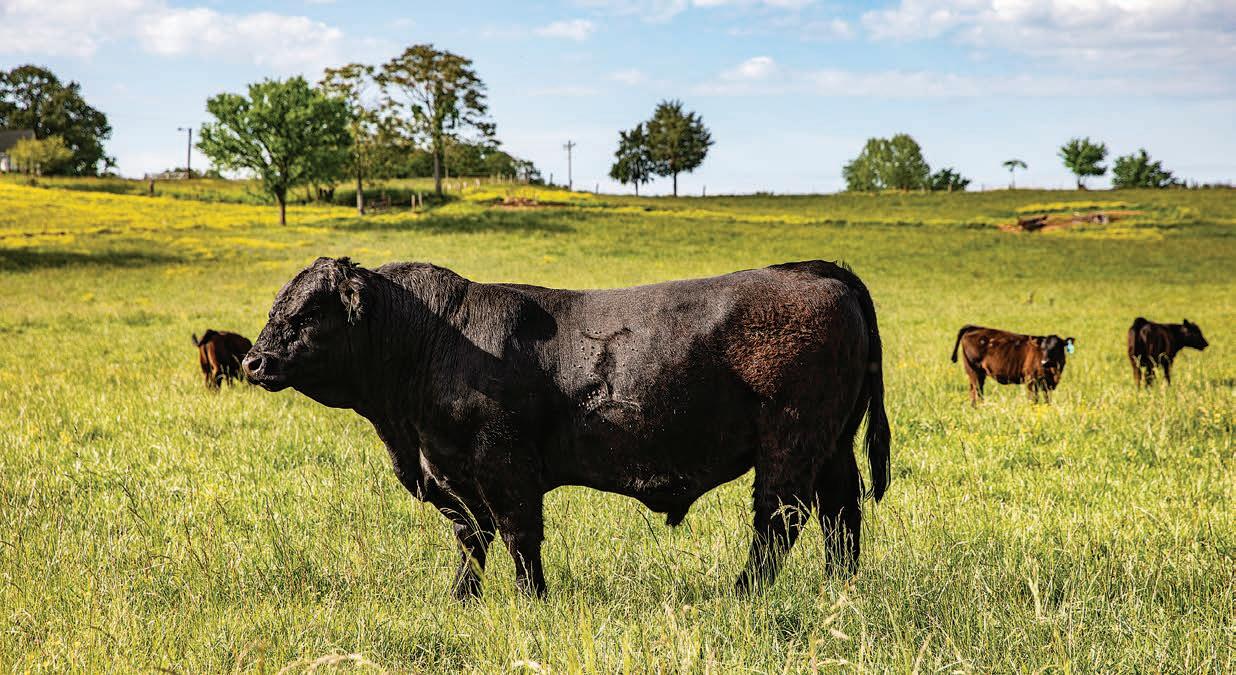
from
breed, being Continental, offers more growth and performance, and you also get hybrid vigor with crossbreeding,” Chris said. “I try to visit with our bull customers about their cow herd and calf crop so they get some performance and hybrid vigor.”
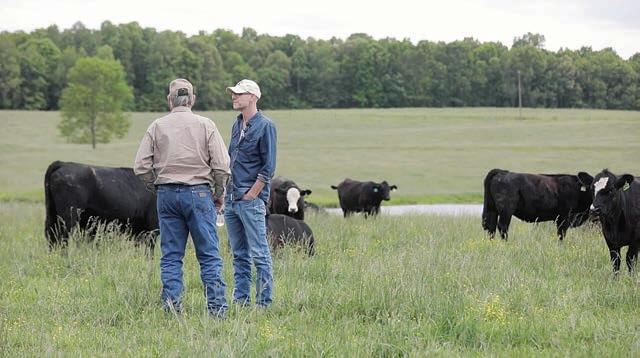
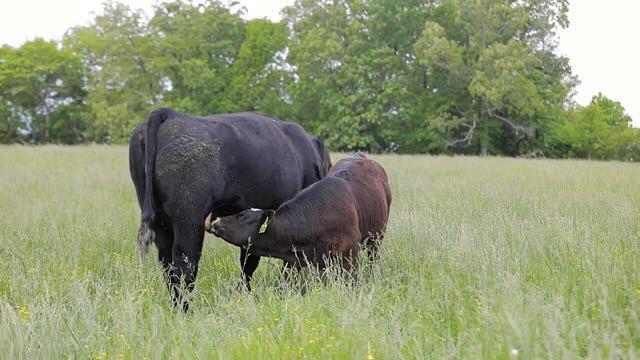
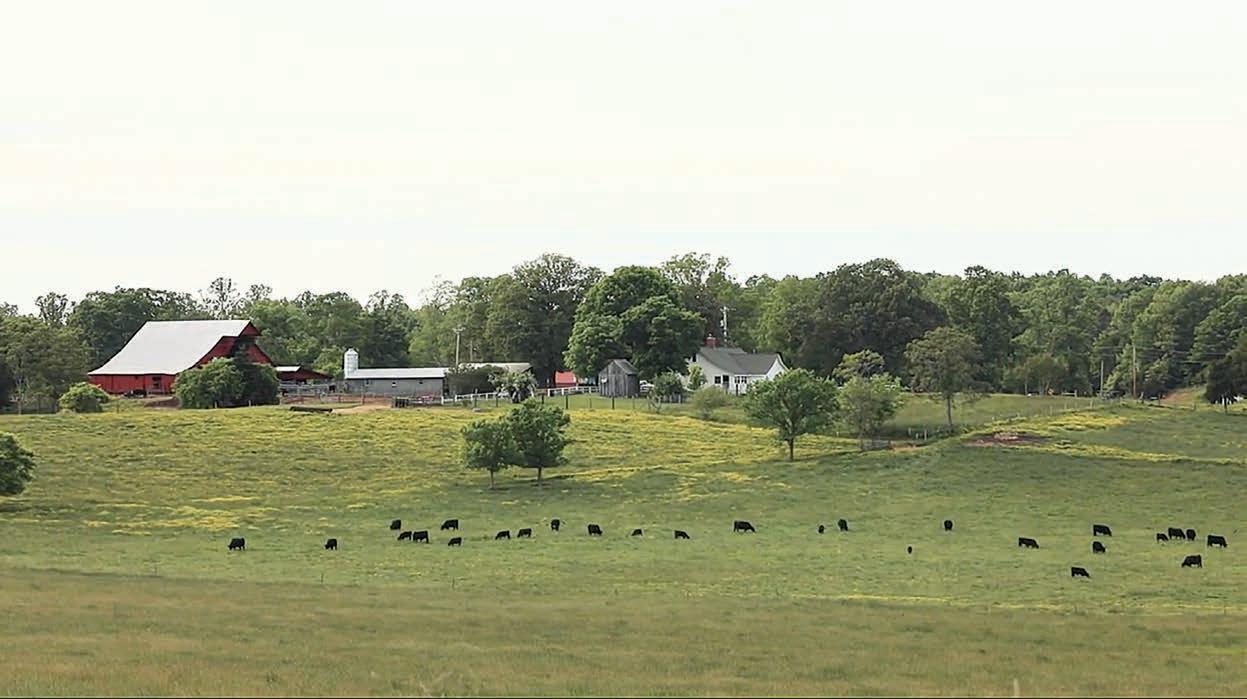
Neil echoed these comments. “I think Simmental plays a big role in the commercial industry because if you have mixed commercial cows, which may be of various breeds, and put a Simmental or SimAngus bull with those cows you can expect more pounds at weaning time and you can expect to be at the top of the market when you go to feeder calf sales. Those cattle go to the feedlot and perform and grade well on the rail.”
Chris explained that data collection backs this performance. “The Simmental breed was established on performance data. A big part of the success of the Association, and our operation, has been collecting the data and doing so in a non-biased way. We can compare real performance data, and take that information in to help our bull customers make the best decisions. If we don’t have that information — if we don’t collect birth, yearling, or weaning weights, or skew it because we favor one calf over another — that information is lost.”
Neil and Chris are both extremely proud of their family history, and are driven to continue caring for the land and livestock. Staying abreast of changes, across the industry and within the breed, has made Martin Farms successful. Chris plans to continue this. “I want us to be moving in the right direction. We have to stay focused on the kind of cattle we want to produce, and the reason we want to produce those cattle. Staying in the middle of the road is a big deal,” he said.
“I think one thing that has kept us in the Simmental business for 50 years is our love for it,” Neil shared. “I love the business. My father and my grandfathers on both sides of my family were farmers and cattle people who tended the soil. I have a love of the land and an appreciation for everything that it is. That’s what sustains me.”
Chis is proud to carry this tradition on. “Being the fourth generation here and knowing that my great-grandfather farmed this ground where I’m standing — he ran cows here and farmed corn — it makes me feel rooted. It makes me feel like I belong here and that’s just a good feeling.” n
L: Father–son team Neil and Chris Martin share responsibilities on the family farm. R: Tennessee’s long growing season and adequate rainfall makes it a productive place to run cattle.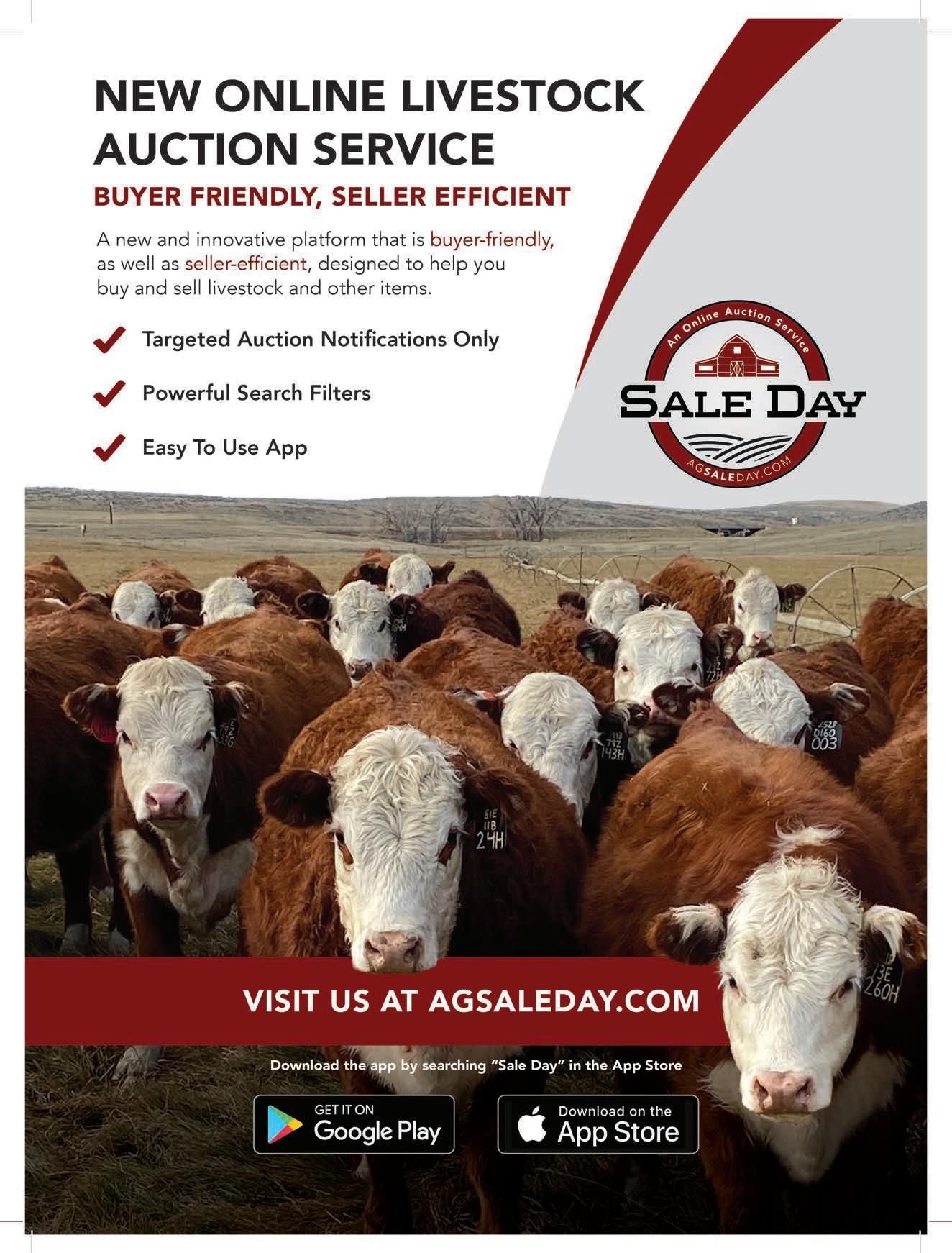
Genetic correlation may not be a term that is commonly used, but it is an important one when it comes to genetic evaluations and understanding EPD results. Genetic correlations play the role of using information from one trait to predict the performance in another trait. Within seedstock production there are many examples of genetic correlations in practice.
Genetic correlations allow for the measurement of indicator traits that may not have been able to be recorded on an animal. An example of this is the use of ultrasound data on seedstock animals to help predict differences in carcass performance. While it may be obvious, this technology is important to be able to gather information on animals to help predict genetic differences. There are other instances where this approach has also been taken. There are many people who look at birth weight information to help predict calving ease. While the birth weight of an animal is a valuable indicator of calving ease, it does not perfectly predict this outcome.
From a genetic evaluation perspective, genetic correlations are leveraged in the evaluation to improve the accuracy of the prediction of the trait. Almost all EPD calculations are performed using multiple trait models, which means that information from multiple traits is used simultaneously in the evaluation to boost the accuracy for each of the traits included. Take, for example, the growth trait genetic evaluation. This includes data for birth weight, weaning weight, and post-weaning gain. All of these traits are included in the model, and the EPD that are calculated are Birth Weight, Weaning Weight, Yearling Weight, Average Daily Gain, and Milk. The reason that these traits can be combined is that there are genetic relationships among the traits. Another way to think about this is that calves that tend to be heavier at birth are heavier at weaning. This is due to the fact that some of the underlying genes that influence an animal’s birth weight can also influence the resulting weaning weight of an animal. The percentage of genes that are common to both traits can be expressed as the genetic correlation between those traits. So, the stronger the relationship, the more genes that are shared and vice versa.
Correlations can be classified based on the strength of the relationship. Generally, genetic correlations are considered high if they are 0.50 or above, moderate if they are 0.20 to 0.40, and low if they are below 0.20. While these aren’t considered a rule, looking at the strength of the relationship can help to determine if selection for one trait may cause a change in another trait. An example of this is the relationship between selection for growth traits and for intake in animals. The correlations between different measurements of growth and intake are strong
in nature. Therefore, when additional growth in performance is selected, we would also expect the amount of feed intake to also increase on that animal.
A similar example can be applied to mature cow size and early-in-life growth rates. Both of these examples are known as genetic antagonisms because a favorable result of selection in one trait (increased growth rate) leads to an unfavorable outcome in another trait (increased intake and larger mature size), which needs to be considered when making these decisions. However, there are also favorable genetic relationships that are selected. An example of this would be where the selection for reduced birth weight results in an increase in calving ease. Depending on the trait of interest, selection for one trait could result in changes in a second trait.
Table 1 lists genetic correlations between different traits included in the current genetic evaluations.
Calving Ease and Birth Weight 0.82
Birth Weight and Weaning Weight 0.49 Birth Weight and Post-Weaning Gain 0.32 Weaning Weight and Post-Weaning Gain 0.51
Weaning Weight and Carcass Weight 0.50
Weaning Weight and Ribeye Area 0.40 Post-Weaning Gain and Carcass Weight 0.55 Post-Weaning Gain and Ribeye Area 0.32 Ultrasound Ribeye Area and Carcass Ribeye Area 0.52
Carcass Weight and Ribeye Area 0.53 Marbling and Intramuscular Fat 0.77 Marbling and Backfat 0.26 Backfat and Ultrasound Backfat 0.45
Table 1. List of genetic correlations included in genetic evaluations.
While the above correlations are not the full list, they do represent some of the more common ones that are included in genetic evaluations and used for the current genetic evaluations for calculation of EPD. Ultimately, these help to use data and information across traits to improve the accuracy of the EPD estimates. n

Ryan Boldt is currently director of Breed Improvement for the Red Angus Association of America. He resides just outside of Denver, Colorado. Boldt has received degrees in Animal Science from Texas Tech University and Colorado State University.

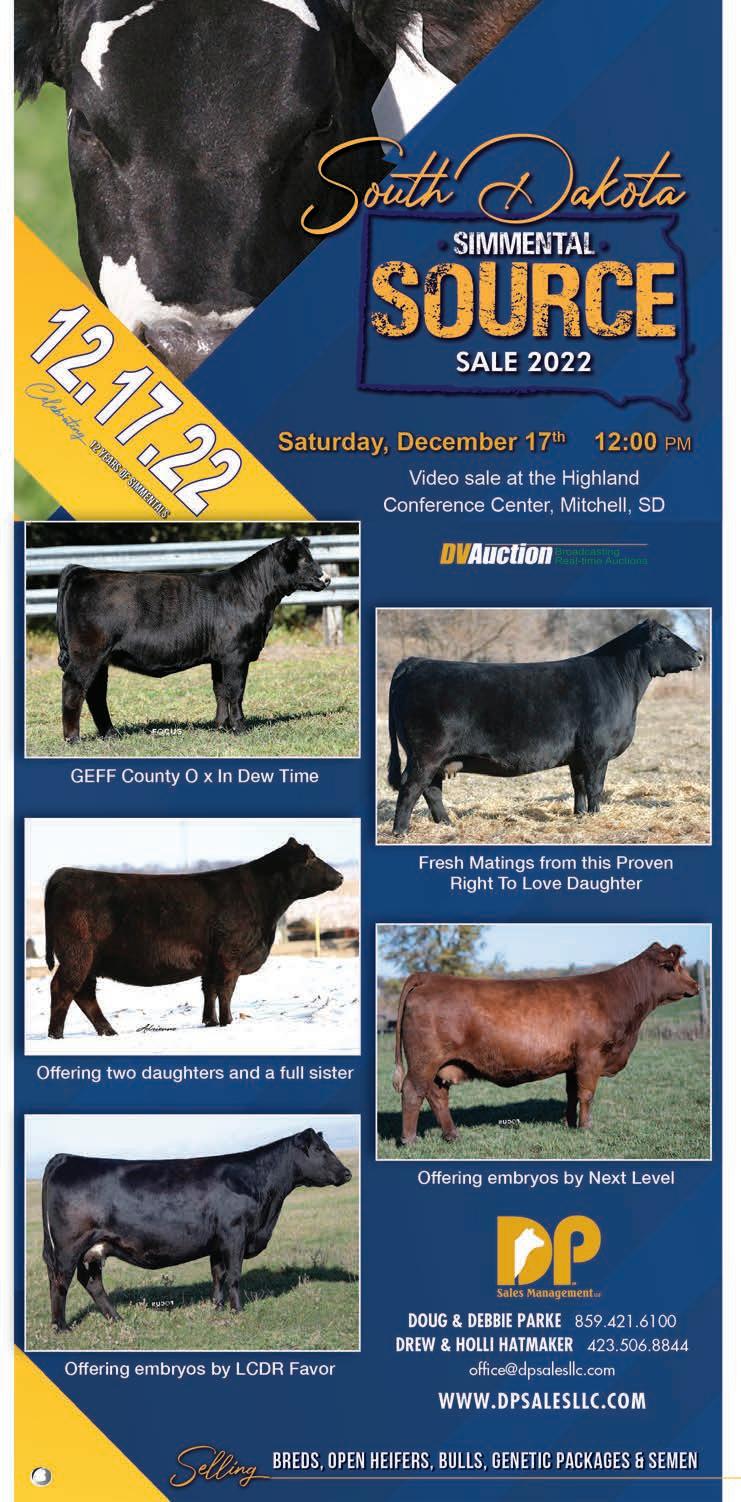

Visit event websites for show schedules.
American Royal October 2022 www.americanroyal.com
Note: This is the National Show for the 2022-2023 show season
North American International Livestock Exposition November 2022 www.livestockexpo.org
Cattlemen’s Congress January 2023 www.cattlemenscongress.com
National Western Stock Show January 2023 www.nationalwestern.com
Fort Worth Stock Show January 2023 www.fwssr.com
The American Simmental Association is proud to sanction high-quality Purebred Simmental, Percentage Simmental and Simbrah Progress Through Performance (PTP) shows throughout the country. The PTP program is designed to promote multi-level progress within the SimGenetics industry. PTP shows effectively combine the assessment of statistical data, such as EPD and actual measurements, with traditional phenotype evaluation.
PTP approved judges have been deemed as respectable and knowledgeable cattle evaluators by the ASA Board of Trustees Activities & Events (A&E) Committee. View the PTP approved judges list at: www.simmental.org.
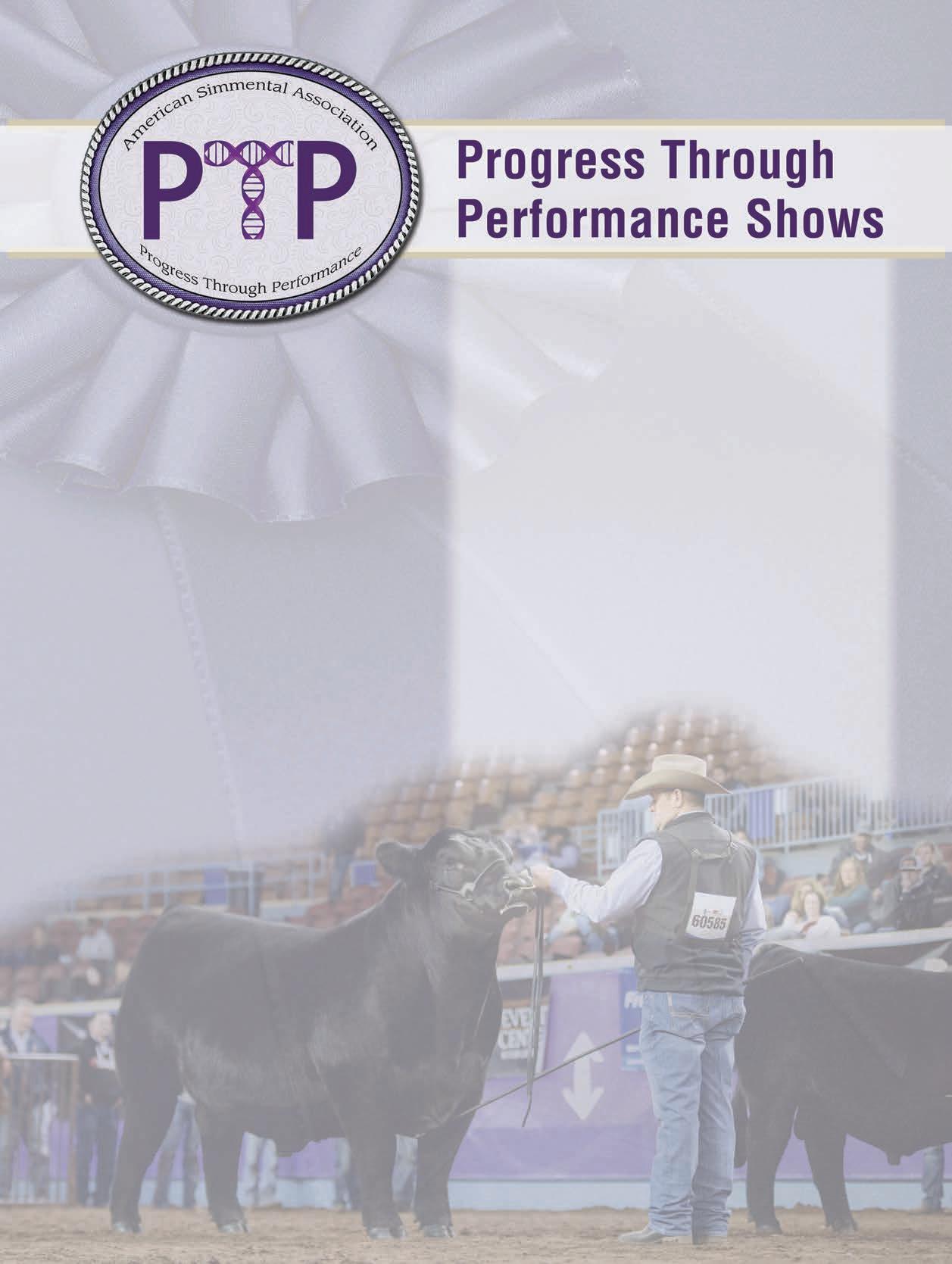
Only the Major PTP Shows involved in the National Show rotation are eligible for ASA PTP RING OF CHAMPIONS 2022-2023.
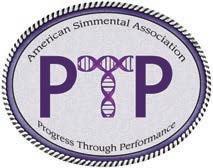
Shows include: 2022American Royal
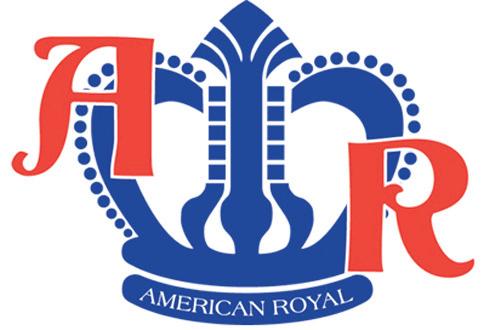
2022North American International Livestock Exposition
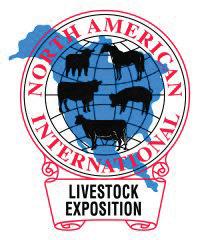
2023Cattlemen’s Congress
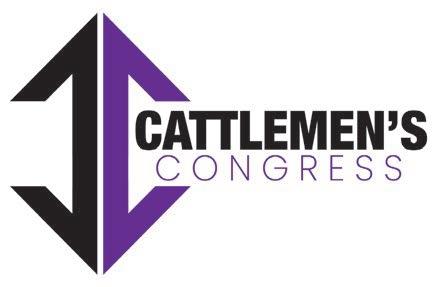
2023National Western Stock Show 2023Fort Worth Stock Show
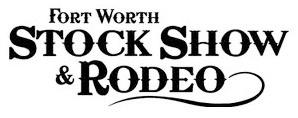


Purebred Simmental Female of the Year
Purebred Simmental Bull of the Year
Percentage Simmental Female of the Year
Percentage Simmental Bull of the Year
People’s Choice Female of the Year
People’s Choice Bull of the Year
Exhibitors must be active members in good standing with the American Simmental Association
Purebred Simmental: 7/8 Simmental and up
Percentage Simmental: at least 1/2 Simmental, but less than 7/8 Simmental
Animals and their exhibitors must abide by the rules of the show(s) in which they participate
All ASA Ring of Champions award winners must at a minimum complete an ultra-low density DNA test before awards are given
Every farm relies heavily on the availability and affordability of appropriate farm equipment. While it may be ideal to own outright any farm equipment that you need, sometimes it is more cost-effective to lease the equipment. When such is the case, the lease arrangement between the owner (lessor) of the farm equipment, and the renter (lessee) of the farm equipment, should be documented in detail in a written farm equipment lease agreement. While farm equipment leases may seem to be a simple concept, in practice they are far more complex. This article discusses six critical issues that a properly drafted farm equipment lease agreement should address.
When it comes to lease agreements it is always best to describe the terms in as much detail as possible so that future disputes can be avoided. This is true when it comes to describing the farm equipment that the lease will cover. The lease should describe the type, make, model, size, condition, and estimated value of each piece of equipment. If the lease involves a large amount of equipment, it may be best to attach an exhibit or addendum that lists the relevant information for each piece of equipment, rather than including the unwieldy information in the body of the agreement.
While most of us are familiar with a lease model that charges a renter based on a unit of time (for example, monthly rent or annual rent), farm equipment lease agreements do not always do this. Because farm equipment depreciates in value with use, it can make more sense for a farm equipment lease to charge the renter on a “per use” model. “Per use” rent means that the renter pays the owner an agreed-upon rate based on a unit of measurement of use, such as the hourly use or the per-acre use of the equipment. Note that an equipment lease that includes several different types of equipment with different estimated total values may charge different “per use” rates per type of equipment.
There are a few considerations to keep in mind when determining whether a farm equipment lease should employ either a time-based or a “per use” model for rent. A “per use” model requires the accurate and honest documentation of the renter’s use of the equipment, whereas
a time-based model requires no such documentation. Moreover, a time-based model usually guarantees a regular and predictable rent income for the owner of the farm equipment, while a “per use” model often requires that the rent will be due at the end of a lease term. The owner may not be able to accurately predict rent income under a “per use” model.
If the parties to a farm equipment lease agree that a time-based rent model best suits their needs, but equipment depreciation is still a concern, a hybrid approach may be appropriate. In a hybrid rent approach, the renter pays the owner monthly or annual rent, but the lease contains a “maximum use” provision wherein the renter will owe the owner additional “per use” rent at the end of the lease term if the renter exceeds a certain predetermined amount of use of the farm equipment.
A farm equipment owner will want to ensure that the renter agrees to use the equipment in a way that avoids equipment damage, excessive depreciation, or personal injury. Accordingly, the lease agreement should include terms that restrict unwarranted use. For example, the lease may specify that the farm equipment may be used for agricultural and related purposes only. It may also limit the use to certain geographic locations and certain permitted users (such as the renter and his or her trained agents and employees). The lease may also require that the renter follow certain specified safe operating procedures, as well as any applicable state and federal laws, manufacturer warranties, and insurance restrictions.
A farm lease agreement should clearly delineate which party is responsible for both routine and non-routine repairs or replacement of the farm equipment. While the parties can agree on any division of labor they like, a common default is that the renter will be responsible for the proper care and ordinary maintenance of the farm machinery. This may include routine damage checks, fluid checks and refills, routine cleaning, and safe storage. On the other hand, the owner may be responsible for the costs of all major repairs to the farm equipment, such as the replacement of tires and other major parts, or any other overhauls in excess of normal maintenance. The parties should specify in the lease agreement who is
responsible for the costs of transporting the farm equipment to the location where any such repairs are performed. While the renter may be held responsible for damages caused by his or her misuse of the farm equipment, the lease agreement should address which party is required to replace any equipment that is nonfunctional due to circumstances outside of the renter’s control, such as fire, flood, or machinery or electrical failure. If it is the owner’s responsibility to replace the equipment under such circumstances, and he or she does not do so in a timely manner, the lease may include a potential adjustment in rent for the renter.
Farm equipment is expensive machinery that is often insured. The lease agreement should clearly define which party is responsible for insuring such equipment. Often the owner will fully insure the equipment against casualty, theft or other loss, damage from natural causes, or against personal liability. Meanwhile, the renter may be asked to provide proof of a general liability insurance policy adequate to compensate for any loss caused while operating the farm equipment.

While it is important that a farm equipment lease agreement be mutually beneficial, there are certain provisions and precautions that each party may wish to pay special attention to. For example, the owner — or lessor — may consider including a clause that preserves his or her right to access the equipment during the lease for any foreseeable need. The owner may also take extra care to ensure that the clauses concerning the renter’s care of the farm equipment are precise and robust. The owner should also be aware of any duty that arises from any timely loss replacement provisions in the lease. On the other hand, the renter — or lessee — should be sure to thoroughly inspect the equipment at issue prior to entering into the lease agreement. Any pre-existing issues with the equipment should be considered and, if deemed nevertheless acceptable, documented in the lease. The renter should also pay particular attention to his or her duties regarding recording use amounts and staying within any maximum use provisions. Finally, the renter should inform himself or herself of the standard operating procedures and the relevant warranties for each piece of farm equipment in order to avoid liability from improper use. Lease agreements are binding contracts with significant consequences. Given the variables and complexities addressed above, it is advisable for either party to hire an attorney to help craft or review a suitable farm equipment lease agreement that is carefully tailored for the unique needs of the parties. Whether an attorney is employed, or whether the parties take it upon themselves to draw up the agreement, the parties to such a lease agreement should ensure that they have adequately addressed each of the issues discussed in this article in order to protect against unnecessary loss. n
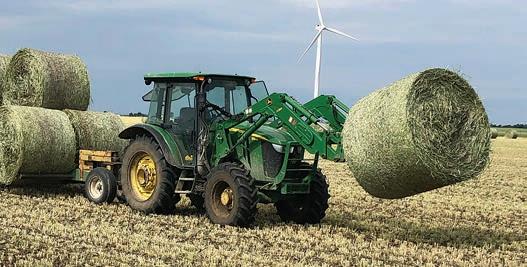
While the primary goal of a farm equipment lease agreement is to avoid any disputes between the parties, a secondary goal is to roadmap what should happen in the event that a dispute nevertheless arises. To that end, a lease should include the parties’ wishes regarding the means to resolve any potential disputes. This includes whether there are any predetermined damages available to either party in the event of a breach, whether the parties plan to use alternative dispute resolution (e.g., mediation or arbitration), which court will have jurisdiction over any legal proceedings, which state’s laws will apply when interpreting the agreement, and whether parties will be allowed to recover any reasonable attorneys’ fees incurred in a dispute.
For more information, contact Cari Rincker, Esq., at (212) 427-2049; cari@rinckerlaw.com.
When I finished my research on the subject for this article, I concluded that a more apt telling of this story should be left to more gifted writers such as Louis L’Amour. In his absence, I’ll do my best to chronicle one of the most fascinating stories of sheer grit and determination I have ever heard about. My focus will primarily be on John Albert “Al” Scorup. However, his achievements could not have happened without the help of his brother, Jim. Of course, along the way, there is a long list of people who deserve credit and played key roles.
In this column for the July/August Register profiling Charlie Redd, the name Scorup-Somerville Ranch, the S and S, was referenced. It was disclosed that the S and S was in control of 1.5 million acres, which Charlie purchased in 1965 for $2.1 million. Intrigued, I set out to learn more about the S and S.
In Al Scorup: Cattleman of the Canyons , author Neal Lambert colorfully details the trials and tribulations of Al, Jim, and many others who helped to build what eventually became the S and S. Lambert’s lead character was Al — and rightfully so — since history shows that he was the inspiration and driving force behind the resulting empire.
John Albert “Al” Scorup on a cattle drive. Photo courtesy of Moab Museum.
hard winter of 1896–97, the brothers were broke. All that they had to show for six years of hard work was 40 cows and a few calves.
Jim agreed to stay behind. Needing money, Al went looking for work. He was able to sign a contract with a cattle company called the Bluff Pool. He would be paid $5.00 per head to round up wild longhorns. Al and a group of men managed to gather over 2,000 head in the worst terrain they had ever encountered. With almost $10,000 deposited in the bank in Durango, the Scorups finally had the funds they needed to operate. Soon, the Bluff Pool collapsed and the Scorups bought it out.
Born in 1872, all Al Scorup ever wanted was to be a “cattleman.” He and his brother, Jim, rode stick horses around their yard in Salina, Utah, and “branded” imaginary calves with pieces of twisted wire. In his teens, having earned 400 lambs helping his father with a cooperative sheep herd, he traded them for cattle.
John Albert “Al” Scorup. Photo courtesy of Moab Museum.
By 1891, his riding skills and horsemanship caught the eye of Claude Sanford in a horse roundup at Grass Valley. He hired Al to take care of 150 head of longhorns running wild in White Canyon. With an extra horse packed with a couple of patchwork quilts, some flour, bacon, and pinto beans, he set out on the first of countless treks to that harsh and unforgiving landscape. His deal with Sanford was that he would get one-third of the calves born, provided that he could even find the cows.

Al eventually located the cattle and tucked them away in a remote canyon. He returned to Salina where he convinced Jim to partner with him. They acquired 300 head of cattle and were faced with the seemingly impossible task of getting them to White Canyon. Nineteen-hour days in the saddle were common, but their biggest obstacle, then and thereafter, was crossing the Colorado River. When they reached the river it was December, and it was filled with floating ice. The cattle wanted no part. Only their never-ending, relentless, superhuman effort forced those reluctant cows to the other side. They persevered.
The hardships encountered by these pioneers cannot be adequately described. Dealing with large numbers of wild horses eating their way through the range and ever-present wolves was a daily routine. In one fall alone, wolves killed 150 calves. The weather was unpredictable and harsh. After the setbacks with the
By 1901, Al felt the need to improve the quality of his cattle. He and Jim went to Ephraim and bought 30 purebred Hereford bulls and pushed them 300 miles to White Canyon. Those bulls wanted no part of the Colorado River, but once again the Scorups prevailed.

By 1912, their outfit had become a sizable cattle concern. From the Elk Ridge to the Blue Mountains, the Junction of the San Juan, and the Colorado, thousands of cattle ranged over many thousands of acres.
While Al and Jim had both married and each had several children, they were seldom home. In 1918, Jim’s wife died of pneumonia following the flu, and not long thereafter, Jim also died of the same illness. Al was now on his own.
In 1926, Al partnered with Andrew Somerville and others and acquired the Indian Creek Cattle Company, which became the S and S. It encompassed almost two million acres.
Al was still on horseback at age 80 overseeing the work now entrusted to his family. After Al suffered a stroke, his son-in-law, Harve Williams, took the reins. It is fitting that he was inducted into the Cowboy Hall of Fame since all he ever wanted to be was a “cattleman.” PERSEVERANCE comes to mind. n
Lambert, Neal. Al Scorup: Cattleman of the Canyons. (Logan, Utah: Utah State University, 1964).
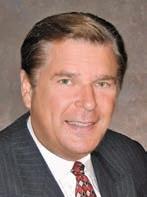
Editor’s note: This is the twenty-fourth in the series Our Pioneers.
Is there a Simmental pioneer who you would like to see profiled in this series? Reach out to Larry Maxey or the editor to submit your suggestions:
larryhmaxey@gmail.com • editor@simmgene.com

Our Pioneers — John Albert Scorup: “A Tale of Perseverance”

A total of six trustee positions are open in four regions. The Eastern region has two open positions, the North Central region has two open positions, the South Central region has one open position, and the Western region has one open position.
Nov. 21 Trustee election ballots mailed and posted online.
Dec. 26 Deadline for trustee ballots to reach the Chairman of the Tellers.
Dec. 19 Call to meeting mailed and posted online, including ballots for any Rules or Bylaw changes.
Jan. 19 Deadline for Rule/Bylaw change ballots to reach Chairman of the Tellers.
Jan. 25 55th Annual Meeting, Bozeman, Montana.
DNA research fees are $1/minute and may apply to parentage rechecks, misidentified samples, or other scenarios involving unusual increase in staff time. Each case is unique, so estimating the final charge is difficult. If there are a significant number of animals not qualifying to a parent(s), please reach out to the DNA Department to discuss a rough estimate of time and cost.
Allow 4–5 weeks. Please communicate any deadlines you may be working with to the ASA DNA staff. Expedited and tracked shipping is always recommended when ordering kits and shipping samples to Neogen.
Sample packages sent to the ASA office (with or without paperwork), instead of the lab, will incur a $30 research fee. With the exception of research projects (CHR, CCG, CXP), all samples are to be sent directly to the lab with ASA paperwork.
The first quarter of the 2022–2023 fiscal year ended on September 30. This means that, for those who have not already done so, quarterly Check-Off dollars are available for distribution to state associations. The applications are located on simmental.org. Go to Membership → State Associations → Promotional CheckOff Dollar Request. Please do not submit this list by email.
Many state association activities have occurred during these past months. Please submit any pictures or information about these events to editor@simmgene.com to be published in the State Scene section of the Register

If you have questions please contact Bert Moore at bmoore@simmgene.com.
In accordance with the Beef Improvement Federation guidelines, the year-letter animal identification for 2022 is K, and will be followed by L in 2023, and M in 2024. The letter J was the year-letter designated during 2021.
Per the BIF guidelines, the following letters are not used: I, O, Q, and V.
Making access to complete herd data easier, the ASA Board of Trustees recently passed an open-breed promotion to dualregister females that are registered with another breed association at the nominal rate of $5.00 per head. Any person can apply for registration on an animal registered with another breed association. To get started, email a list of the other breed association numbers with tattoos to simmental@simmgene.com.
ASA recently launched a new feature on Herdbook allowing members to download official digital certificates for registered animals. After September 1, 2022, ASA will no longer scan and email or fax copies of printed certificates, and is encouraging shows, sales, and other events to utilize digital certificates. Digital certificates are the easiest, most reliable way to obtain an official record quickly. To download a digital certificate, search for your registered animal on Herdbook. If you are logged in and the animal is registered in good standing, there will be a button to download a digital certificate. Only the current owner of an animal can access the digital certificate. Please contact the registrations department with any questions at simmental@simmgene.com.
The ASA Board of Trustees has passed a resolution to change the direction of the ratio for birth weights so that larger ratios are assigned to animals with heavier birth weights in their contemporary group and vice versa. This resolution came about to standardize the direction of the ratios so that higher ratios uniformly mean more of that trait.
Additionally, breeders can now indicate if they use hoof tape to estimate birth weight in Herdbook. There is a column called “BwMethod” next to the column where birth weights are entered in the animal entry page. If the weights were estimated using hoof tape, then simply put a T in the “BwMethod” column. If birth weights were obtained using a scale, there is no need to enter anything.
Beginning August 1, 2022, members who have provided an email address received a digital statement. As postal service delays continue to increase, digital statements allow for fast and effective communication. If you did not receive a statement please check your spam folder. Your billing history is available any time through your Herdbook account. Log in, select the My Account tab, select View ASA Billing History, choose the Month and Year and click on Apply. Please log in, go to the My Account tab and make sure the email that is on file is current.
July is the beginning of the new fiscal year and with that comes the invoicing of the Annual Service Fee (ASF). The ASF is necessary for your membership to remain in active status.
Additionally, you must have registered or transferred one or more animal records within a two-year period to remain active. Please pay your annual service fee as soon as possible, as your membership must be in active status to receive a ballot and vote in the upcoming trustee election.
The Calf Crop Genomic (CCG) testing project, and Cow Herd DNA Roundup (CHR) continue to accept new submissions. The CCG offers a 50% off GGP100K genomic test including parentage ($25 compared to $50 equivalent test) to participating breeders who test their entire calf crop group.
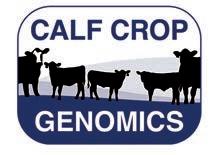
The CHR program also continues to accept new herds. The project tests females at $25 per sample for a GGP100K genomic test. Members must test 90% of their calving-age cows to qualify for the reduced price. When members submit mature cow body weights and body condition scores or hip heights on 90% of their calving-age cows, they will receive a
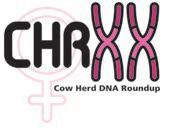
$5 credit to their account for each reported cow. Cows must be 18 months of age or older when mature cow measurements are taken to qualify for the $5 credit. The $5 credit will only be applied once in an animal’s life. For example, if a member received a credit for the phenotypes in 2018 for that cow, they cannot receive another credit for the same cow with a new weight and BCS in 2019.
Additional requirements apply for both programs. Please visit simmental.org, and email researchdna@simmgene.com for full program requirements and more information.

Thursday, November 24, & Friday, November 25 Thanksgiving
Friday, December 23, & Monday, December 26 Christmas n
With the ability to increase the rate of genetic change comes the possibility to make mistakes at a faster pace. Breeding goals need to be clearly identified to ensure that selection at the nucleus level matches the profit-oriented needs of the commercial industry.
Inventory-based reporting captures more complete phenotypes on reproduction and longevity traits, and thus creates more accurate genetic selection tools.
It is important for the precision of the genetic evaluation to group animals treated uniformly. Proper reporting of contemporary groups reduces bias in EPD.


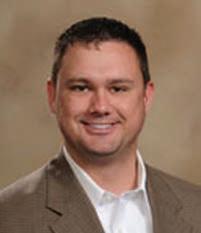
Phenotypes are the fuel that drives the genetic evaluation. Take pride in collecting accurate data. Report records on the complete contemporary group in order to paint the most accurate picture of the genetics in these cattle. If possible, collect additional phenotypes like mature cow weight, cow body condition score, udder scores, feed intake, and carcass data.
The quantity and quality of fertility traits need to dramatically improve. Providing disposal codes to identify why females leave the herd is vital. Commercial data resources, where the true economically relevant traits exist, are going to become more critical to capture. Breeders can help prove the genetics of their own seedstock by encouraging their commercial customers to join ASA’s Commercial Total Herd Enrollment (THE) option and add valuable data to the evaluation.
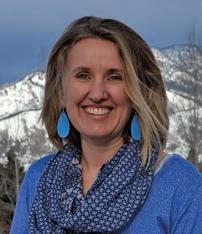

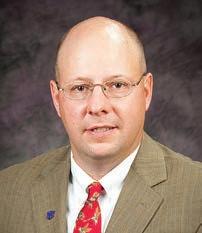
As the list of published EPD continues to grow, using economic selection indices will become even more helpful to reduce the complexity of multiple trait selection.
If the number of EPD increase, tools to reduce the complexity of sire selection for commercial producers must continue to develop. Breed associations and seedstock producers have the obligation to aid commercial clientele in making profitable bull selection decisions.



Genomic selection offers an opportunity to increase the rate of genetic change and break the antagonistic relationship between generation interval (the average age of the parents when the next generation is born) and the accuracy of selection (e.g., accuracy of EPD) — two components that determine the rate of genetic change. However, as with any tool, genomic information must be used correctly and to its fullest extent.
a DNA test to your decision is like knowing . . .
25+ calving ease scores
22 birth weights
25+ weaning weights
25+ yearling weights
Stayability/productivity records on 15 daughters





6 carcass weights
10 marbling scores
8 ribeye area measurements
this from a test you can complete before you wean the calf.
Jackie Atkins, PhD Matt Spangler, PhD Bob Weaber, PhD Wade Shafer, PhD
A cow inventory reporting program, THE requires participants to provide annual reproductive and inventory status on their cow herd. THE is designed to improve quality of data submitted for the genetic evaluation, and in turn improve and develop reproductive EPD. By submitting data on the entire calf crop or contemporary group, breeders will receive more accurate predictions of their cattle. The ASA has four THE options to fit most seedstock and commercial operations.

1All animals within a contemporary group should be genotyped.

If genomic data are meant to truly enable selection decisions, this information must be collected on animals before selection decisions are made. The return on investment of this technology is substantially reduced if it is used after the decision is made. The ASA’s Calf Crop Genomics (CCG) program offers 50% off GGP100K test for breeders who commit to genotype the entire calf crop. See sidebar for more details.

The promise of genomic selection has always suggested the largest impact is for lowly heritable and/or sex limited (e.g., fertility) traits or those that are not routinely collected (e.g.,disease). This is indeed true, but it necessitates that genotyped animals have phenotypes. For sex-limited traits, this becomes a critical choke point, given that historically the vast the vast majority of genotyped cattle are males. If producers wish to have genomic-enhanced EPD for traits such as calving ease maternal and heifer pregnancy, they must begin or continue to genotype females. The ASA has a unique program called the Cow Herd DNA Roundup (CHR) to help herds collect female genotypes. See sidebar for more details.

The Cow Herd DNA Roundup (CHR) is designed to increase the number of female genotypes to better predict maternal traits, such as maternal calving ease. Genotyping entire herds reduces bias created when only the best cattle are genotyped. Gathering massive amounts of genotypes on entire cow herds will significantly improve the genomic predictions and rate of genetic progress. As parentage testing is included, CHR herds will have pedigrees validated through DNA. Participating breeders benefit from having genomically enhanced EPD on the entire cow herd — equivalent to a lifetime number of calf records in several traits for an exceptionally low cost.
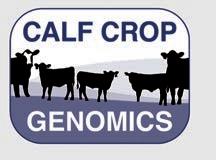
Calf Crop Genomics, a research project launched by the ASA in collaboration with Neogen Genomics, offers 50% off GGP100K genomic test including parentage ($25 compared to $50 equivalent test) to participating breeders who test their entire calf crop. Genotyping entire calf crops is important to use genomically enhanced EPD (GE-EPD) for selection decisions, reduce selection bias in genomic predictions, and increase the volume of genotyped animals for future improvements to genetic predictions. The latter two points make any singular genomic test in the future better for all members using genomics.
3Genotypes can provide useful information in addition to predictions of additive genetic merit.
Do not forget the value in correcting parentage errors, tracking inbreeding levels, identifying unfavorable haplotypes, estimating breed composition, and estimating retained heterozygosity. All of these can be garnered from populations that have a well-defi ned set of genotyping protocols.
The beef industry should be congratulated for the rapid adoption of genomic technology, but there is a lot of work to do. Of critical importance is the fact that genomic technology will continue to change and does not replace the need for phenotypes nor the fundamental understanding of traditional selection principles including EPD and accuracy.
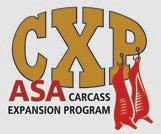
Despite the importance of carcass traits to our industry, few producers devote resources to collecting and recording actual carcass data. While the Carcass Merit Program (CMP) is a valuable progeny test, it is limited in the number of records produced. We cannot depend on the CMP alone to bring in carcass data. In the age of genomics, it is clear we need genotypes on animals with actual carcass phenotypes.
Adding another layer of commitment to predicting carcass traits, the ASA initiated a new program, called the Carcass Expansion Project, in the fall of 2018 to increase the number of carcass records on genotyped animals. The ASA is are ramping up both phenotypic and genotypic data collection on terminal calves — a vital part of our vision.
would like to work with you on your sire-identified, terminal calves.
Free semen on the nation’s top herd sire prospects
Free genetic evaluation (EPDs and Selection Indexes) on your cowherd
$65 paid per CMP sired carcass record





DNA tests performed on terminal calves

is a structured young sire test so please inquire about qualifications and expectations.
For more information regarding both programs, contact: cmp@simmgene.com for CMP inquiries lgiess@simmgene.com for CXP inquiries
Free 100K GGP DNA test on all sire-identified terminal calves with carcass data

DNA Parentage included
Tissue Sampling Units provided at no cost
is an ongoing research project, participants are limited so please inquire about availability.
Keeping your family on the ranch takes more effort than ever.
Whether you are a serious seedstock producer (regardless of breed type) or a progressive, data-conscious commercial outfit — now is your time to receive the most credible genetic tools in the business, at the best prices, and no drama. Your kids and grandkids need the best tools available. It is time to make the tough decisions.
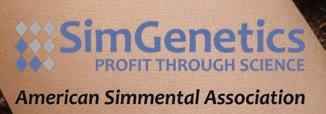



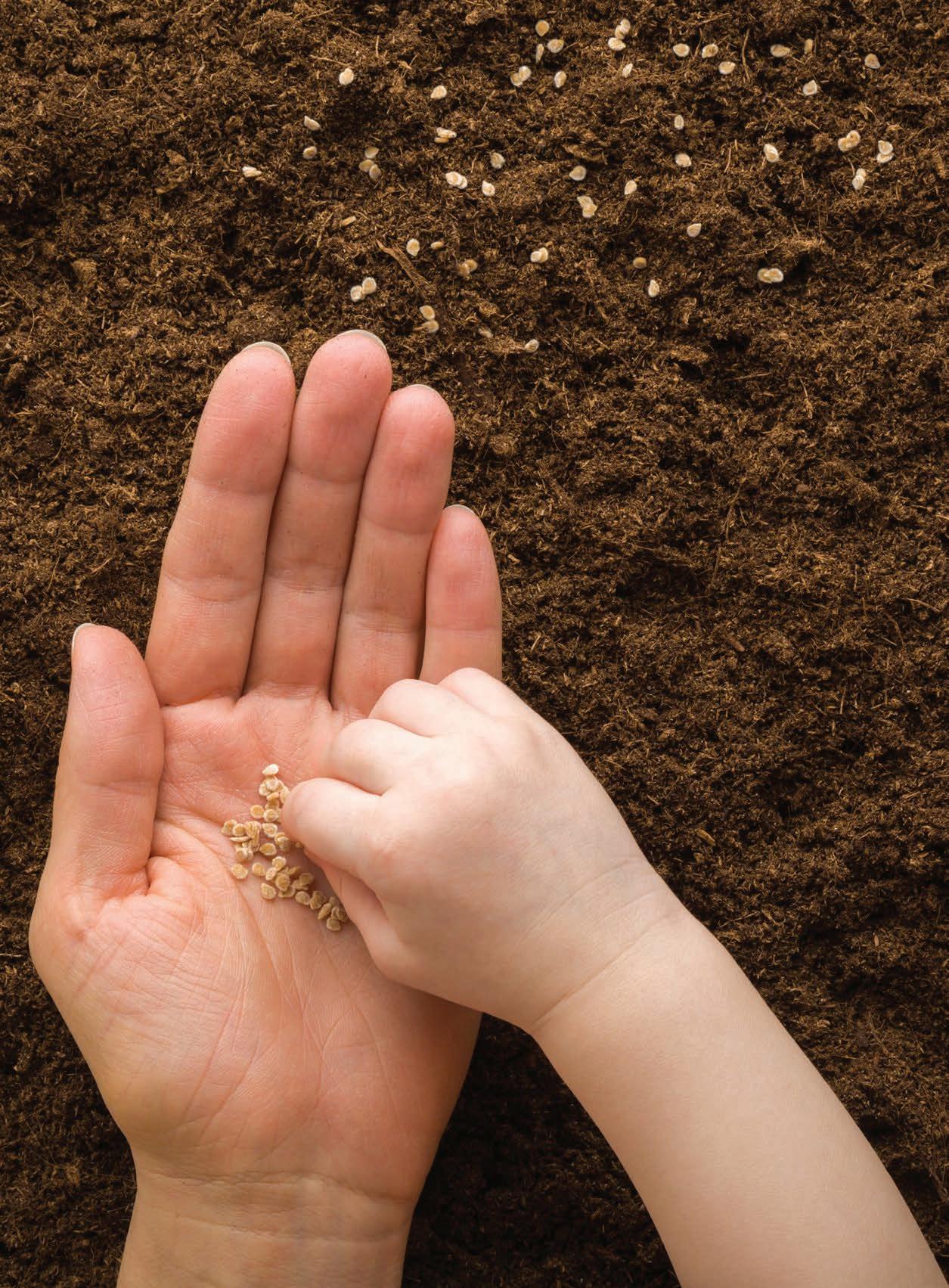


To learm more about the CMP visit www.simmental.org, then click Carcass Merit Program under the Commercial tab.

Questions, contact cmp@simmgene.com for more information regarding this program.
The American Simmental Association Carcass Merit Program (CMP) is the beef industry’s most demanding and informative young sire test. The program is a hallmark of ASA breed improvement for economically relevant carcass traits. Commercial producers play an integral part in this project.

$65 for each AI-sired calf with carcass information
Free semen on top young herd sires
Free ASA Genetic Evaluation on your cowherd

Free genotyping on terminal progeny

Keep any or all replacement females
*The CMP is a structured young sire progeny test. Participating cooperator herds will random sample their cowherd with CMP semen, and the resulting male (or female) progeny will be harvested with individual carcass data gathered. ASA Staff will work with cooperator herds to provide bulls that fit the general criteria of your management program, however only bulls nominated into the CMP program may be used. Producers are encouraged to be somewhat proficient in Microsoft excel for accurate and consistent record keeping.
A long, hot, and dry summer is finally coming to an end and fall is on the horizon here in Oklahoma.
Calves are weaned and we can see the rewards from all our hard work over the past year. Cows are bred with the hope of the next great one being born if everything works in our favor. This has been a very chaotic and trying year for cattle producers and everyone involved in agriculture. High input costs, high temperatures, and little to no rain has made it extremely difficult for everyone. We all know that this is just how it is in agriculture. We face adversity in all facets of the industry and unfortunately some years are worse than others, but we continue to work hard and survive from year to year because each one of us has a passion for the industry. We
wouldn’t change a thing about the life that we have chosen.
As we enter the fall show season we look forward to reconnecting with friends and meeting new ones as we travel across this great nation. These shows give all of us the opportunity to showcase the work and dedication that we have all put into our operations to produce the best product that we can; hopefully they are well received. Also, it gives us ideas about things we can do better, like which bull we need to try for the next breeding season. We all like to be competitive and take a banner home with us from a Major show, but the true benefits of exhibiting are the relationships we develop and the information that we receive from each person we take the time to visit with.
I look forward to seeing old friends and making new friends as I travel to the shows this fall as I represent the South Central region. Safe travels and see you all soon! n

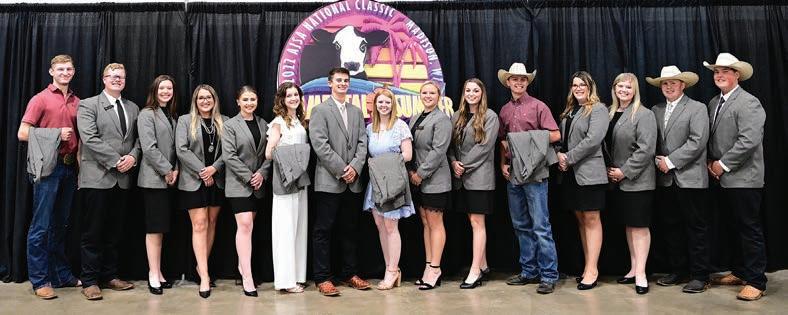

Luke Harker Hope, IN 812-371-7976
lukeharker2252@gmail.com
Walker Housley Dayton, TN 423-599-8346
walkerhousley@gmail.com
Matt Koverman Minford, OH 740-988-0203
koverman.18@osu.edu
Garrett Walther Centerville, IN 765-238-8584 gwalther55@gmail.com
Jazlynn Hilbrands Holloway, MN 320-297-1611
jmhilbrands@gmail.com
Martha Moenning Hayfield, MN 507-923-1114
marthamoenning@gmail.com
Emerson Tarr LeRoy, IL 309-205-0860
eleetarr2021@gmail.com
Rylee Abney Watonga, OK 405-446-7588

rabney914@icloud.com
Kaitlyn Cloud Carthage, MO 417-793-7824
kcloud2002@gmail.com
Hallie Hackett Texarkana, TX 903-556-6758
halliehack10101@gmail.com
Blake Henrichs Okarche, OK 405-831-1672
bhenrichscattleco@gmail.com
Bella Beins Deweyville, UT 435-452-2391
bella.beins@gmail.com
Blake Fabrizius Carr, CO 970-556-9115
bwfabrizius@gmail.com
Jonna McCullough Fort Benton, MT 406-868-0253
mcculloughjonna1@gmail.com
Sydney Schwenk Boring, OR 503-847-6828
sydney.schwenk55@gmail.com
Developing leaders through friendship, networking, and communication skills!
The true benefits of exhibiting are the relationships we develop and the information that we receive from each person we take the time to visit with.
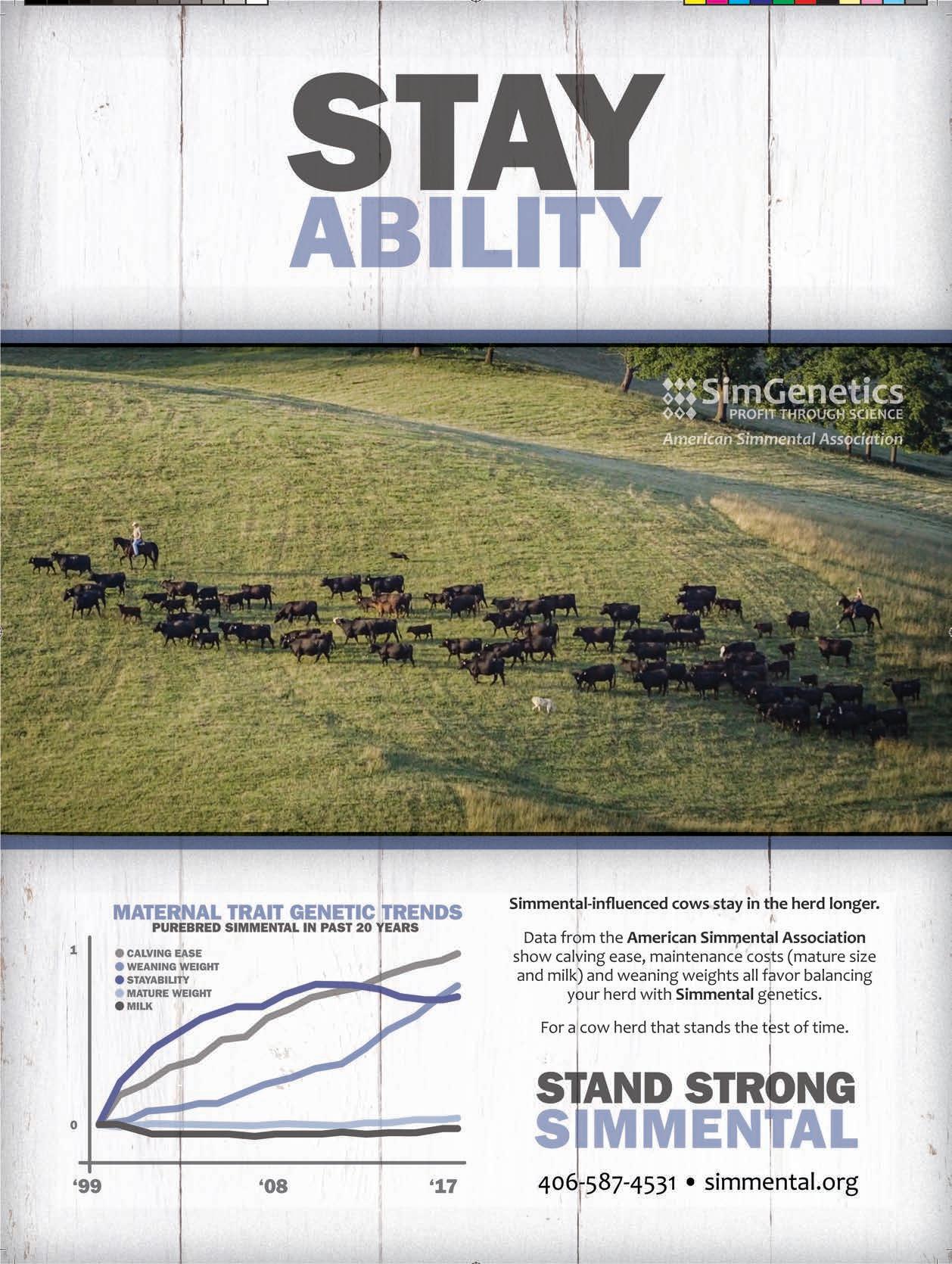
that ALL
Start with your Preliminary Inventory by accessing it online (see reverse for instructions or use paper packet received in mail/email)
Enrollment Template below
on
removal code is already in the Primary Code column.
Remarks are for member use only. Enrollment will not be adjusted from this column.
If you enter “H” in the Bill Code column, you will be billed half now and half later in the year.
If you need to add a commercial dam, enter her tattoo (AnmTatt), date of birth (BirthDt), and breed codes (BrdCds).
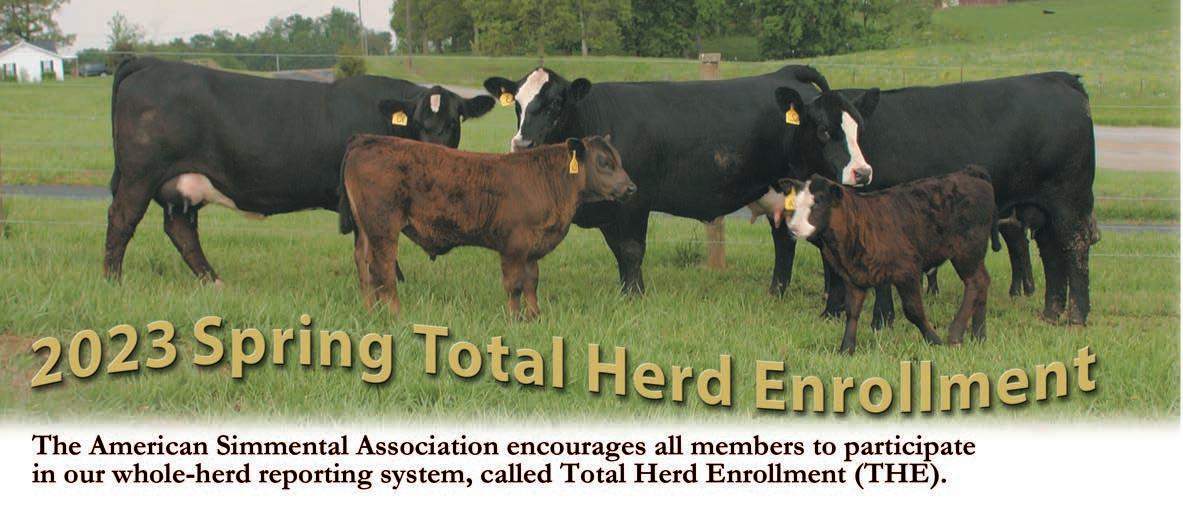
for each
If a
is being
enter
Review Errors and/or Warnings
Errors
by red triangle at left side of
Select the Errors tab – errors will be listed and MUST be resolved before submitting


Herds in Option D must email
Warnings
for
number to
processing
by a purple triangle at left side of line)
Select the Warnings tab – review each warning listed, correct if needed
Job button shows, select button,
and submit again
the
Proceed to Billing for billing summary (After
15, 2022, all
will have a balance due
ecting the $1.00 non-refundable late fee per
Add Payment
Enter credit card information.
SUBMIT (Enrollment will
without this
Status
To save
change to Complete
and return
will remain in an incomplete
under
be
The
note that billing is based on the submission date, not the date it was started. Job must be submitted prior to December 15, 2022, to avoid
within
business day.
leave a detailed








and





will research before we call


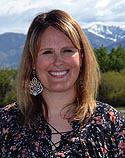

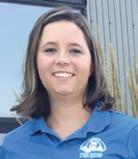
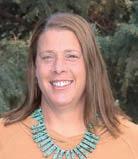
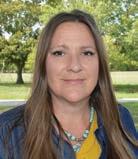
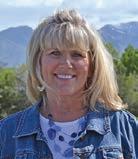
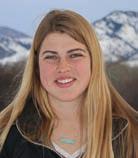

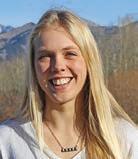
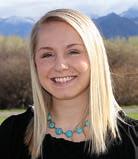
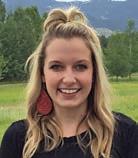

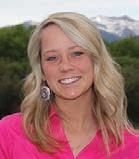

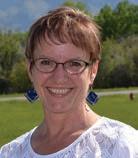
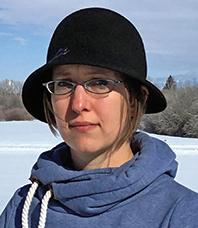
back. It






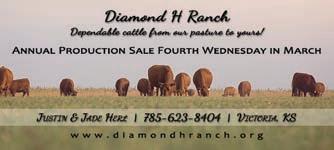
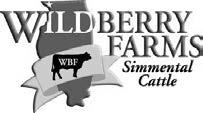
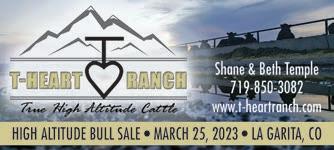
Mark
3553 Upland Rd.



Springs, KS 66859-9652 785-466-6475
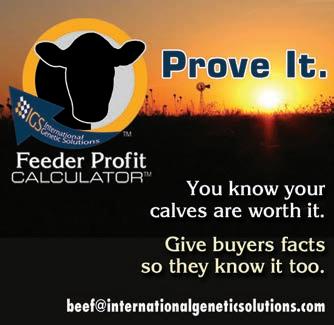

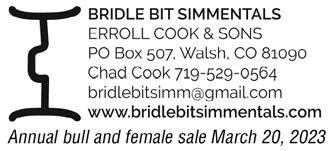



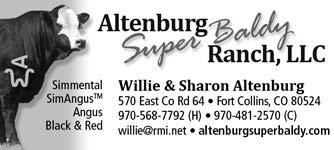
785-466-1129
785-258-0173
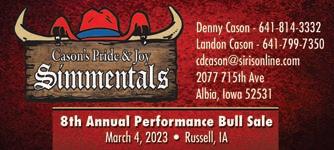
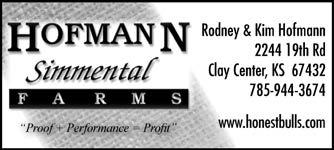
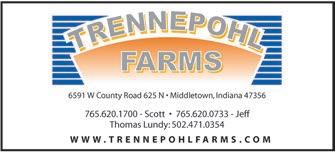
Lynn Aggen Office: 507-886-6321 Mobile: 507-421-3813 Home: 507-886-4016

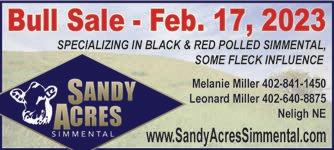
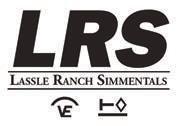
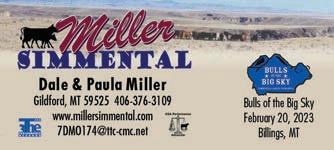
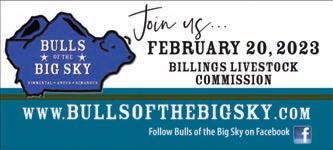
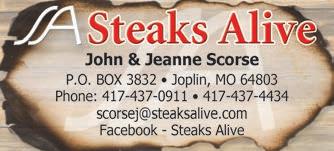
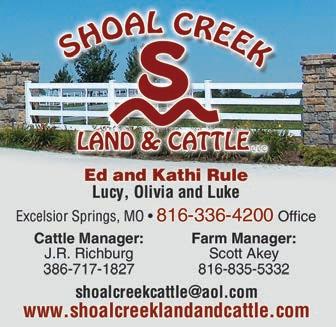

Aggen Mobile: 701-866-3544 Home: 507-772-4522 Email: mattaggen@hotmail.com

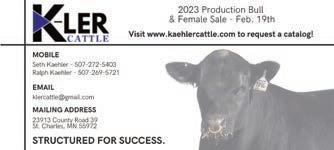
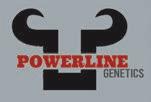



Ellingson & Family
125th Ave. NE
701-384-6225
701-741-3045
Dahlen, ND 58224
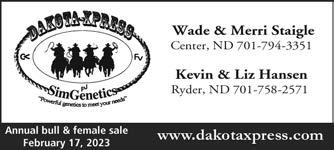
www.ellingsonsimmentals.com
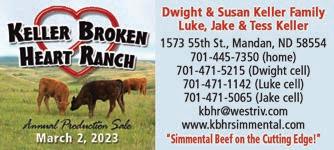
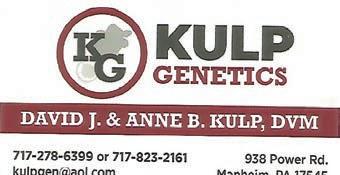
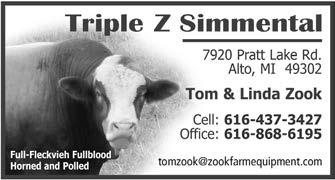
Production Sale, January 27, 2023


and Michelle Kaelberer and Family 4215 County Road 85
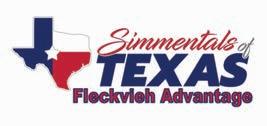
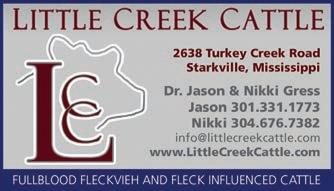
New Salem, ND 58563 701-220-3124 (cell)

701-843-8342 (home)
of the West Bull and Female Production Sale each February
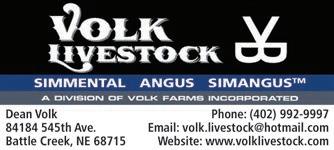
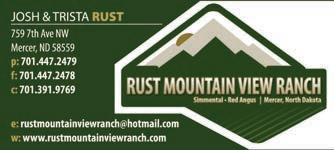
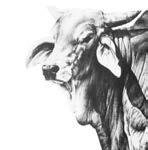
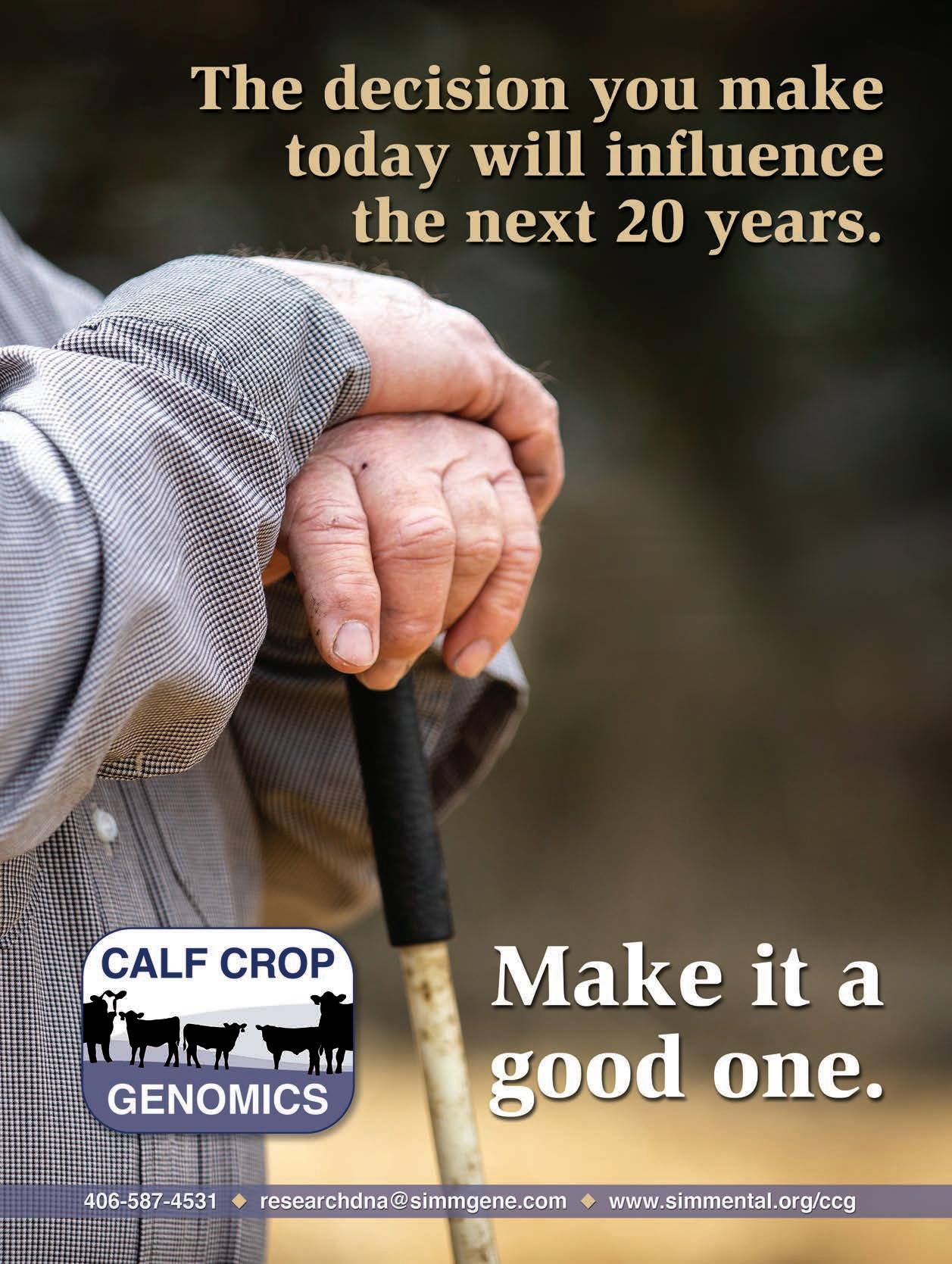
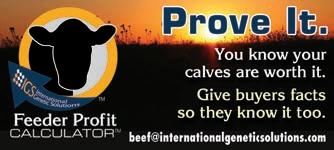
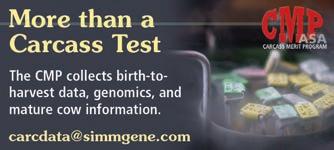
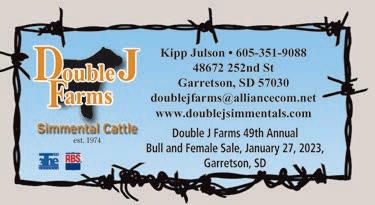
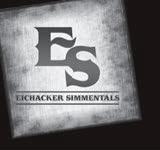


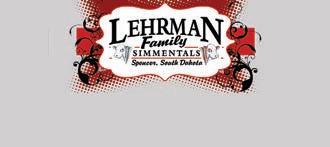


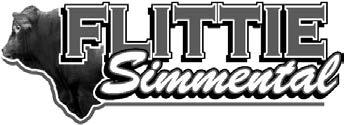

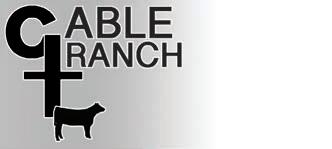

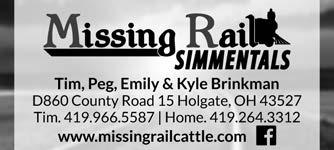



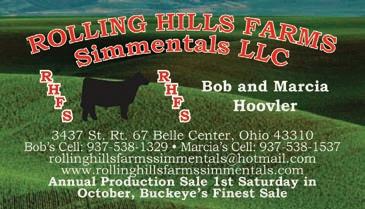
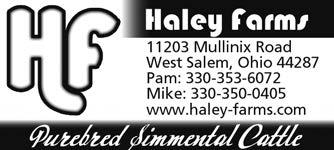
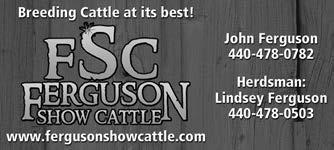





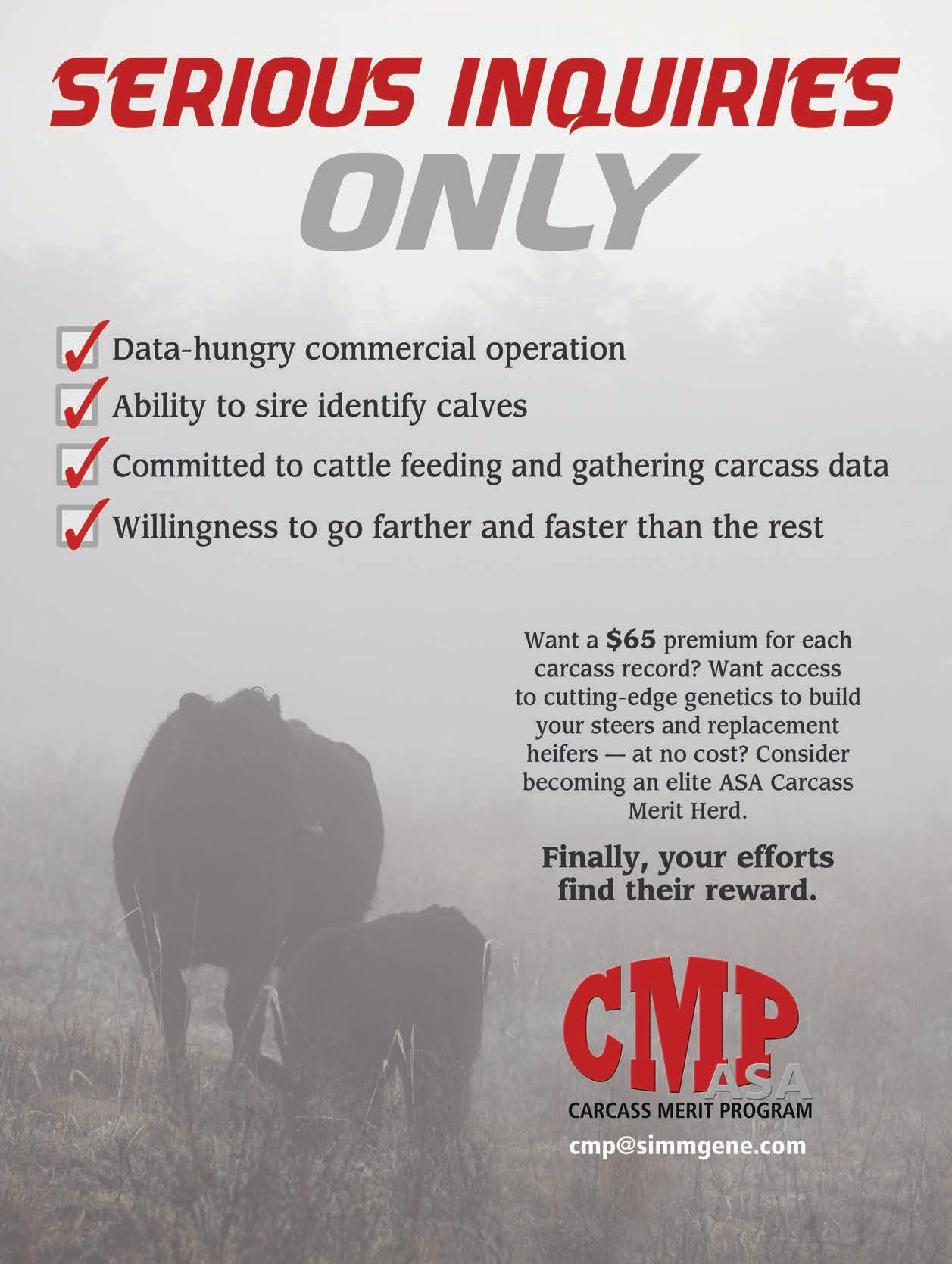

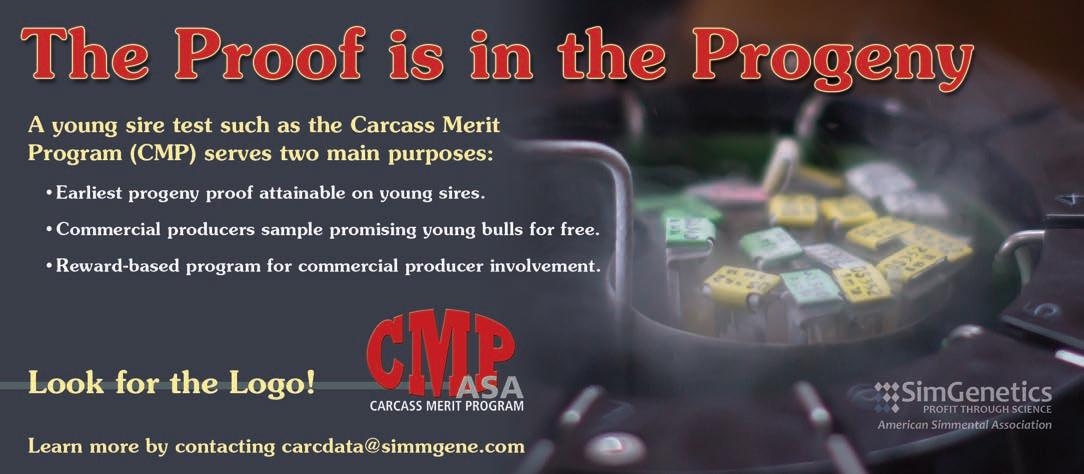
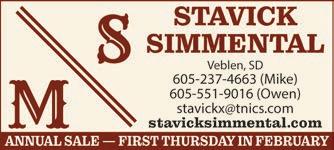
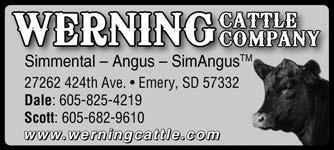
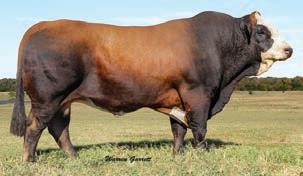
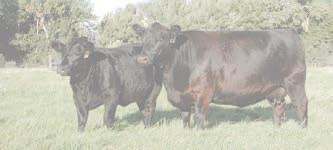
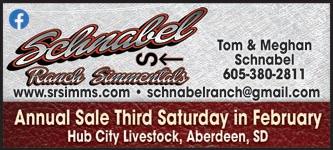



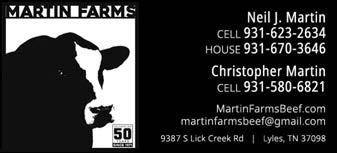
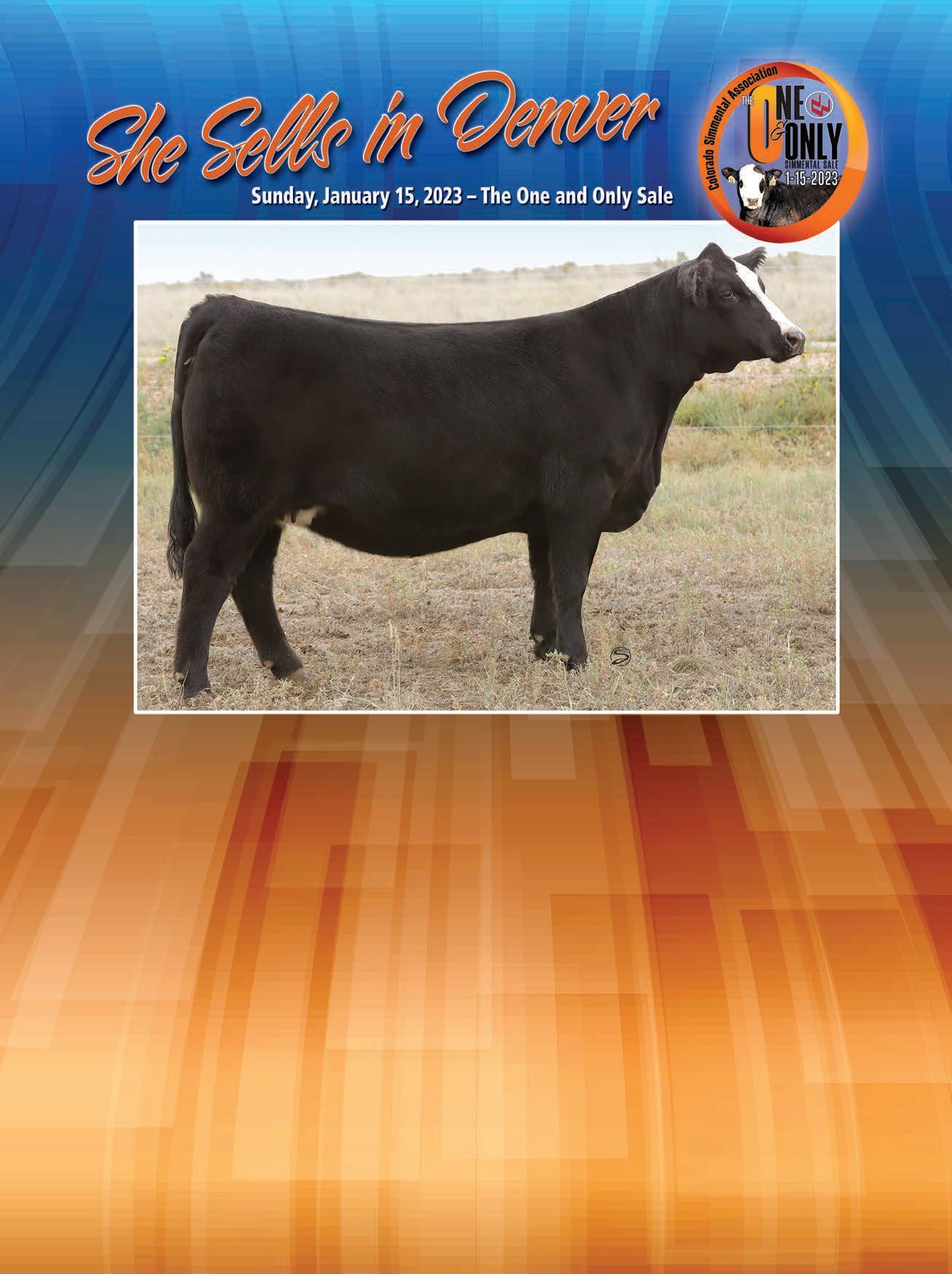

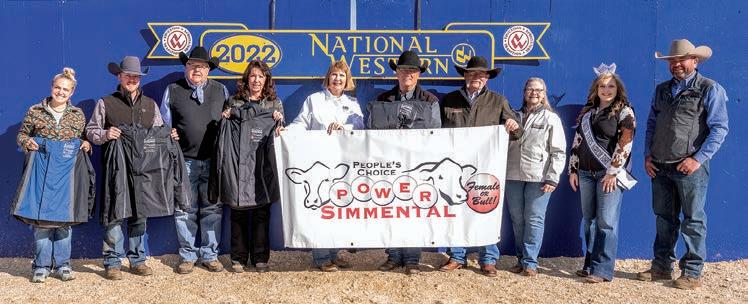





The USDA Office of Inspector General (OIG) is asking the Food Safety and Inspection Service (FSIS) to update its tracking and monitoring of the agency’s response to COVID-19 and the pandemic’s effect on the US meat industry.
Congress originally asked OIG to look into federal actions that may have affected the spread of coronavirus after the Trump administration’s executive order in April 2020 to keep US meat plants open as COVID-19 continued to spread. The resulting report — focusing on initial voluntary health and safety standards at plants and within USDA’s inspection forces — found that FSIS spent more than $22 million of the $33 million it received under the CARES Act to pay for personal protective equipment and employee compensation. The division also issued notices and guidance to promote health and safety during the pandemic and developed a series of notices and guidance tracking COVID-19 cases throughout the pandemic, the report noted.
OIG recommends that FSIS complete updates to the process for tracking, monitoring, and reporting safety and health standards, and correcting occupational hazards, during the pandemic. The report added that FSIS officials agreed with the OIG recommendations and final action is expected to be completed within one year as outlined to the USDA Office of the Chief Financial Officer.
Federal prosecutors have recommended Washington state cattleman Cody Easterday spend at least ten years and one month in prison for a fraud scheme that cost Tyson Fresh Meats and another victim at least $244 million.
Justice Department attorneys filed a memo in the US District Court for Eastern Washington that called the theft “staggering,” and under standard sentencing guidelines recommended Easterday serve between 121 and 151 months, or up to 12 years and seven months.
Easterday’s scheme began to unravel in late 2020 when Tyson announced it was correcting financial results with the Securities and Exchange Commission for its beef segment for fiscal years 2017 through 2020. Tyson discovered the “misappropriation of company funds” by one of its suppliers. Court documents later revealed that supplier to be Easterday, who was charging Tyson for the costs of buying and feeding as many as 200,000 cattle that did not exist.
Easterday pleaded guilty to the “ghost cattle” scheme in 2021, and his sentencing has been delayed three times to allow Easterday’s legal team to sort out what the judge described as “a mess” in terms of personal financial issues, Easterday’s creditors, and Tyson.
Tyson’s losses totaled $233 million and Segale Properties of Tukwila, WA, lost $11 million. Easterday has promised to make restitution as part of the plea agreement.
Easterday accepted responsibility for his crime and sought to raise money for the victims by selling his family’s extensive cattle and farm holdings through bankruptcy court, according to the Justice Department.
By accepting responsibility, Easterday’s sentencing range was reduced by approximately four to six years, according to the Justice Department.
Entirely ceasing US international beef trade would be an economic catastrophe for America’s beef industry, and retail beef would be even more expensive for American consumers. That’s the conclusion of a new economic report co-authored by livestock economists Glynn Tonsor, Kansas State University, and Derrell Peel, Oklahoma State University.
Even a 10% reduction in US beef exports and imports would cause a significant disruption to prices and quantities of both feeder cattle and fed cattle. Summarizing their analysis in an interview with Drovers, Tonsor and Peel said the cumulative loss from a 10% reduction in exports and imports over ten years would create an economic loss of $12.9 billion to feeder cattle sellers and $6.8 billion to fed cattle sellers.
The report, “Assessing Economic Impact that Would Follow Loss of US Beef Exports & Imports,” outlines why the US trades beef internationally, summarizes historical beef trade data, quantifies national fed and feeder cattle market impacts that could follow loss of beef trade, and allocates national impacts to statelevel impacts. The report was prepared for the Kansas Beef Council, the Oklahoma Beef Council, and the Texas Beef Council.
“It’s hard to overstate the complex and ever-growing role of beef export and imports,” the authors said. “Beef export and imports combine to provide opportunities to increase value to the US industry by exporting products that have more value in foreign markets and importing products that can be sourced more economically in international markets.”
As a point of emphasis, “there’s value in both imports and exports for American cattlemen,” Peel said. “We’re seeking out value and benefit both ways.”
The analysis was initiated by a “long-term interest in understanding the trade more,” Tonsor said. “Industry stakeholders want to understand it better and the pandemic magnified some of that interest.”
Specifically, when COVID-19 disrupted the beef industry in the spring of 2020 and beef processing slowed to a trickle and retail demand skyrocketed, many industry stakeholders wondered why the US continued to import and export beef internationally.
Peel said understanding the ramifications of beef trade is an ongoing interest for cattle producers, which led to the project to assess the impact of trade on the US beef industry.
The review found the mix of countries the US exports beef to has developed, resulting in a more diverse, less concentrated export portfolio. Conversely, sources of US beef imports have comparatively fluctuated less over time.
“Implied trade prices clearly show the US receives a higher dollar per pound value for exports than it pays for imports, reflecting core differences in product type and the role of each transaction in adding economic value,” the authors wrote. “From 2016 through 2020, the US experienced average annual unprepared beef exports of 2.05 billion pounds, export value of $6.4 billion, and implied export price of $3.13 per pound. Conversely, 2016–2020 average annual unprepared beef imports were 2.30 billion pounds, import value was $5.8 billion, and implied import price was $2.52 per pound. These statistics clearly indicate participation in the global market provides a net economic gain.”
Extrapolating the 10% loss of beef trade in the author’s example cited earlier to a more extreme, full 100% loss would suggest a catastrophic impact, “broadly approximated at $129 billion for
Cattle producers are not the only ones to benefit from international beef trade. Without such trade, retail and food service beef products are more expensive for American consumers.
The ground beef market provides an example. “We would not be able to supply the ground beef market at the size it is today [without imports],” Peel said. “Or, if we did, it would be because we were grinding a lot of more expensive lean products out of the US domestic supply to make it work. That would inevitably have a big impact in terms of raising the price of ground beef and taking that value away from other markets where it’s currently being used.”
Imported trim makes up just over half of beef imports and is used primarily for ground beef but also for a variety of other processed beef products including sausage products, the authors wrote. Processing beef is also used for numerous prepared products including frozen meals, entrees, and other processed products. While some processed products appear at retail, most imported trim is used for food service ground beef.
Reliance on imported beef has remained relatively steady, but US beef exports have grown increasingly important. Peel and Tonsor note that the US Meat Export Federation provides estimates of the per head slaughtered value represented by beef and variety meat exports. That value was about $300 per head in 2014 and had grown to more than $400 per head by November 2021.
“Since 2015 the percentage of fed cattle value derived from exports has continued to grow relative to volume,” Peel and Tonsor wrote. “For instance, current estimates for 2021 indicate 22% of fed cattle value is attributable to exports vs. only 15% of production (when considering both beef and variety meat). This is a classic example of demand growth and likely reflects increasing success in getting US products in the hands of those most valuing them.”
Peel and Tonsor said the economic importance of beef exports and imports is substantial and growing with time. “In the absence of beef trade, the entire industry would shrink significantly.” n
Trust In Beef has named Chad Ellis, a rancher from Lohn, Texas, and CEO of Texas Agricultural Land Trust, as founding chair of the collaborative value-chain program. Ellis is a longtime conservation agriculture executive whose deep experience includes leadership roles at Noble Research Institute and USDA’s Natural Resources Conservation Service.
The announcement comes as the program launches a fall education and outreach campaign for Nebraska beef producers, with stories, videos, and resources to support their sustainability journeys.
“The American beef producer is a sustainability leader and an innovative thinker who continues to adapt to changing environmental and market conditions,” said Ellis. “I am honored to serve as founding chair of Trust In Beef and to advance this work to elevate the visibility and measurable progress of sustainable beef on behalf of our partners and our industry, including beef producers and marketers.”
In his role, Ellis will serve as a strategic adviser to the Trust In Beef program, organized by Farm Journal’s Trust In Food and Drovers, as well as program partners Merck Animal Health, National Cattlemen’s Beef Association (NCBA), and US Roundtable for Sustainable Beef (USRSB).
“Chad is a tremendous leader with a vision for the incredible potential for the future of sustainable US beef,” said Amy Skoczlas Cole, executive vice president of Trust In Food. “As a partnership, we are thrilled to work alongside Chad to support beef producers in their journey of continuous improvement in areas such as implementing written grazing management plans,
becoming BQA certified, and strengthening the veterinarianclient-patient relationship.”

The Nebraska beef producer campaign continues through the fall with sustainability business information and resources drawn from leading industry sources including the USRSB goals. The campaign will raise awareness of beef sustainability resources and seek feedback from producers on barriers, opportunities, and next steps for continuous improvement.
Niman Ranch has launched a USDA-graded 100% grass fed and finished beef program, in response to rising demand for grass fed products, the company announced in mid-October.
Sourced exclusively from American ranches, the beef has exceptional marbling, tender texture, and consistent, rich flavor, with the added health and environmental benefits grass fed beef brings to the table, Niman Ranch said in a news release.
To meet soaring demand for grass fed beef, the US market has been flooded with imported products as well as poor-quality beef, Niman Ranch said. The company said up to 80% of grass fed beef volume sold in the United States is sourced from abroad.
Niman Ranch said its grass fed beef boasts top-line Angus genetics, a unique blend of nutritious grasses, and industry-leading humane handling practices. The beef is raised without antibiotics or hormones and is 100% Certified Humane.
The company said it is so confident in the new line that it is putting every cut to the test as one of the few grass fed programs to be graded by USDA.
(Continued on
46)
The products are available at fine dining establishments and boutique grocers across the country. The program also will expand to offer grass fed hot dogs and additional prepared items. Niman Ranch is owned by Perdue Farms, which bought the farmer and rancher network in 2015.


With the retail price of meat products projected to rise at the historic rate of about 10% in 2022, the theft of truckloads of meat also has picked up.
Police in Grand Island, Nebraska, are investigating the theft last week of more than $277,000 worth of fresh beef at JBS, KOLNTV in Lincoln reported. Police said a fraudulent carrier company signed up for a load of beef and was dispatched to JBS. The thieves drove away with the beef but never made it to scheduled destinations in Maryland and New York, according to the report.
In separate incidents, after more than $100,000 worth of pork was stolen from a JBS plant in Ottumwa, Iowa, another 37,000 pounds of product from an unnamed company disappeared in the early morning hours of September 17 in York, Nebraska. Also gone were the refrigerated trailer and the truck it was hooked up to, according to local media reports.
The truck and the trailer were later recovered off of a highway nearby. The meat, h owever, had already been loaded onto another vehicle.
That same weekend, in Grand Island, Nebraska, three trailers packed with meat products were stolen from Gibbon Packing Co. Including the trailers and the cargo, the value of the stolen goods came in at more than $750,000, according to reports. All three trailers were stolen from a cold storage facility on September 16.
Authorities are looking into whether the mid-September heist in Grand Island is related to a similar theft of three trailers packed with meat products in that town in late June.
The cargo thieves have taken steps, such as disabling the trucks’ GPS systems, that fuel speculation that they are from within the trucking industry.
Merck Animal Health announced it has signed a definitive agreement under which it will acquire Vence from its founders and shareholders. Vence is an innovator in virtual fencing for rotational grazing and livestock management. The acquisition is expected to be completed in the third quarter of 2022, subject to customary closing conditions. Specific terms of the agreement were not disclosed.
Vence, a privately held company, provides enhanced technology for producers and ranchers to track, monitor, and manage the movement of cattle through a high-tech platform of virtual fencing solutions. Using a computer or smartphone, customers have the capability to manage cattle movement and facilitate rotational grazing. Vence’s virtual fencing technology can reduce the need for fencing to subdivide pastures and allows producers and ranchers to manage their cattle and grass inventory, while reducing costs of labor and fencing materials.
“The acquisition of Vence will broaden our portfolio with complementary products and technologies to advance animal health and well-being as well as outcomes for our customers,” said Rick DeLuca, president, Merck Animal Health. “Vence is a natural fit with Merck Animal Health’s growing portfolio of animal intelligence products that include identification, traceability, and monitoring products. This new technology will give cow-calf producers the ability to track their cattle and the ability to move them from pasture to pasture.”
“I believe that Merck Animal Health is the best long-term home for this technology and our team. Their unparalleled expertise in the livestock space, ability to develop and scale hardware products, high-quality customer support, and a strong global footprint to expand Vence’s market reach make us really excited to join Merck Animal Health,” said Frank Wooten, founder and CEO, Vence.
Vence technology is currently available in the United States and parts of Australia. n



Japanese wagyu has been one of the hottest strains of beef in recent years, and it received further kudos at the 2022 World Steak Challenge in Dublin, Ireland.
Starzen Company, a Japanese cattle producer, triumphed at the challenge, taking the top prizes for “Best Steak in the World,” “World’s Best Sirloin,” and “World’s Best Grain-Fed.” This was the eighth year of the competition.
The steak, dubbed “Akune Gold,” came from an A4 grade, 30-month-old cow raised in Japan’s Kagoshima region.
“We are thrilled to have a new winner for this year’s World Steak Challenge,” said Ed Bedington of the World Steak Challenge. “It is very exciting to have our first Japanese entry and consequently the winner of World’s Best Steak. The vast number of entries from across the globe truly showcases the quality of steak on an international scale.”
Overall, Ireland took the most medals in the Challenge with 54, followed by England with 36, and Finland with 28.
Following a challenging 2022, Canada is expected to see moderate growth in chicken meat production in 2023, according to a new report by USDA’s Foreign Agricultural Service’s Global Agricultural Information Network (GAIN).
Canada should see chicken meat production reach 1.425 million metric tons next year, a 3.6% increase above levels for this year, which saw tight supplies of hatching eggs and day-old chicks, and increased levels of highly pathogenic avian influenza (HPAI).
Consumer demand for chicken meat remains solid at both retail and foodservice channels as chicken prices are expected to remain competitive among other meat protein alternatives, FAS reported. Canada’s poultry industry was hampered by the tight supplies of eggs and chicks in addition to HPAI outbreaks throughout the country in 2022.
Chicken meat imports under the three main tariff rate quotas in 2023 are expected to exceed 116,000 metric tons, with an additional 55,000 metric tons of chicken meat coming from Canada’s two import-for-re-export programs, FAS said.
The COVID-19 pandemic negatively affected Canada’s decades-long, steady increase in chicken meat consumption, and per capita consumption has yet to recover from pre-pandemic levels reached in 2019, the FAS report noted. FAS also projects that per capita chicken meat consumption in Canada should reach 84 pounds next year, up from 83 pounds in 2022.
Even though Switzerland has some of the strictest animal welfare laws in the world, voters could tighten them even further. Under the Swiss system of direct democracy, the referendum seeks to make protecting the dignity of farm animals such as cattle, chickens, and pigs a constitutional requirement. New laws would also lower animal stocking rates to meet organic standards.
If adopted, the new law would have the government set stricter rules for caring for animals, including giving them access to the outdoors, and for slaughtering them. The requirements would also cover imported animals and animal products. Proponents say the ban would protect the environment by reducing reliance on soya-based animal feed linked to deforestation.
The Swiss government recommended against the proposal, saying such changes would breach trade accords, increase investment and operating costs, and boost food prices.
The latest polling shows 52% of voters oppose a ban, and 47% support one. “Switzerland already has the tightest animal protection laws that exist, but I always say this may be true, but we can do even better and we should do better,” Alexandra Gavilano, a sustainable food expert for Greenpeace Switzerland told Reuters.
That carried little weight for Daniel Wuergler, co-owner of the Gallipool Frasses poultry farm, who told Reuter he would be forced to reduce his flock under the proposals.
“Whether I have 2,000 laying hens or 18,000, I can be a good farmer or a bad one. So for me, this initiative is totally useless,” he said. “If the initiative passes, we would be allowed to put 2,000 laying hens in this building. Doing the math, it won’t be possible to make our investments profitable.” Current law allows 27,000 chickens in one barn.
A bill recently introduced in the Senate proposes doubling the funding for two agricultural export market development programs administered by USDA’s Foreign Agricultural Service (FAS).
The multi-party bill was introduced by Senators Angus King (I-Maine), Joni Ernst (R-Iowa), Tina Smith (D-Minnesota), and Chuck Grassley (R-Iowa).

Several ag groups urged passage of the bill, called the Cultivating Revitalization by Expanding American Agricultural Trade and Exports (CREAATE) Act of 2022, which would increase funding for the Market Access Program (MAP) and Foreign Market Development Program (FMD) under FAS.
“MAP funding has not been increased from $200 million since 2006, and FMD funding has not changed from $34.5 million since 2002, but our foreign competition in most global markets… has grown,” US Wheat Associates Chairperson Rhonda Larson said in a press release.
The Coalition to Promote US Agricultural Exports said both programs are critical to expanding global market access for US-produced agricultural exports. It cited a study by agricultural economists at IHS Market and Texas A&M University that predicted that doubling funding for the programs would generate an additional $44.4 billion in US agricultural exports over the 2024–29 time period.
“This would directly benefit farmers, livestock producers, dairy operators, and small businesses as they work to maintain and expand their global presence,” a statement from the Coalition said.
Additionally, a recent economic analysis by Glynn Tonsor of Kansas State University and Derrell Peel of Oklahoma State University found that a 10% reduction in US beef exports and imports over ten years would generate $12.9 billion in losses for feeder cattle sellers, and $6.75 billion in losses at the fed cattle level. n


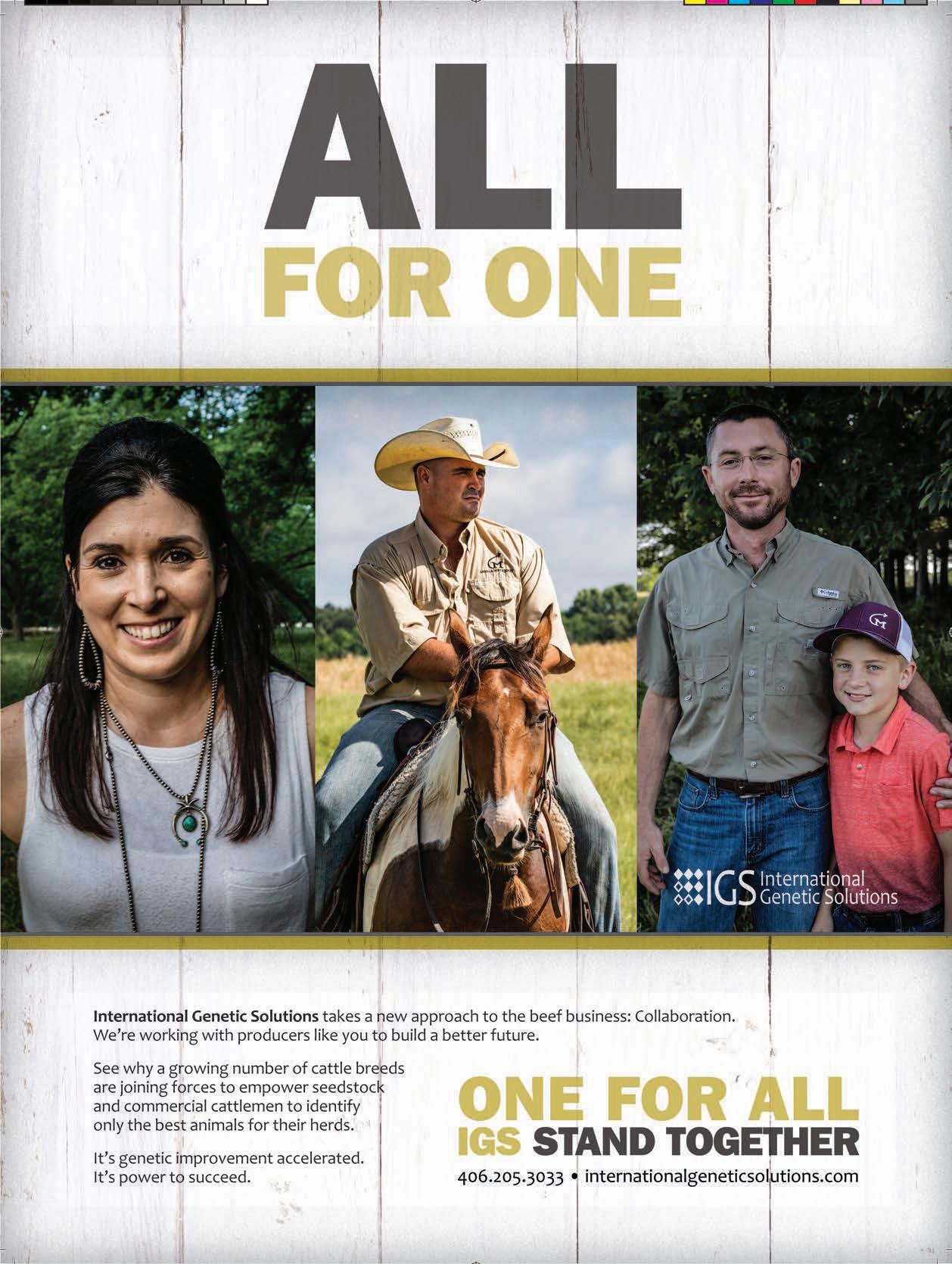


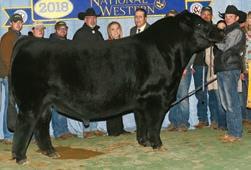
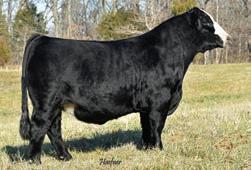
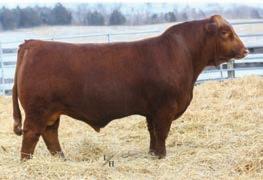







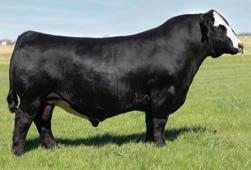
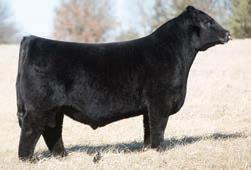









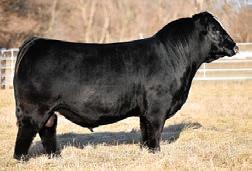
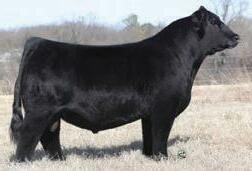




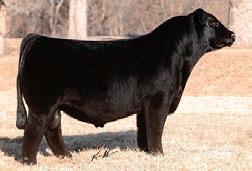
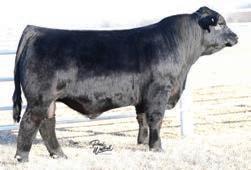
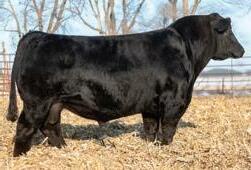
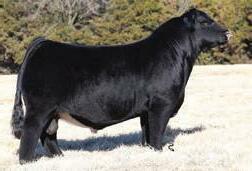








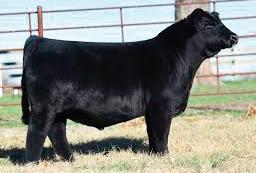





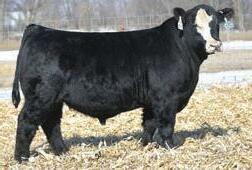


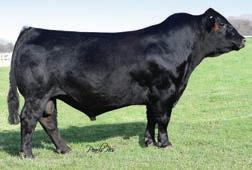


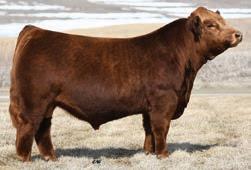


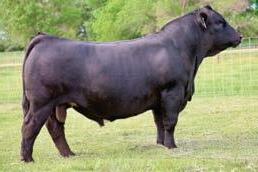


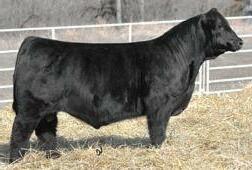






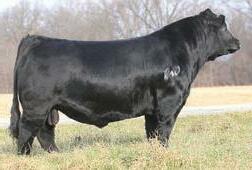
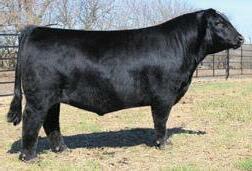
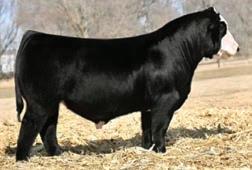






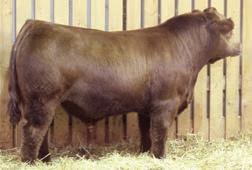
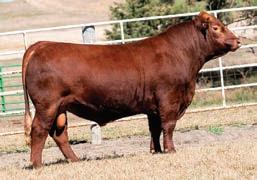







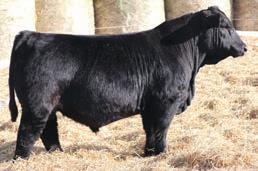


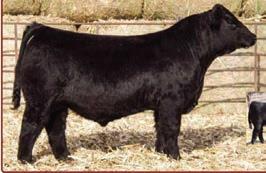









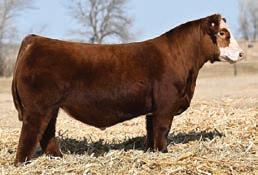


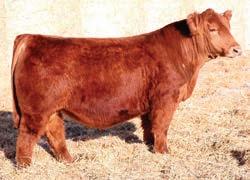



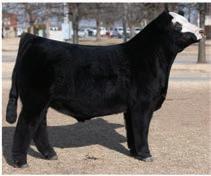

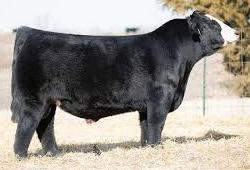


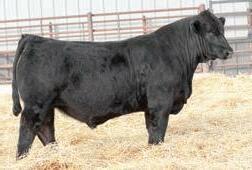


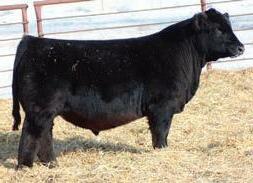


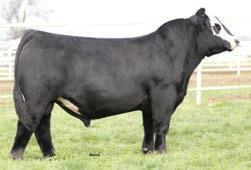


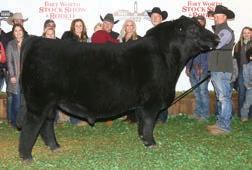


The Community Redevelopment Authority of North Platte, Nebraska, approved a contract paving the way for the Sustainable Beef packing plant project to move forward, according to a report in the North Platte Bulletin.
The contract includes a $21.5 million tax increment finance bond and requires Sustainable Beef to invest at least $300 million in the plant, hire employees legally, meet standards for odor control, and pay for street improvements and water lines, among other conditions, the report said.
Lincoln County commissioners app roved the hauling of soil and sand from two locations to the construction site, ahead of a groundbreaking ceremony for the plant tentatively set for early October, the article said. Nebraska Governor Pete Ricketts, US Senator Deb Fischer, and US Representative Adrian Smith are expected to attend the event.
Retail giant Walmart is a minority investor in the rancherowned Sustainable Beef plant, which is expected to open by late 2024, create 800 jobs, and have the capacity to process 1,500 animals per day.
Vytelle is progressing on a five-year plan, initiated at the conclusion of their Series A funding to provide accessible hormone-free bovine in-vitro fertilization (IVF) to producers across the globe. Part of the five-year plan included doubling the laboratory capacity to produce bovine embryos through in-vitro fertilization. Announced in October, Vytelle is opening a laboratory in Hamilton, New Zealand.
Vytelle’s integrated technology platform combines Vytelle ADVANCE, a breakthrough in-vitro fertilization technology, with Vytelle SENSE, an animal performance data capture system, and Vytelle INSIGHT, an artificial-intelligence-based genetic analytics engine. The platform provides progressive cattle producers the technology to make reliable data-driven mating decisions that imp rove the predictability of genetic progress replicating the right genetics faster.
The New Zealand-based laboratory will utilize Vytelle’s modern hormone-free in-vitro fertilization process including their proprietary media — developed in-house — that results in high-quality embryos for producers to implant fresh or frozen into recipient cows.
The New Zealand-based team is serving beef and dairy producers with on-farm ovum pick-ups.
Qualified donors can be open, 15 days post-calving, or up to approximately 100 days pregnant. Heifers as young as six months of age are also eligible.

The Vytelle process is the most accessible, reliable, and predictable IVF process available. Livestock producers can follow the steps below to begin hormone-free IVF.
1. Livestock producers are encouraged to contact Vytelle to discuss their reproduction program and schedule an onfarm ovum pick-up.
2. Next, select elite donors for collection.
3. A specialized Vytelle technician will come to the farm to collect oocytes.
4. Then, determine an implantation method. Vytelle can deliver fresh or frozen embryos.
5. Finally, the producer will receive a simple invoice only for the Grade 1 embryos produced. As an added benefit, donors used for IVF remain in the conventional breeding cycle for a natural calf.
Out of $2.8 billion that USDA has promised to invest in projects dedicated to developing climate-smart commodities, nearly $500 million is earmarked for projects that involve meat processors.
The biggest single investment involving a meat processor is a $60 million grant for “Tyson Foods, Inc., Climate-Smart Commodities Project.” The project is dedicated to expanding “climate-smart markets” as well as increasing carbon sequestration and reducing emissions in the production of beef and row crops for livestock feed. The lead partner on the project is Tyson Foods, Inc.; among the other partners are Where Food Comes From and Iowa Select.
Another $20 million is intended for the National Pork Board’s “Advancing US Pork Sustainability and Market Value Proposal,” with the goal of increasing the sustainability of US pork products by advancing climate-smart agriculture practices within the feed supply.
Other projects and their grant funds are:
n Farmers for Soil Health Climate-Smart Commodities Partnership, including the National Pork Board — as a member of Farmers for Soil Health — as a partner. Amount: up to $95 million.
n Midwest Climate-Smart Commodity Program, including JBS as a partner. Amount: up to $95 million.
n Climate SMART (Scaling Mechanisms for Agriculture’s Regenerative Transformation), including Butcher Box and Perdue among its partners. Amount: up to $90 million.
n Horizon II: A Climate-Smart Future for Corn, Soybean, Livestock, and Renewable Natural Gas Production, including Smithfield Foods as a partner. Amount: up to $80 million.
n Connected Ag Climate-Smart Commodities Pilot Project, including National Pork Board as a partner. Amount: up to $40 million.
n Climate-Smart Grasslands: The Root of Agricultural Carbon Markets, including Tyson Foods, Inc.; JBS; National Cattlemen’s Beef Association; and US Roundtable for Sustainable Beef as partners. Amount: up to $30 million.
n An Integrated Approach to Scaling-Up Climate-Smart Practices for Crop, Livestock, and Agroforestry Production, including Missouri Prime Beef Packers as a partner. Amount: up to $25 million.
n Fischer Farms Ultimate Beef Strategy, with a funding ceiling of about $15 million.
n Low Carbon Beef USDA Pilot Program: A Fully Integrated Lifecycle Approach to Reduce GHG Emissions from Beef Cattle at Commercial Scale, with Missouri Prime Beef Packers and Where Food Comes From partners. Amount: up to $10 million. n

You enter the data, work through any errors, pay the fees; registration will be completed in minutes. No priority handling fee, no hold-ups (unless there are errors or payment is needed), and can be completed any time of the day or night.
Interesting fact: 90.8% of the animal data is already submitted electronically through Herdbook Services!
Why the encouragement to go online and register the animal yourself?
1. Avoid priority registration fee charges ($50.00 per animal) by logging in online and completing the registration or transfer yourself. *Priority is within two business days.
2. Special mailing by FedEx or UPS needed? Send an email to mailout@simmgene.com with the job/invoice number, physical address, and desired mailing method.
Note: there is a handling fee of $50.00 plus FedEx or UPS shipping charges. Remember to supply a physical address. Plan ahead and avoid these charges.
Need more encouragement to register online?
1. Data Registration/Processing Services: Applications submitted to ASA for processing/registration may take 3–7 business days (error-free and payment received) depending on the time of year. Any holiday season will extend the turnaround time.
2. Mailing services: Data and registration certificates will be mailed (US Post) normally within 5–7 business after processing has completed.
The Customer Service Specialists are just a phone call away to assist you.
1. There are peak times and days when there are large volumes of calls, especially close to deadlines. Don’t get caught waiting until the last minute; submit early.
2. If you are unable to get through, please leave a voicemail. Our goal is to return calls as soon as possible, normally within 3–4 hours.
3. If your question can be answered by email, send an email to:
simmental@simmgene.com for general questions or priority handling
dna@simmgene.com for DNA questions or kit requests the@simmgene.com for Total Herd Enrollment (THE)
members@simmgene.com to apply for membership or, account changes, or annual service fee questions carcdata@simmgene.com for Carcass Merit Program (CMP) and Carcass Expansion project.
ultrasound@simmgene.com for ultrasound and barn sheets
To help you plan, here are some items that may hold up registration for a length of time:
/ ET Requirements: DNA Testing is a standard process without any options to expedite this service.
a. Normal DNA Testing: 5–9 weeks for results. Sample failure and misidentified samples doubles this time.
b. DNA kit paperwork requests: 48-hour turnaround.
Total Herd Enrollment breeders: there is a deadline each year that the previous year’s calf data must be submitted. You’ll be notified of the dams in your herd that need calf data or a reason the cow didn’t calve when you go online to submit new registrations. Until this information is completed, no new data will be accepted.
3. Foundation Registration: Sires registered with other breed associations MUST be registered with ASA prior to registering progeny. Other breed dams may be registered with ASA as a Foundation, but it is optional, not mandatory. Normal processing is 10–12 business days (errorfree, payment received, DNA requirements completed).




If the owner of the dam at the time of conception is different than the person applying for registration, ASA requires the breeder to sign off on the calf you are registering. Make sure the breeder signs the calf’s registration application, or breeding information is supplied on the transfer of the dam. If the dam was sold with the calf at side, make sure the seller has registered and transferred the calf to you.
5. Non-payment: Payment is required to complete registrations.

ASA offers priority handling services if you are unable to complete your registration online. If the data is error-free and payment is received, normal turnaround time for registration is within two business days. There is a priority handling processing fee $50 per animal. Regular US Mail service is at no charge; however, other mailing services (i.e., FedEx, UPS, or Express Mail) will incur additional charges.






17, 2022 • Emmons, MN
Auctioneers: Dustin Carter, SD; and Kevin Swanson, MN. Sale Manager: Eberspacher Enterprises (EE), MN.
Marketing Representatives: Val Eberspacher (EE); Andrew Swanson, Special Assignment; Jared Ruter, Lee Agri-Media; Eric Lee, Livestock Plus; and Amanda Hilbrands, LiveAuctions.TV.
$16,250 – Cow/Calf Pair, “ASF Forget Me Not F4,” s. by Hook`s Bounty 6B, bred to RSF Bulletproof B42; Bull Calf, “ASF Kingpin K7,” s. by RFS Bulletproof B42, both sold to Loomis Simmentals, Council Grove, KS.
$10,750 – Cow/Calf Pair, “ASF Xuberant X19,” s. by STF Tyrell T761, bred to Oaklawn Flint, sold to Kallie Hill, Princeton; Heifer Calf, “ASF Kashmere K2,” s. by Wolfe War Hero, sold to Malakowsky Family DNA Simmentals, Hartland.
$9,850 – Cow/Calf Pair, “ASF Cream Puff C24,” s. by Hook`s Yukon 80Y, bred to Oaklawn Flint, sold to Thesing Riverside Ranch, Carlos; Bull Calf, “ASF Kazam K3,” s. by Oaklawn Flint, sold to Justin Vangenderen, Powersville, MO.
$9,750 – Cow/Calf Pair, “ASF Glisten G12,” s. by CCR Cowboy Cut, bred to Oaklawn Flint; Heifer Calf, “ASF Krissy K12,” s. by HSF Playboy F811, both sold to K&B Cattle Co., Kankakee, IL.
$9,750 – Cow/Calf Pair, “ASF Hobbie Ann H1,” s. by RFS Bulletproof B42, bred to Bar CK Red Empire 9153G, sold to Bill Sloup, Staplehurst, NE; Heifer Calf, “ASF Kibbi Ann K6,” s. by KBHR Sniper E036, sold to Austin Bauer, Kenyon.
$9,200 – Cow/Calf Pair, “ASF Godess G5,” s. by Hook`s Bounty 6B, bred to Bar CK Red Empire, sold to Mike Wibholm, Dows, IA; Bull Calf, “ASF Keystone K13,” s. by Oaklawn Flint, sold to Austin Bauer, Kenyon.
$9,000 – Cow/Calf Pair, “ASF Freckles F6,” s. by Hook`s Xpectation 36X, bred to RFS Bulletproof B42, sold to Bill Sloup, Staplehurst, NE; Bull Calf, “ASF Kujo K8,” s. by Oaklawn Flint, sold to Hoffman Haven Farms, Waseca.
$9,000 – Cow/Calf Pair, “ASF Xtra Daze X3,” s. by SAS T101 Sweet Meat, bred to Hook`s Bounty 6B; Heifer Calf, “ASF Klassy Daze K23,” s. by HSF Play Boy F811, both sold to Carl Yost, Albert Lea.
$6,000 – Bred Female, “ASF Jellyroll J14,” s. by Wolfe War Hero F6, bred to KBHR Sniper E036, sold to Steere Farms, Clarksville, IA.
September 17, 2022 • Roland, OK No. Category Average
4 Bred Cows $4,675 5 Pairs $5,770 18 Bred Heifers $7,110 2 Open Donors $29,100 26 Open Heifers $3,727 5 Flushes $2,020 16 Embryos $425 265 Straws of Semen $264
$55,000 – Open Donor, “Willow Oaks Cosima,” cons. by Faulkner Fleckvieh, AR; sold to Double Bar D Farms, SK; and Logland Farms, OK.
$16,000 – Bred Heifer, “Willow Oaks Hanna,” cons. by Willow Oaks Farms, AR; sold to Double Bar D Farms, SK.
$13,500 – Bred Heifer, “Rugged R Blossom 1042J,” cons. by Rugged R Cattle Co., LA; sold to Vincent Rodrique, QB.
$13,000 – Bred Heifer, “Logland Tula 111K,” cons. by Logland Farms, OK; sold to Beechinor Bros., AB.
$8,700 – Open Heifer, “FLC Jewel J17,” cons. by Ford Land and Cattle, OK; sold to Landon Ohlde, KS.
Comments: Cattle sold into 16 states: AL, AR, CT, IA, IL, IN, KS, LA, MO, MS, NC, ND, OK, PA, TN, and TX; and three Canadian provinces: AB, QB, and SK.
September 18, 2022 • Shelbyville, IL No. Category Average 66 Female, Embryo and Steer Lots $4,589



Auctioneer: Duane Stephens, West Salem.
Sale Consultants: Roger Allen, Larry Martin, Greg Miller, Doug Parke, Drew Hatmaker, Ryan Haefner, Adam Swigart, Brandon Rutledge, Emily Ivey, and David Guyer.
Ringmen: Dan Naughton, Austin Rincker, Zach Rincker, and Rob Neikirk. Representing ASA: Brian DeFreese.
$8,900 – Donor, “HPF Right To Love B320,” s. by Cowboy Cut, cons. by Hillstown Farms, Marissa, sold to Clear Water Simmentals, Milan, IN.
$10,100 – Heifer Calf, “RS/BR Hairietta 756K,” s. by KCC1 Exclusive, cons. by Rincker Simmentals, sold to Hillstown Farms, Marissa.
$7,700 – Heifer Calf, “RS Dixie Pride 172K,” s. by Copacetic, cons. by Rincker Simmentals, sold to Mark Ratliff, Mason City.
$7,300 – Heifer Calf, “FC To Cry Sandy,” s. by Ruby`s Battle Cry 891F, cons. by Fox Creek Cattle, sold to Mike Engelbrecht, Hermann, MO.

$6,600 – Pregnancy out of “HILB Price of Starin,” s. by STCC Tecumseh 058J, sold to Brad Behymer, Mt. Sterling.
$5,800 – Heifer Calf, “TF4 Roberta K35,” s. by W/C Relentless, cons. by Travis Farms, sold to Kadyn Kuhn, Olney.
$5,200 – Bred Heifer, “JLR Burn It Up 017J,” s. by Executive Order, cons. by Russell Land and Cattle, sold to Deken Kemme, Mason.
$5,200 – Pregnancy out of “HPF Right To Love B320,” s. by Double Up, sold to Brad Behymer, Mt. Sterling.
Comments: Cattle sold into 15 states and the sale was broadcast with live bidding from CCI.LIVE.

Gale VanAernam, pictured with family, receiving the ISA Family of the Year award.

The Iowa Simmental Association (ISA) awarded Gale VanAernam and family with the ISA Family of the Year award during the Iowa State Fair. VanAernam began farming in the 1960s alongside his father and brothers east of Exira, Iowa. In 1979 they purchased a Simmental heifer from Mike McDermott, who ran one of the top Simmental herds in the state. This one heifer grew to 180 head of purebred registered Simmental females, and they sold seedstock, feeder calves, and semen. The VanAernam family has been a prominent part of many state agricultural organizations and youth programs. VanAernam served the ISA on the board of directors, and as president. n

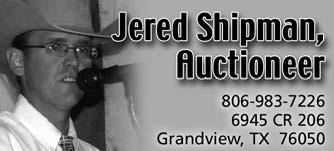


P.O.
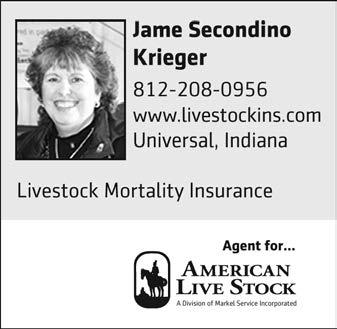
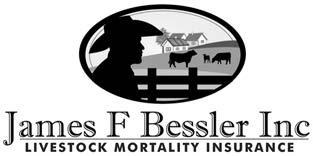
1. What term describes a group of calves of the same sex, within 90 days of the same age, that have been managed in the same manner?
2. With regard to forage use, what do the letters A. U. M. indicate?
3.Who was the only person ever to serve two consecutive terms as ASA President/Board Chairman?
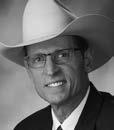
4. From what country does the Simmental strain known as Montbeliard originate?
5. What is the principle reason for branding cattle?

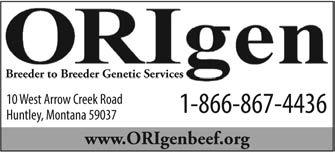
6. Within two hours, how long after standing heat does ovulation occur?
7. “Cropping,” “swallow-forks,” and “splits” are identified with which management practice?
8. Define crop aftermath.
9. The science that deals with functions of the body and its organs is known by what term?
In what city is the American Royal Livestock Show held? n

Texas
• 817-562-8981
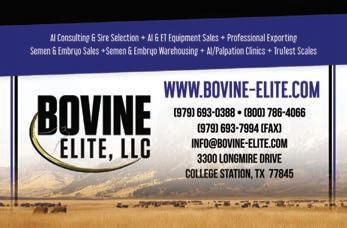
:
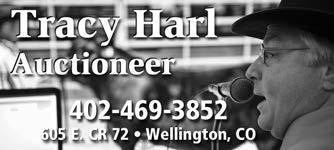

Date: August 24, 2022
Location: Bray, TN
Judges: Steve McGill, Iva, SC (Junior Show); Garrett Knebel, Bozeman, MT (Open Show)
“4WC Watts Candy 11J,” s. by DMCC Hitman 116G, exh. by Connor Watts, Kingsport.
“CTFM Beautiful 409K,” s. by JSUl Something About Mary 8421, exh. by Grayce Hunigan, Blountville.
Grand Champion and Senior Champion
“4WC Watts Candy,” s. by HILB Oracle C033R, exh. by Carson Watts, Kingsport.
Reserve Grand Champion and Reserve Senior Champion
“SPL TickTok H212,” s. by WLE Uno Mas, exh. by Charlie Elsea, Castlewood, VA.
Grand Champion and Junior Champion
“MBF Athena 2J,” s. by DMCC/Wood Fully Loaded, exh. by Samantha Roberts, Athens.
Reserve Grand Champion and Reserve Junior Champion
“CVAF Jewel 1J02,” s. by DMC/Wood Fully Loaded, exh. by Ruby Hunigan, Blountville.
Senior Champion
“MBF Ms Roxanne 21J,” s. by Jass on the Mark 69D, exh. by Samantha Roberts, Athens.
Reserve Senior Champion
“JSUL Primo Dreams 1220J,” s. by Colburn Primo, exh. by Clara Elsea, Castlewood, VA.
Junior Calf Champion
“CTFM Beautiful 409K,” s. by JSUL Something About Mary 8421, exh. by Grayce Hunigan, Blountville.
Reserve Junior Calf Champion
“TX Electra,” s. by Conley GCC Shocker C19, exh. by Charlie Thomas, Winston-Salem, NC.
Grand Champion and Senior Calf Champion
“4WC Watts Candy 11J,” s. by DMCC hitman 116G, exh. by Connor Watts, Kingsport.
Reserve Senior Calf Champion “TX Matilda,” s. by TX Dakota Red, exh. by TX Enterprises, Winston-Salem, NC.
“Faith J20,” s. by GSC GCCO Dew North 102, exh. by Colton Masters, Jonesborough.

“Crisco`s Uno Dream,” s. by Criscos Toe Joe, exh. by Cody Robbins, Johnson City.
Junior Champion
“HST/N/C Onyx Bankroll,” s. by W/C Bankroll 811D, exh. by Grayce Hunigan, Blountville.
Reserve Grand Champion and Senior Champion
“TX Raquel,” s. by LLSF Vantage Point F398, exh. by TX Enterprises, Winston-Salem, NC.
Reserve Senior Champion
“ISSC/TSSC Scarlet Rose,” s. by W/C Bankroll 811D, exh. by Micah Montgomery, Chuckey.
Grand Champion and Junior Calf Champion
“CTFM Country Club,” s. by JSUL Something About Mary 8421, exh. by Courtney Belcher, Abingdon, VA.
Reserve Grand Champion and Senior Calf Champion “TX Rio Lobo,” s. by Felt Last Call 304F, exh. by Charlie Thomas, Winston-Salem, NC.
Breeders Herd exh. by Charlie Thomas, Winston-Salem, NC.
Reserve Grand Champion and Junior Calf Champion
“CTFM Beautiful 609K,” s. by SAV Brilliance, exh. by Courtney Belcher, Abingdon, VA.
Reserve Junior Calf Champion “SHRP DSRK Stare,” s. by PVF Blacklist 7077, exh. by Malachi Musick, Cleveland, VA.
Senior Calf Champion
“CVAF Jewel 1J02,” s. by DMCC/Wood Fully Loaded, exh. by Ruby Hunigan, Blountville.
Reserve Senior Calf Champion “JL Final Elegance J501,” s. by JL Final Exam F98, exh. by Anna Bradley, Jonesborough.
Intermediate Champion
“ESFS Beauties Diamond 02J,” s. by Diamond D Endurance F02, exh. by Addie Harris, Jonesborough.
Grand Champion and Senior Champion
“SHRP Delta Dawn 221J,” s. by PVF Blacklist 7077, exh. by Courtney Belcher, Abingdon, VA.
Reserve Senior Champion
“JSUL Primo Dreams 1220J,” s. by Colburn Primo, exh. by Clara Elsea, Castlewood, VA.
Grand Champion and Junior Calf Champion
“TX Full Disclosure,” s. by W/C Bank On It 273H, exh. by Charlie Thomas, Winston-Salem, NC.
Reserve Grand Champion and Reserve Junior Calf Champion “Fame 200K,” s. by Connealy Black Granite, exh. by Lilly Gray, Chuckey.
Premier Exhibitor
Courtney Belcher, Abingdon, VA.
Date: August 29 (Junior Show) and August 31, 2022 (Open Show)
Location: Pueblo, CO
Judges: Matt Copeland, Nara Visa, NM (Junior Show); Jeff Ward, Laramie, WY (Open Show)

Grand Champion PB SM Female
“KLER/HLL Rain Marie J33,” s. by Profit, exh. by Easton Hill, Nunn.
Reserve Grand Champion
PB SM Female
“Helmfarms Lil Mary 244J,” s. by JSUL Something About Mary 8421, exh. by Lear Hansen, Burlington.
Grand Champion
Percentage SM Female
“R/C Jamaica 326Y,” s. by HPF Quantum Leap Z952, exh. by Jaxon Walker, Greeley.
Percentage SM Female
“Sweet Pea,” s. by W/C Relentless 32C, exh. by Jaycob Cogburn, LaSalle.
Multi-Breed Champion and Grand Champion PB SM Female
“KLER/HLL Rain Marie J33,” s. by Profit, exh. by Easton Hill, Nunn.
PB SM Female
“JPV Miss Jasmine 38J,” s. by CNS Pays To Dream T759, exh. by Jason Dias, Fort Morgan.
Grand Champion
Percentage SM Female
“Lees Dixie Erica 1299,” s. by KCC1 Folsom 512F, exh. by Easton Hill, Nunn.
Date: September 2–17, 2022
Location: Abilene
Judges: Emory Geye, Rising Star (Simmental); and Cody Lucherk, Canyon (Simbrah)
“MTZ Lady Jackie J2102,” s. by JBSF Berwick 41F, exh. by Madison Moseley, Early.
“MEGS Believin 116J,” s. by HPF Quantum Leap Z952, exh. by Madison Moseley, Early.
“MTZ Lady Jewel J2101,” s. by JBSF Berwick 41F, exh. by MaKenzie DeBerry, Olton.
“Moores Remedy Playmate,” s. by SO Remedy 7F, exh. by Anna White, Grandview.
MaKenzie DeBerry, Olton.
Senior Champion Kilye Winge, Cisco.
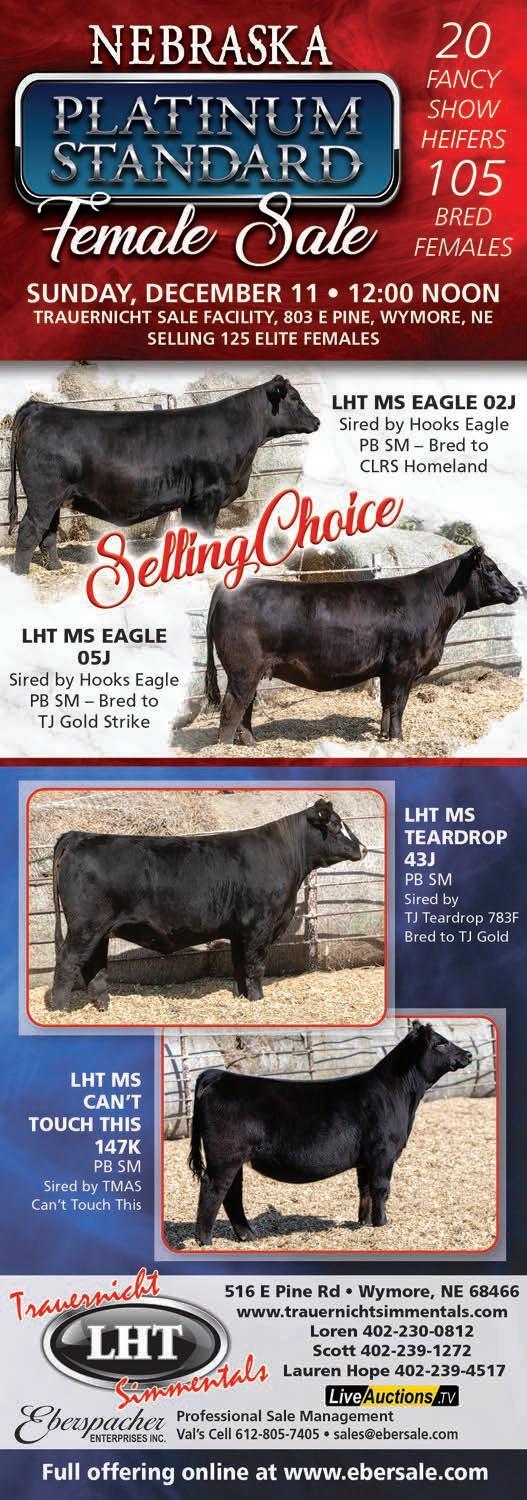
Calf Champion

“BLCO Katie,” s. by LMC MT Transformer 5E/32, exh. by Codie Hill, Edinburg.
Junior Champion
“BLCO Savage,” s. by Smith RFI Black Sails, exh. by Codie Hill, Edinburg.

Grand Champion and Senior Champion
“TSC Jewel,”
s. by RSUN Cowboy Casanova, exh. by Ryleigh Whitaker, Ranger.

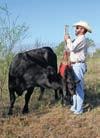
Reserve Grand Champion and Reserve Senior Champion
“RFI Red Velvet 30J,” s. by Smith Satisfies, exh. by Codie Hill, Edinburg.


Junior Champion Codie Hill, Edinburg.
Senior Champion Ryleigh Whitaker, Ranger. n
Phoines Pastoral Co 140 Phoines Rd Carapook Victoria, 3312 Australia
Rancho Santa Isabel 7 Av. 4-96 Z.1 Chiquimula 20001 Guatemala
Lance Halford 255 Brushy Rd Batesville, AR 72501
Cody Strode 4962 Hessel Rd Sebastopol, CA 95472
New Beginnings Farm 142 Millbrook Rd Colebrook, CT 6021
Felipe Soto Jr 4275 NW 16th Ave Okeechobee, FL 34972
Matthew Heiller 300 Walnut St 108 Des Moines, IA 50309
Bookman Cattle 3388 U Ave Wellman, IA 52356
Lyle Saunders 2345 Nelson Ave Independence, IA 50644
N/C Cattle Co 3296 March Ave Orchard, IA 50460
Ryan Mesch Cattle Co 25927 V Ave Eldora, IA 50627
Baldy Acres Cattle Company 32567 160th Street Clarksville, IA 50619
Devon White 22600 N 2000th Rd Bushnell, IL 61422
Goetz Family Farms 202 Rigg Rd Valparaiso, IN 46383
606 Ohio Rd Richmond, KS 66080
AM Livestock 23875 NW 2350th Rd Richmond, KS 66080
Corey Viar 909 Jonathon Council Grove, KS 66846
Meece Cattle 1328 Pattyridge Rd Dunnville, KY 42528
4-D Angus Farms 842 Carter Creek Rd Greenville, KY 42345
Wright Family Cattle 1722 Green Glade Rd Swanton, MD 21561
Lyndon Gerdts 3636 250th Ave Waldorf, MN 56091
J2 Farms 41639 Jivaro St NW Ogilvie, MN 56358
ESNC Cattle Company 43174 120th St Mabel, MN 55954
Campbell/Ward Livestock LLC 62786 Omaha Rd Green City, MO 63545
Ryan Belgum 15677 S 59th St Roca, NE 68430
Pings Blue River Simmental 57755 Hwy 8 Steele City, NE 68440
Sherbeck Farm 2223 Cemetery Rd Ansley, NE 68814
Alex Norz 148 S Branch Rd Hillsborough, NJ 8844
Kingdon Family Farm 6875 Ellicott Street Rd Pavilion, NY 14525
R Cattle Company
1097 Stephens Rd West Manchester, OH 45382
Hannah Topmiller 9111 SR 28
Pleasant Plain, OH 45162
Trademark Genetics LLC 555 Gravel Bank Rd Marietta, OH 45750

Legacy Cattle 4215 SR 41 Manchester, OH 45144 Brooks Schmidlin 1840 Flint Ridge Rd Hopewell, OH 43746
Brady Harmon 1265 Kirkpatrick Ln Stockpoet, OH 43787
Heather Noss 2651 Bald Hill Road Zanesville, OH 43701
Dusty and Jan Biehler 5130 E 700 Rd Loyal, OK 73756
Matthew Robison 237 Claylick Rd Holbrook, PA 15341
Ammons Cattle Farm 3434 Highway 701 S Conway, SC 29527
Tonya Moe 2502 N Lammers Ct Tea, SD 57064
C- Cattle Company 8310 Rodger Rd Corryton, TN 37721
Cooksey & Cooksey Farms 155 Frank Elder Ln Byrdstown, TN 38549
J and J Farming 165 Cheairs Cove Grand Junction, TN 38039
Gary Lynn Taylor 304 Lebanon Rd Kingsport, TN 37663
Garza Family Simbrahs 620 N Flores Rio Grande City, TX 78582
Garrett Clark 93 CR 33990
Powderly, TX 75473
Triple B Simmentals
1849 Rainscounty Rd 2420 Alba, TX 75410
Jerry Harrell 1432 CR 406
Gainesville, TX 76240
Wayne Hinton 110A Southwood Forest Rd Huntsville, TX 77340
Smith & WLE PO Box 330 Giddings, TX 78942
1940 Cattle Company 8229 FM 1940 Franklin, TX 77856
Hurst Cattle Company PO Box 241 Friona, TX 79035
William Sidwell 3745 Kuykendall Bellville, TX 77418
Smith & Marshall PO Box 330 Giddings, TX 78942
Albrecht Legacy Cattle PO Box 167 Minersville, UT 84752
Graves Family Cattle PO Box 1662 Oak Harbor, WA 98277
Greg Logterman N13453 McCune Rd Fairchild, WI 54741
Micah Reimer S4271 Excelsior Dr Rock Springs, WI 53961
KNN Farms W5137 290th Ave Bay City, WI 54723
Joshua Ott 1092 Wiltshire Rd Kearneysville, WV 25430
Big Country Genetics 46 Slippers Ln Cody, WY 82414 n
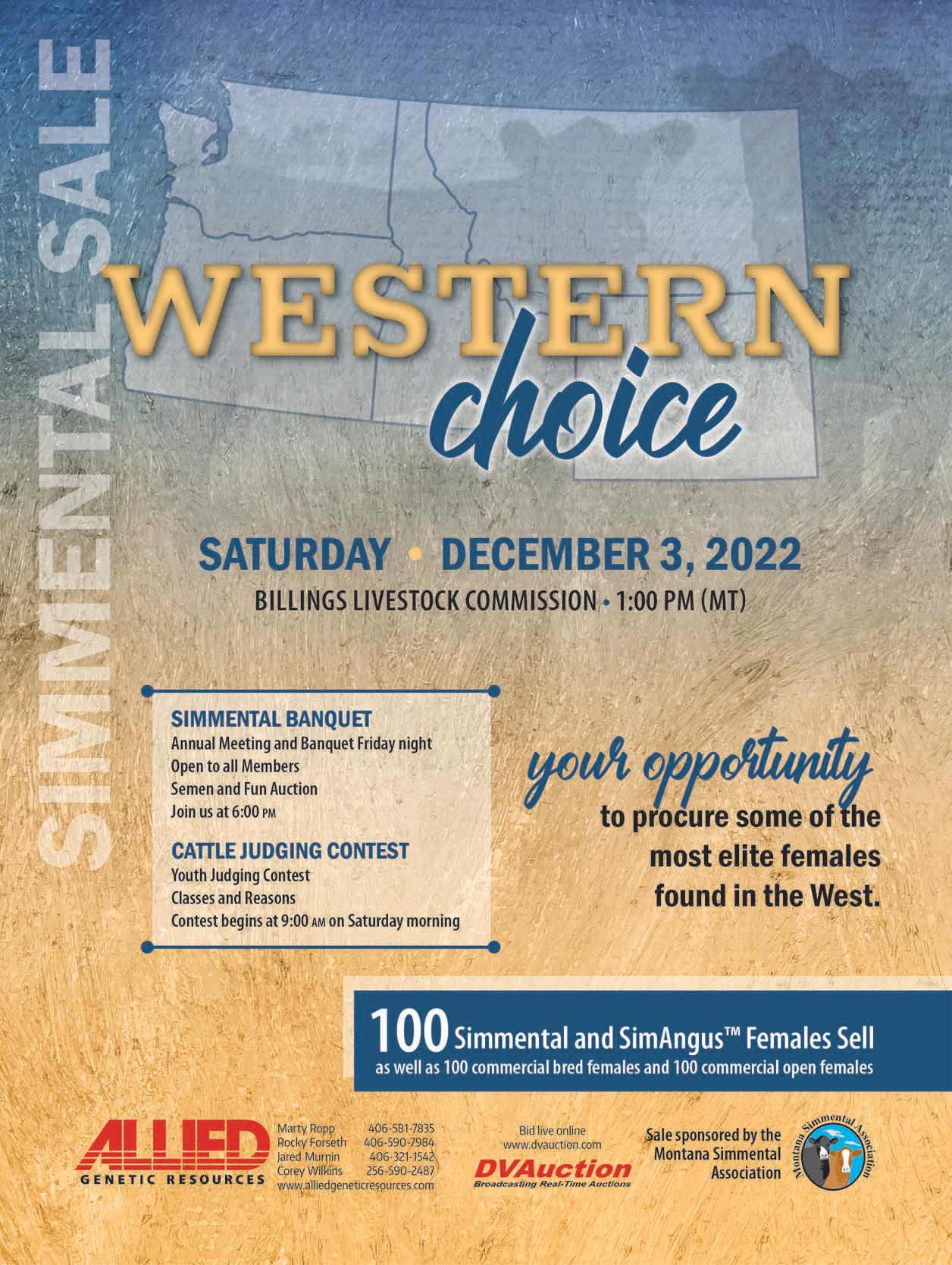

Genetic Conditions Panel. . . . . . . . . . . . . . . . $25
(Must run with GGP-100K)
. . . . . . . . . . . . . . . . . . . . . . . . . . . . . . . $33
Stand Alone Add-on
SNP Parental Verification . . . . . . . . . . . . . . . $18 Free
STR Parental Verification. . . . . . . . . . . . . . . . . $33 $15
Coat Color. . . . . . . . . . . . . . . . . . . . .
BVD
Arthogryposis Multiplex (AM)
Neuropathic Hydrocephalus (NH) Developmental Duplication (DD)
Tibial Hemimelia (TH)
Pulmonary Hypoplasia with Anasarca (PHA) Osteopetrosis (OS)
Contractural Arachnodactyly (CA)
defect tests can be ordered for $25.)
are
enrollment
through June 15,
August 15,
A re-enrollment fee of $35.00 applies to any dam that is removed from inventory and re-enters the herd at a later date.
A member who has dropped out of THE and wishes to return, may do so for the next enrollment season. Re-enrollment fee is $35 per animal (maximum of $350) plus enrollment fees. Non-THE registration fees will apply to the calendar year when a member did not participate in THE.
Non-THE

1–7 Boyle Ranch’s Fleckvieh Female Sale — Washta, IA
5 26th Annual Southern Showcase Sale — Armuchee, GA
5 Cason’s Pride and Joy Elite Female Sale — Russell, IA
5 Dakota Ladies Sale, Worthing, SD
5 Irvine Ranch’s 18th Annual Production Sale — Manhattan, KS
5 Missouri Simmental Association’s “Fall Harvest” Sale — Springfield, MO
5 Moser Ranch’s Annual Bull Sale — Wheaton, KS
6 Triangle J Ranch’s Female Sale — Miller, NE (pg. 38)
7 Hanel Black Simmentals’ Annual Female Sale — Courtland, KS
12 Gibbs Farms’ 17th Annual Bull and Replacement Female Sale — Ranburne, AL
15 Elliott Livestock and Wild Rose Cattle Company’s Bull and Bred Heifer Sale — Clifford, ND (pg. 71)
15 Rainbow River Online Production Sale, Vol. 3 – www.rainbowriversimmentals.com
18 Hilltop Simmentals Female Sale – CCI.Live

19 11th Annual Strickland-Driggers Bull Sale — Glennville, GA
19 Callaway Cattle Company’s AFFORDABULL SALE, Hogansville — GA
19 Next Step Cattle Co.’s 10th Annual “Boot Brand” Genetics Bull Sale — Livingston, AL
19 Stanley Martins Farms’ Fleckvieh Female Sale — Decorah, IA (pg. 7)
19 Yardley Cattle Company’s Focus on the Female Sale — Beaver, UT
20 49th Annual MSA Simmental Sale — Cannon Falls, MN
21 Bichler Simmentals’ 18th Annual Production Sale — Linton, ND
26 Great Lakes Beef Connection Female Sale — Clare, MI
26 The Event, Vol. III, at Tucker Cattle Company — Pleasant Dale, NE (pg. 61)
26 Nolan and Bagby Performance Cattle’s Breeding for the Future Bull and Female Sale — Rockfield, KY
26 Stavick Simmental’s 2nd Annual Queen of the Prairie Female Sale — Veblen, SD
26 Trennepohl Farms’ Right By Design Sale — Middletown, IN (pg. 73)
2–4 Hoosier Beef Congress Sale — Indianapolis, IN
3 Jewels of the Northland — Clara City, MN (pg. BC)
3 Schaake Farms’ Legends of the Flint Hills Sale — Westmoreland, KS (pg. 49)
3 T-Heart Ranch’s Fall Female Sale — La Garita, CO
3 Tom Brothers’ Private Treaty Sale (Opening Day) — Campbellton, TX
3 Western Choice Simmental Sale — Billings, MT (pg. 65)

7 Double Bar D and Friends “Sharing the Herd” Female Sale — Grenfell, SK (pg. 67)
10 NDSA Classic Simmental Sale — Mandan, ND (pgs. 6, 47)
10 North Alabama Bull Evaluation Sale — Cullman, AL
10 The Program Female Sale — Wyoming, IL
10 Sandeen Genetics’ Buildin’ A Brand Production Sale — Blakesburg, IA (pg. 9)
10 Tylertown Simmentals’ Inaugural Sale — Cedar Hill, TN
11 Trauernicht Simmental’s Nebraska Platinum Standard Sale — Beatrice, NE (pg. 63)
12 Franzen Simmentals’ Production Sale — Leigh, NE
16 Buck Creek Ranch’s Grand Event Vol. III — Yale, OK (pg. 5)
17 South Dakota Simmental Source Sale — Mitchell, SD (pg. 15)
8 Bricktown National Simmental Sale — Oklahoma City, OK (pg. 28)
13 Diamond Bar S Bull Sale — Great Falls, MT (pg. 37)
15 The One and Only Sale — Denver, CO (pg. 43)
17 Powerline Genetics’ Bull Sale, — Arapahoe, NE
27 Double J Farms’ 49th Annual Bull and Female — Garretson, SD (pg. 40)
27 Ellingson Simmentals’ Annual Production Sale — Dahlen, ND (pg. 38)
28 J&C Simmentals’ Annual Bull Sale — West Point, NE (pg. 37)
29 Reck Brothers-N-Sons Genetic Advantage Production Sale — Blakesburg, IA
29 Triangle J Ranch’s Annual Bull Sale — Miller, NE (pg. 38)
30 APEX Cattle “Heterosis Headquarters” Annual Bull and Bred Heifer Sale — Dannebrog, NE
1 Begger’s Diamond V Ranch’s Big Sky Genetic Source Bull Sale — Wibaux, MT (pg. 37)
1 Lazy C Diamond Ranch’s Annual Sale — Kintyre, ND
1 Michael Erdmann Angus Production Sale — Aberdeen, SD
2 Stavick Simmental’s Annual Sale — Veblen, SD (pg. 42)
3 Cow Camp Ranch’s Annual Spring Bull Sale — Lost Springs, KS (pg. 36)
3 Kunkel Simmentals’ Annual Bull and Bred Female Sale — New Salem, ND
4 41st Annual Klain Simmental Production Sale — Ruso, ND
4 Blue River Gang’s 38th Annual Production Sale — Rising City, NE
4 Prickly Pear Simmentals’ “Made In Montana” Sale — Helena, MT (pg. 37)
4 Springer Simmental’s Value Based Genetics Sale — Decorah, IA
4 Stockmen’s Source Bull Sale — Wellfleet, NE
6 43rd Annual Gateway “Breeding Value” Bull Sale — Lewistown, MT
6 Long’s Simmentals’ 3rd Annual Production Sale — Creston, IA
7 Koepplin’s Black Simmental’s 35th Annual Bull Sale — Mandan, ND
8 River Creek Farms’ 33rd Annual “Built To Work” SimAngus Bull Sale — Manhattan, KS (pg. 36)
8 Traxinger Simmental’s Annual Bull Sale — Houghton, SD
9 Felt Farms’ Bull Sale — West Point, NE
9 Houck Rock Creek Ranch’s Spring Private Treaty Bull Sale — Allen, KS
9 Lassle Ranch Simmentals’ 30th Annual Bull Sale — Glendive, MT
10 Bata Brothers/Bell Family Annual Joint Simmental Bull and Female Sale — Rugby, ND (pg. 38)
10 Bred For Balance Sale — Starbuck, MN
10 TNT Simmentals’ 38th Annual Bull Sale — Lehr, ND (pg. 38)
11 CK Cattle & Wager Cattle’s 6th Annual Production Sale — Highmore, SD
11 Dixie National Simmental Sale — Jackson, MS
11 Kenner Simmentals’ 27th Annual Production Sale — Leeds, ND
11 RL Fleckvieh Limerock Ranch’s Mature Cow Herd Dispersal — Brandon, IA
11 Rydeen Farms’ 25th Annual “Vision” Sale — Clearbrook, MN
12 Oak Meadow Farms’ 5th Annual Production Sale — Cresco, IA
13 Dakota Power Bull Sale — Hannaford, ND
13 Nelson Livestock Company’s Production Sale — Wibaux, MT
14 Edge of the West Production Sale — Mandan, ND
14 Werning Cattle Company’s 42nd Annual Production Sale — Emery, SD
15 Hart Simmentals’ Beef Builder Bull Sale — Frederick, SD
15 Jackpot Cattle Company’s Bull Sale — Wessington, SD
17 Dakota Xpress Annual Production Sale — Mandan, ND (pg. 38)
17 Mader Ranches’ 34th Annual Bull Power Sale — Carstairs, AB
17 R & R Cattle Company’s Annual Production Sale — Chamberlain, SD
17 Sandy Acres Bull Sale — Neligh, NE (pg. 37)
7P Ranch 29th Annual Spring Bull and Female Sale — Tyler, TX
Flittie Simmental/Schnabel Ranch Simmentals/Lazy J Bar Ranch’s Joint Production Sale — Aberdeen, SD (pg. 42)
18 Yon Family Farms Spring Sale — Ridge Spring, SC
19 K-LER Cattle’s Annual Production Sale — St. Charles, MN (pg. 37)
19 Trauernicht Simmentals’ Bull Sale — Beatrice, NE
20 Bulls of the Big Sky — Billings, MT (pg. 37)
21 Quandt Brothers Cattle Company’s 11th Annual Production Sale — Oakes, ND (pg. 38)
22 C Diamond Simmentals’ Annual Bull and Female Sale — Dawson, ND
Illinois Performance Tested Bull Sale — Springfield, IL
Mid-America Sale — Springfield, IL
Emmons Ranch Sale — Olive, MT
Hofmann Simmental Farms’ “Buy Your Way” Bull Sale — Clay Center, KS
Lehman Family Farm’s Production Sale — Mitchell, SD
1 Hill’s Ranch Simmentals’ Annual Bull Sale — Stanford, MT
Klein Ranch’s Heart of the Herd Sale — Atwood, KS
19th Annual Cattleman’s Kind Bull Sale — San Saba, TX
2 Keller Broken Heart Ranch’s Annual Production Sale — Mandan, ND (pg. 38)
2 Kearns Cattle Company’s 34th Annual Bull Sal — Rushville, NE
3 Eichacker Simmentals’ Annual Bull Sale — Salem, SD (pg. 40)
3 KSU’s Annual Legacy Sale — Manhattan, KS
4 Cason’s Pride and Joy Bull Sale — Russell, IA
Powerline Genetics’ High-Altitude Bull Sale — Castle Dale, UT
Trinity Farms’ Generations of Excellence Sale — Ellensburg, WA (pg. 42)
5 Gold Bullion Group’s 21st Annual Bull Sale — Westmoreland, KS
Windy Creek Cattle Company’s “Profit through Performance” Production Sale — Spencer, SD
6 Hanel’s Black Simmentals’ 5th Annual “Black and White” Bull Sale — Courtland, KS
6 Sweet 16 Online Bull and Female Sale –www.sconlinesales.com
7 Doll Simmental Ranch’s 43rd Annual Production Sale — Mandan, ND
Brink Genetics’ Annual Bull Sale — Elkader, IA
Rainbow River Simmentals’ 8th Annual Online Bull Sale –www.rainbowriversimmentals.com
Carcass Performance Partners Bull and Female Sale — Lucedale, MS
Dikeman and Huninghake Premium Genetics Bull Sale — Frankfort, KS
11 Gonsior Simmentals’ 23rd Annual In The Heartland Sale — Fullerton, NE
14 Schrader Ranch’s 21st Annual Bull Sale — Wells, KS
14 Powerline Genetics March Edition Bull Sale — Arapahoe, NE
3C Christensen Ranch and NLC Simmental Ranch 52nd Annual Production Sale — Wessington, SD (pg. 40)
17 Black Summit Bull Sale — Powell, WY
17 Sunflower Genetics Annual Sale — Maple Hill, KS (pg. 37)
18 Buck Creek Ranch Annual Bull Sale — Yale, OK
18 Dickinson Simmental and Angus Ranch 52nd Annual Production Sale — Gorham, KS (pg. 36)
18 Eastern Spring Classic Sale — Columbus, OH
18 Red Hill Farms’ “More Than a Bull” Sale XVIII — Lafayette, TN
18 Rockin H Simmentals’ Production Sale — Canby, MN
18 Triangle J Ranch and Altenburg Super Baldy Ranch’s Colorado Bull Sale — Fort Collins, CO
Bridle Bit Simmentals’ All Terran Bull Sale — Walsh, CO (pg. 36)
21 Superior Beef Genetics’ 22nd Annual Production Sale — Lamar, MO
Diamond H Ranch’s Annual Production Sale — LaCrosse, KS (pg. 36)
Western Cattle Source’s Annual Production Sale — Crawford, NE
Great Northern Bull and Female Sale — Clear Lake, MN
Clear Choice Bull Sale — Milan, IN (pg. 36)
T Heart Ranch’s High Altitude Bull Sale — La Garita, CO (pg. 36)
Wildberry Farms’ Bull and Bred Heifer Sale — Hanover, IL
Cox Cattle Company’s Spring Private Treaty Sale — Woodbine, KS
Belles and Bulls of the Bluegrass — Lexington, KY
Big Country Genetics Bull Sale — Cody, WY
Henry’s Fork Cattle Company Private Treaty Bulls For Sale — Rexburg, ID
McDonald Farms’ 20th Annual “Pick of the Pen” Bull Sale — Blacksburg, VA
The Gathering at Shoal Creek — Excelsior, MO
Midland Bull Test Sale — Columbus, MT
Hilbrands Cattle Co.’s Passion 4 Perfection Sale — Clara City, MN
Diamonds and Spurs SimGenetic Sale — Bois D’Arc, MO
Pigeon Mountain Simmentals’ “Beef Builder” Spring Bull and Female Sale — Rome, GA
RS&T Simmentals’ Performance and Pounds Sale — Maryville, MO n
Serving as American Simmental Association’s (ASA) official publication, the Register is mailed nine times annually, has a circulation of 5,500+, and is focused primarily on ASA’s paid membership.

the Register is an 81/8 x 107/8 inch glossy, full-color publication that provides a direct and consistent line of communication to the ASA membership.
Nancy Chesterfield
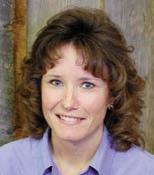
Space Rates Non-Contract
Contract
Contract Four Color
1 page $770 $730 $700 $300 2/3 page $660 $630 $600 $200 1/2 page $440 $420 $400 $150 1/3 page $330 $315 $300 $100
1/4 page $220 $210 $200 $75 1/8 page $150 $50 3-inch mini $100 $30 2-inch mini $85 $15 2-inch card $700/year, 9 insertion $135 1-inch card $390/year, 9 insertions $90 Classified Ads $.60/word, $12.00 minimum, must be prepaid

Dec ’22/Jan ’23 Nov 15 Nov 18 Dec 5 Dec 21
February ’23 Dec 27 Jan 4 Jan 18 Feb 7
March ’23 Feb 1 Feb 10 Feb 17 March 7
April ’23 March 1 March 10 March 17 April 4
May/June ’23 March 31 April 10 April 21 May 9
July/August ’23 June 20 June 23 July 7 July 25 September ’23 August 1 August 10 August 18 Sept 5 October ’23 Sept 1 Sept 8 Sept 20 Oct 3
Send all ad materials to: register@simmgene.com or Fax: 406-587-8853
A non-refundable fee of $50.00 will be assessed if a client does not meet deadlines or if the client commits to advertising and cancels after the deadline or if the ad must be dropped to ensure on time publication.
Advertising materials (including photos) must be in the Register office by the dates listed above. the Register, which mails by periodicals rate, assumes no responsibility for actual receipt date.
Price
Advertising rates are for camera-ready ads only. Additional design charges will apply to any ad that is designed by ASA Publication, Inc.
Every effort will be made to provide proofs on all ads — if all ad material arrive in the Register office prior to the deadline and a correct email address or fax number is provided.
the Register and its staff assume no responsibility or obligation to verify the accuracy and truthfulness of advertising copy submitted to the Register. However, the Register reserves the right to reject any advertising copy or photo which the Register deems unsuitable for publication for any reason, including copy or photographs which are false or misleading.
the Register assumes no responsibility for the accuracy and truthfulness of submitted print ready ads. Advertisers shall indemnify and hold harmless the Register for any claims concerning advertising content as submitted. Advertising containing pedigrees or statements regarding performance must conform to records kept by the American Simmental Association. Copy deviating from official records may be changed as necessary without advertiser consent.
Opinions expressed are the writers’ and not necessarily those of the Register. Photographs are welcome, but no responsibility is assumed for material while in transit or while in the office.
All accounts are due and payable when invoiced. Interest charges of 1.5 percent per month (18 percent APR) will be added to accounts 30 days past due. If an account becomes 60 days delinquent, all ASA Publication, Inc. work may be suspended until full payment is made. After review by the ASA Executive Committee, ASA privileges may be denied to those with accounts over 90 days delinquent.
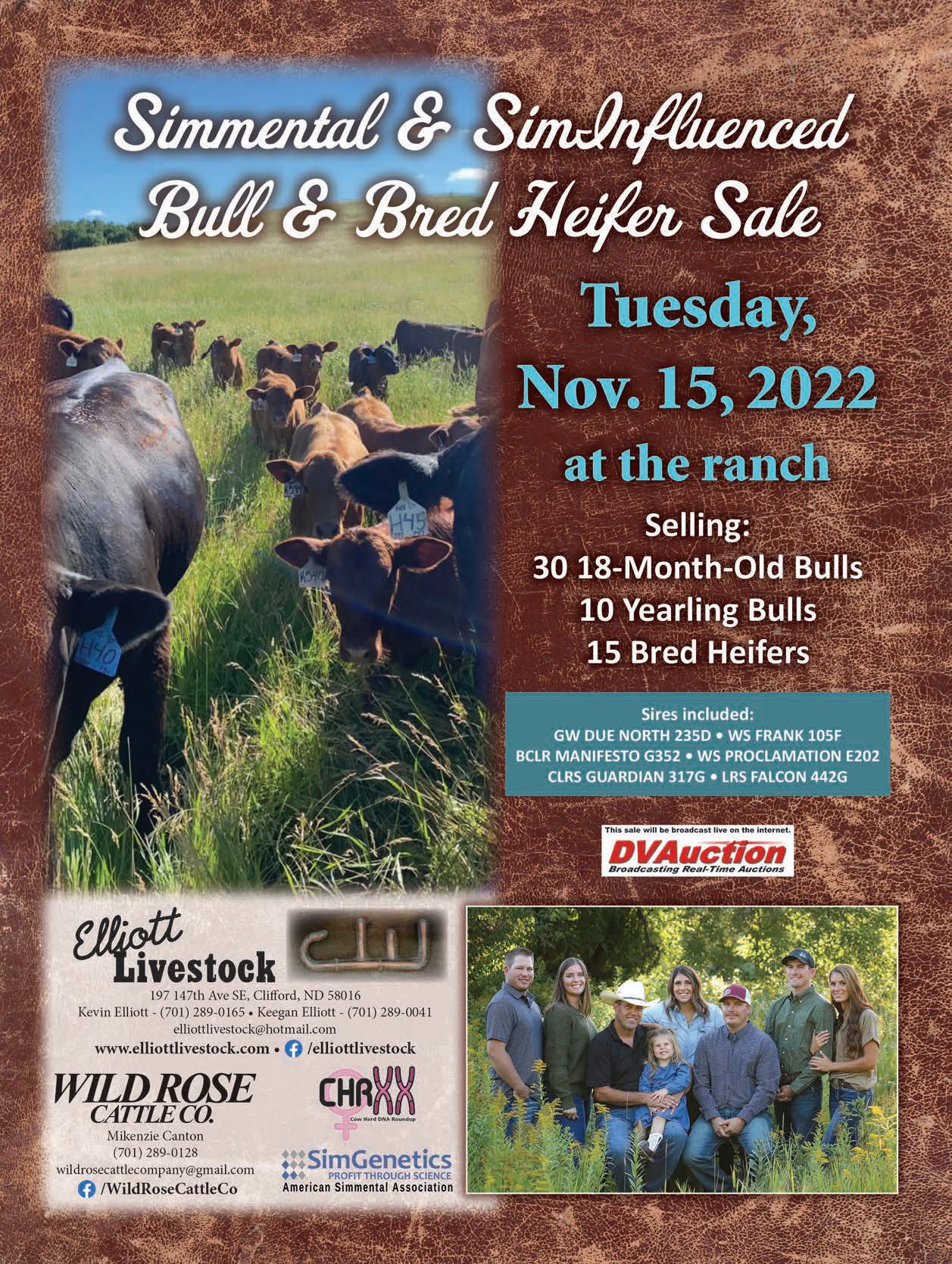
3C Christensen Ranch. . . . . . . . . . . . . 40
ABS® Global. . . . . . . . . . . . . . . . . . . 1, 40
Ag Sale Day. . . . . . . . . . . . . . . . . . . . . 13
All Beef. . . . . . . . . . . . . . . . . . . . . . . . . . 6
All For One. . . . . . . . . . . . . . . . . . . . . . 51
Allied Genetic Resources. . . . . . . . . . . 65
Altenburg Super Baldy Ranch, LLC. . . 36
Altenburg, Willie. . . . . . . . . . . . . . . . . 43
American Junior Simmental Association (AJSA). . . . . . . . . . . Insert
American Live Stock Inc.. . . . . . . . . . . 60
American Royal. . . . . . . . . . . . . . . 16, 17
American Simmental Association. . . IFC, 4, 15, 16, 17, 26, 27, 29, 30, 32, 33, 34, 35, 39, 41, 55, 56, 57, 71
American Simmental-Simbrah Foundation. . . . . . . . . . . . . . . . 28, 43
Anderson Cattle Co.. . . . . . . . . . . . . . BC
ASA Performance Advocate. . . . . 37, 63
ASA Publication, Inc.. . . . . . . . . . . 23, 50
Bar 64 Red Angus LLC. . . . . . . . . . . . . 21
Bata Bros.. . . . . . . . . . . . . . . . . . . . . . . 38
Begger’s Diamond V. . . . . . . . . . . . . . 37
Benda Simmentals, Jim. . . . . . . . . . . . 40
Bessler Inc, James F. . . . . . . . . . . . . . . 60
Best Practices for Seedstock Producers. . . . . . . . . . . . . . . . . 24, 25
Bovine Elite, LLC. . . . . . . . . . . . . . . . . 60
Bridle Bit Simmentals. . . . . . . . . . . . . 36
Brink Fleckvieh. . . . . . . . . . . . . . . . . . . 38
Brush Country Bulls. . . . . . . . . . . . . . . 42
Buck Creek Ranch. . . . . . . . . . . . . . . . . 5
Buildin’ A Brand. . . . . . . . . . . . . . . . . . . 9
Bulls of the Big Sky. . . . . . . . . . . . . . . 37
Business Card Ads. . . . . . . . . . . . . . . . 50
Cable Ranch. . . . . . . . . . . . . . . . . . . . . 40
Calf Crop Genomics (CCG). . . . . . 25, 39
California Breeders. . . . . . . . . . . . . . . 36
Carcass Expansion Project (CXP). . . . . . . . . . . . . . . . . . . . . 25, 26
Carcass Merit Program (CMP). . . . . . . . . 26, 30, 40, 41, 42, 60
Carcass Merit Vital to Your Business?. . 26
Cardinal Cattle Company. . . . . . . . . . 59
Cason’s Pride & Joy Simmentals. . . . . 36
Cattle Visions. . . . . . . 52, 53, 60, 74, IBC
CattleMax Software. . . . . . . . . . . . . . IFC
Cattlemen’s Congress. . . . . 3, 16, 17, 28
CCI.Live. . . . . . . . . . . . . . . . . . . . . . . . . . 5
Check Us Out Online. . . . . . . . . . . . . . . 4
ClearWater Simmentals. . . . . . . . . 28, 36
Colorado Simmental Association. . . . 43
Colorado Simmental Breeders. . . . . . 36
Cow Camp Ranch. . . . . . . . . . . . . . . . 36
Cow Herd DNA Roundup (CHR). . 25, 71
Customer Service Team. . . . . . . . . . . . 35
Dakota Xpress. . . . . . . . . . . . . . . . . . . 38
Dean Galbraith Services (DGS). . . . . . 21
Diamond Bar S. . . . . . . . . . . . . . . . . . . 37
Diamond H Ranch. . . . . . . . . . . . . . . . 36
Dickinson Simmental and Angus Ranch. . . . . . . . . . . . . . 36
Dixson Farms, Inc.. . . . . . . . . . . . . . . . 36
Double Bar D Farms. . . . . . . . . . . . . . 67
Double J Farms. . . . . . . . . . . . . . . . . . 40
DP Sales Management LLC. . . . . . . . . 15
DVAuction. . . . . . . . . . . . 7, 15, 47, 65, 71
Dwyer Cattle Services. . . . . . . . . . . . . . 9
Eastern Regional Classic. . . . . . . . . Insert
Eberspacher Enterprises Inc.. . 61, 63, BC
Ediger Simmental. . . . . . . . . . . . . . . . 37
Eichacker Simmentals. . . . . . . . . . . . . 40
Ekstrum Simmentals. . . . . . . . . . . . . . 40
Ellingson Simmentals. . . . . . . . . . . . . 38
Elliott Livestock. . . . . . . . . . . . . . . . . . . 71
Elm Mound Farms. . . . . . . . . . . . . . . . BC
Event, The. . . . . . . . . . . . . . . . . . . . . . . 61
Feeder Profit Calculcator™ (FPC). . . . . . . . . . . . . . . 36, 40, 42, 57
Ferguson Show Cattle. . . . . . . . . . . 9, 40
Filegonia Cattle Company. . . . . . . . . . 42
Flittie Simmental. . . . . . . . . . . . . . . . . 40
Forster Farms. . . . . . . . . . . . . . . . . . . . 37
Fort Worth Stock Show. . . . . . . . . 16, 17
Four Point Livestock. . . . . . . . . . . . . . . . 3
GENEX™. . . . . . . . . . . . . . . . . . . . . . . . . 3
Grand Event, The. . . . . . . . . . . . . . . . . . 5
Haley Farms. . . . . . . . . . . . . . . . . . . . . 40
Harker Simmentals. . . . . . . . . . . . 36, 61
Harl, Tracy Auction Company. . . . . . . 60
Hart Simmentals. . . . . . . . . . . . . . . . . 40
Hilbrands Cattle Company. . . . . . . . . BC
Hofmann Simmental Farms. . . . . . . . 36 Hotwire. . . . . . . . . . . . . . . . . . . . . . Insert
IGS Multi-breed Genetic Evaluation. . 24 Illinois Simmental Breeders. . . . . . . . 36

Indiana Simmental Breeders. . . . . . . . 36
Innovation AgMarketing, LLC. . . . . . . . 5
International Genetic Solutions (IGS). . . . . . . . . . . . . . . . 36, 40, 42, 51
Iowa Simmental Breeders. . . . . . . . . . 36
J & C Simmentals. . . . . . . . . . . . . . . . . 37
Jacobs, Roger, Auctioneer. . . . . . . . . . 60
Jass Simmentals. . . . . . . . . . . . . . . . . BC
Jensen Simmentals. . . . . . . . . . . . 36, 38
Jewels of the Northland. . . . . . . . . . . BC
Jones Show Cattle. . . . . . . . . . . . . . . . 40
K-LER Cattle. . . . . . . . . . . . . . . . . . . . . 37
Kaelberer Simmentals. . . . . . . . . . . . . 38
Kansas Simmental Breeders. . . . . . . . 36
Keller Broken Heart Ranch. . . . . . . 6, 38
Kenner Simmental Ranch. . . . . . . . . . 47
Kenner Simmentals. . . . . . . . . . . . . . . 38
Kulp Genetics. . . . . . . . . . . . . . . . . . . . 38
Lassle Ranch Simmentals. . . . . . . . . . 37
Legends of the Foothills. . . . . . . . . . . 49
Lehrman Family Simmentals. . . . . . . 40
Little Creek Cattle. . . . . . . . . . . . . . . . . 38
LiveAuctions.TV. . . . . . . . . . . . . . . . . . 63
LiveAuctions.TV20. . . . . . . . . . . . . . . . BC
Livestock Services. . . . . . . . . . . . . . . . 60
Lucas Cattle Company. . . . . . . . . . 37, 68
LZ Farms. . . . . . . . . . . . . . . . . . . . . . . . 61
Martin Farms. . . . . . . . . . . . . . . . . . . . 42
McCune, Kent. . . . . . . . . . . . . . . . . . . . 21
Miller Simmentals. . . . . . . . . . . . . . . . 37
Minnesota Simmental Breeders. . . . . 37 Missing Rail Simmentals. . . . . . . . . . . 40
Missouri Simmental Breeders. . . . . . . 37 Montana Simmental Association. . . . 65 Montana Simmental Breeders. . . . . . 37 Monte Christo Ranch & Investments. . . . . . . . . . . 42
Morrison, Myra Neal. . . . . . . . . . . . . . 38
National Classic. . . . . . . . . . . . . 5, Insert
National Western Stock Show. . 16, 17, 43
Nebraska Platinum Standard. . . . . . . 63
Nebraska Simmental Breeders. . . . . . 37 Neidig Farms. . . . . . . . . . . . . . . . . . . . 61
NLC Simmental Ranch. . . . . . . . . . . . . 40
No Light Weights. . . . . . . . . . . . . . . . . 57
North American Fullblood Breeders. . . . . . . . . . . . . 38
North American International Livestock Exposition. . . . . . . . . . 16, 17
North Carolina Simmental Breeders. . . . . . . . . . . . 38
North Dakota Simmental Association. . . . . . . . . . 47
North Dakota Simmental Breeders. . . 38 North Dakota Simmental Classic. . . 6, 47 Oak Meadow Farms. . . . . . . . . . . . . . 37
Ohio Simmental Breeders. . . . . . . . . . 40
Oklahoma Simmental Breeders. . . . . 40 Online Herdbook. . . . . . . . . . . . . . . . . 55
ORIgen. . . . . . . . . . . . . . . . . . . . . . . . . 60
P & C Farms. . . . . . . . . . . . . . . . . . . . . 61
People’s Choice Power Simmental. . . 43 Perrin, Tyler. . . . . . . . . . . . . . . . . . . . . 61
Pilkington Cattle Co.. . . . . . . . . . . . . . 61
Pine Ridge Ranch, LLC. . . . . . . . . . . 2, 42
PJ Budler, International Sales. . . . . . . 21 PL Livestock. . . . . . . . . . . . . . . . . . . . . 61
Power Plus Cattle Co.. . . . . . . . . . . . . . 21
Powerline Genetics. . . . . . . . . . . . . . . 37
Prickly Pear Simmental Ranch. . . . . . 37 Prime Genetics. . . . . . . . . . . . . . . . . . . 61
PrimeTime AgriMarketing Network. . . . . . 59, 73
Priority Handling Processing Service. . 55 Program, The. . . . . . . . . . . . . . . . . . . . 59
Progress Through Performance (PTP). . . . . . . . . . . . . . . . . . . . . . 16, 17
Quandt Brothers (QBVJT). . . . . . . . . . 38
R&R Cattle Company. . . . . . . . . . . . . . 40
Red River Farms. . . . . . . . . . . . . . . . . . 36
Right By Design. . . . . . . . . . . . . . . . . . 73
Rincker Simmental. . . . . . . . . . . . . . . . 36
Ring of Champions. . . . . . . . . . . . . . . . 17
River Creek Farms. . . . . . . . . . . . . . . . 36
Rolling Hills Farms Simmentals LLC. . 40
Rust Mountain View Ranch. . . . . . . . . 38
Rydeen Farms. . . . . . . . . . . . . . . . . . . . 6
Sales Call. . . . . . . . . . . . . . . . . . . . 40, 60
Sandeen Genetics. . . . . . . . . . . . . . . . . 9
Sandy Acres Simmental. . . . . . . . . . . . 37
Schaake Farms. . . . . . . . . . . . . . . . . . . 49
Schnabel Ranch Simmentals. . . . . . . . 42
Secondino, Krieger, Jame. . . . . . . . . . 60
Sharing The Herd. . . . . . . . . . . . . . . . . 67
Shipman, Jered, Auctioneer. . . . . . . . 60
Shoal Creek Land & Cattle, LLC. . . . . . 37
SimGenetics Profit Through Science. . . 26, 29, 30, 32, 41, 56, 57, 71
Simmentals of Texas. . . . . . . . . . . . . . 38
SimTalk . . . . . . . . . . . . . . . . . . . . . . . . . 23
Sisco Brothers. . . . . . . . . . . . . . . . . . . 61
Sloup Simmentals. . . . . . . . . . . . . . . . 37
South Central Regional Classic. . . Insert
South Dakota Simmental Breeders. . . 40
South Dakota Simmental Source. . . . 15
Springer Simmental. . . . . . . . . . . . . . . 36
Stanley Martins Farms. . . . . . . . . . . . . . 7
Stavick Simmental. . . . . . . . . . . . . . . . 42
Stayability. . . . . . . . . . . . . . . . . . . . . . . 32
Steaks Alive. . . . . . . . . . . . . . . . . . . . . 37
Sunflower Genetics, LLC. . . . . . . . . . . 37
T-Heart Ranch. . . . . . . . . . . . . . . . . . . 36
Tennessee Simmental Breeders. . . . . 42
Texas Simmental & Simbrah Breeders. . . . . . . . . . . . . . . . . . . . . 42
The One and Only. . . . . . . . . . . . . . . . 43
the Register . . . . . . . . . . . . . . . . . . . . . 23
Thesing Riverside Ranch. . . . . . . . . . . BC
TNT Simmental Ranch. . . . . . . . . . . . . 38
Total Herd Enrollment (THE). . . . 25, 27, 29, 33, 34, 36, 37, 38, 40, 42
Trauernicht Simmentals. . . . . . . . . . . 63
Traxinger Simmental. . . . . . . . . . . . . . 42
Trennepohl Farms. . . . . . . . . . . . . 36, 73
Triangle H. . . . . . . . . . . . . . . . . . . . . . . 15
Triangle J Ranch. . . . . . . . . . . . . . . . 6, 38
Trinity Farms. . . . . . . . . . . . . . . . . . . . 42
Triple G Simmental. . . . . . . . . . . . . . . . 9
Triple Z Simmental. . . . . . . . . . . . . . . . 38
Tucker Cattle Company. . . . . . . . . . . . 61
Updyke Simmentals. . . . . . . . . . . . . . 40
VJT Ranch. . . . . . . . . . . . . . . . . . . . . . . 38
Volk Livestock. . . . . . . . . . . . . . . . . 38, 61
Washington Simmental Breeders. . . . 42
Werning Cattle Company. . . . . . . . 9, 42
Western Cattle Source. . . . . . . . . . . . . 38
Western Choice. . . . . . . . . . . . . . . . . . 65
Western Regional Classic. . . . . . . . Insert
Wild Rose Cattle Co.. . . . . . . . . . . . . . . 71
Wildberry Farms. . . . . . . . . . . . . . . . . 36
Wilkinson Farms Simmentals. . . . . . . 38
Williams Land & Cattle Auction Co.. . . 6
Willis Simmentals. . . . . . . . . . . . . . . . 40
Willow Creek Cattle. . . . . . . . . . . . . . . BC
Your Data. Their Future.. . . . . . . . . . . 29 n
